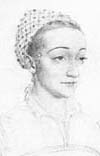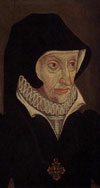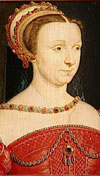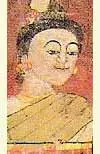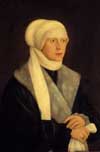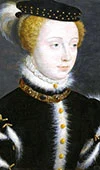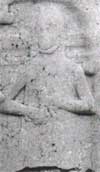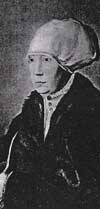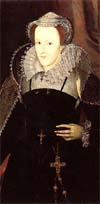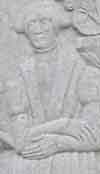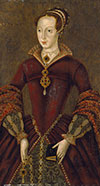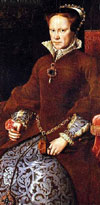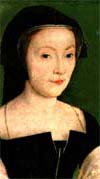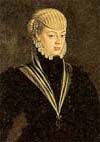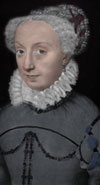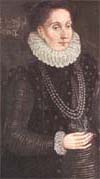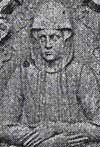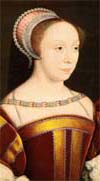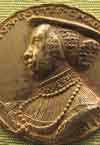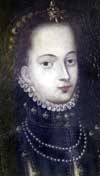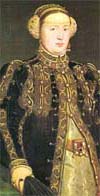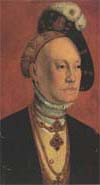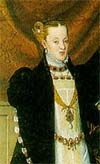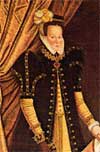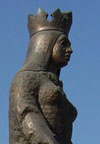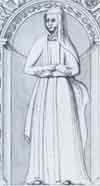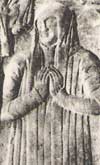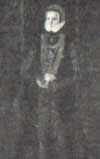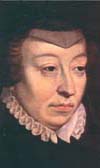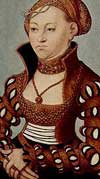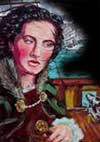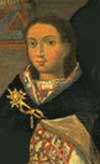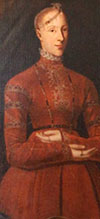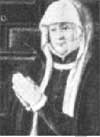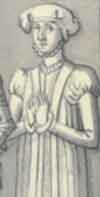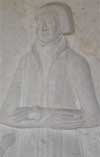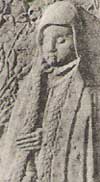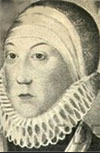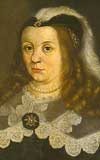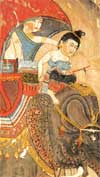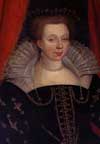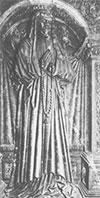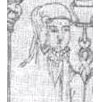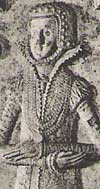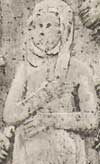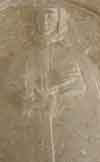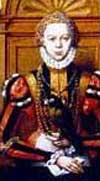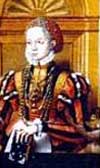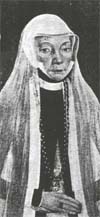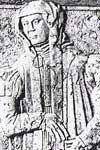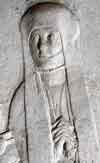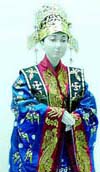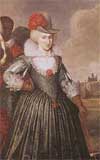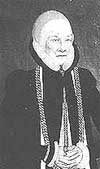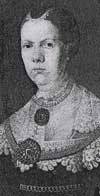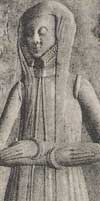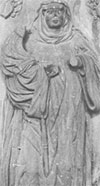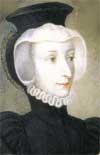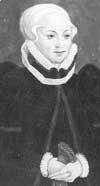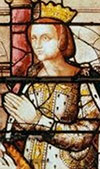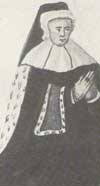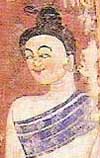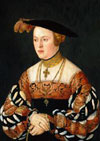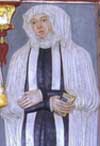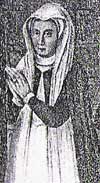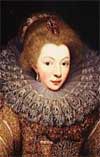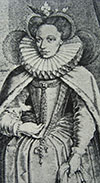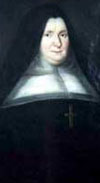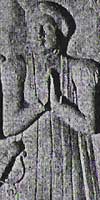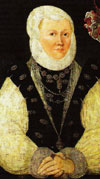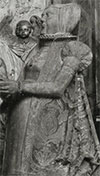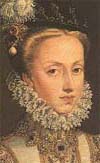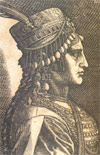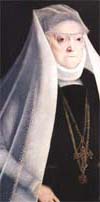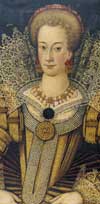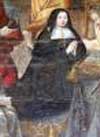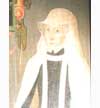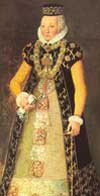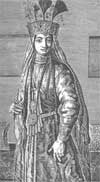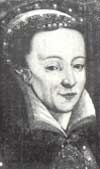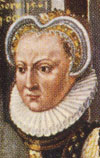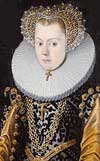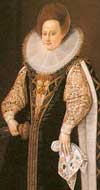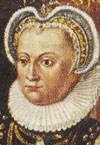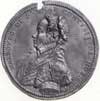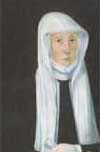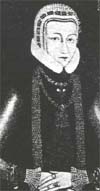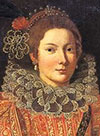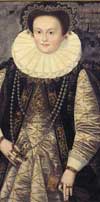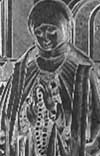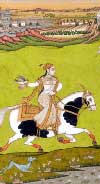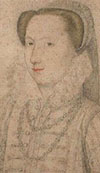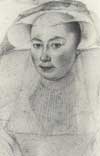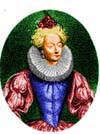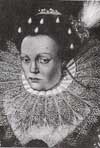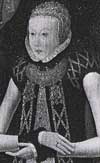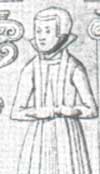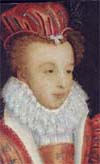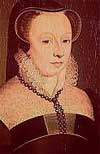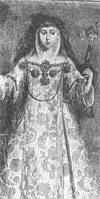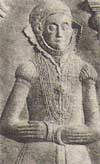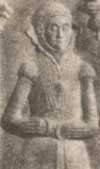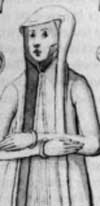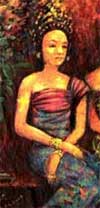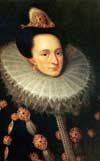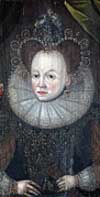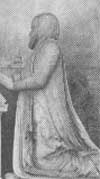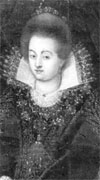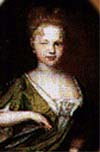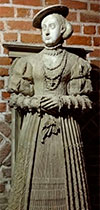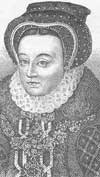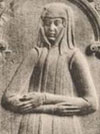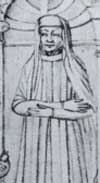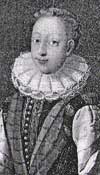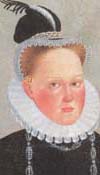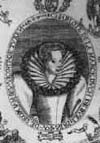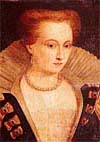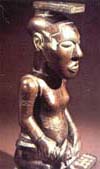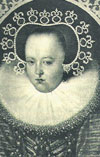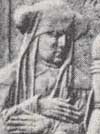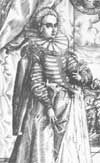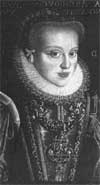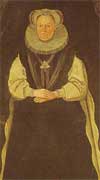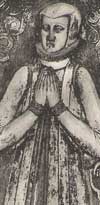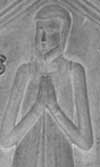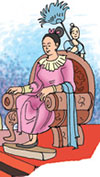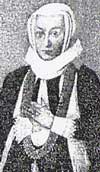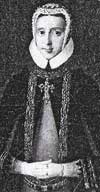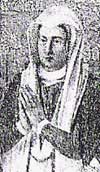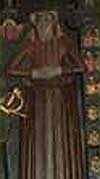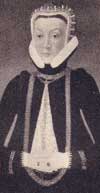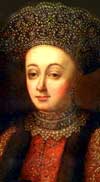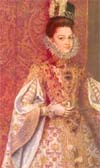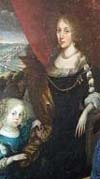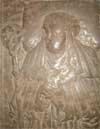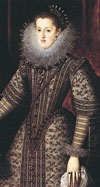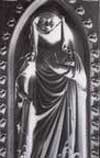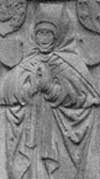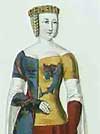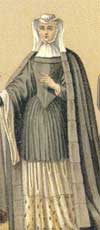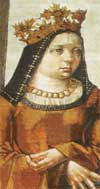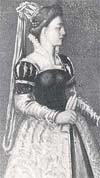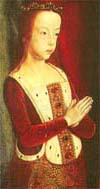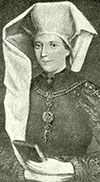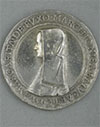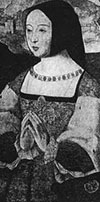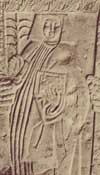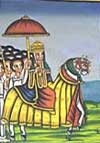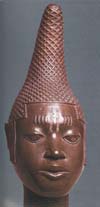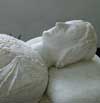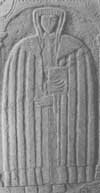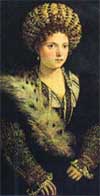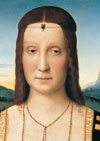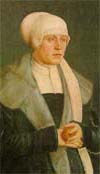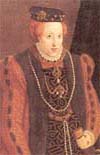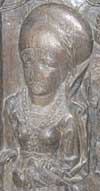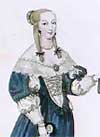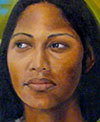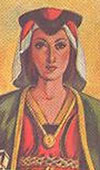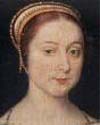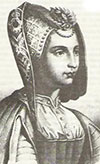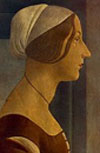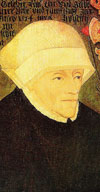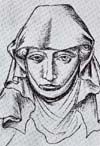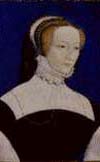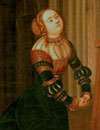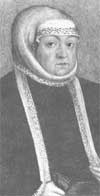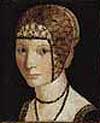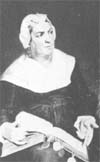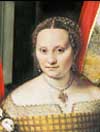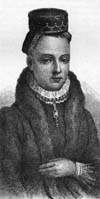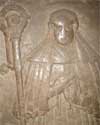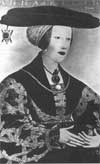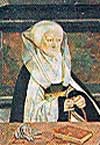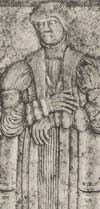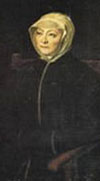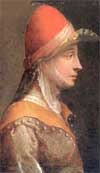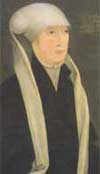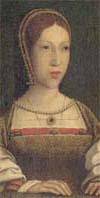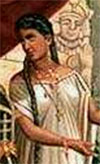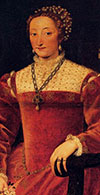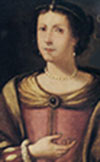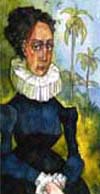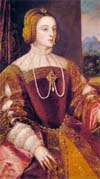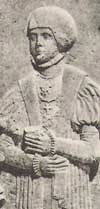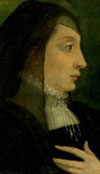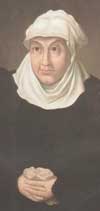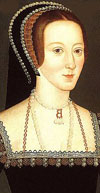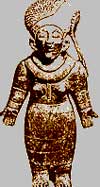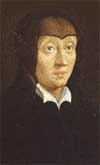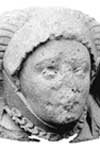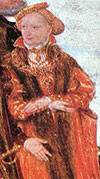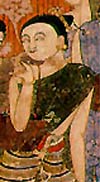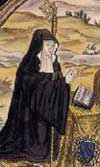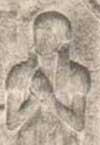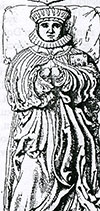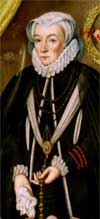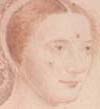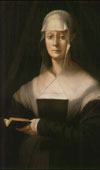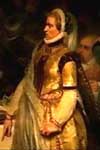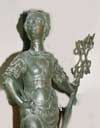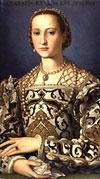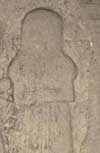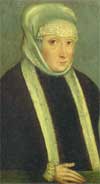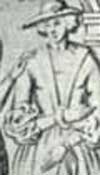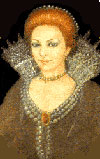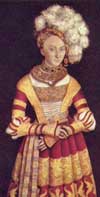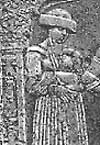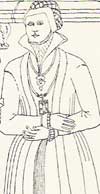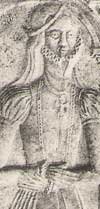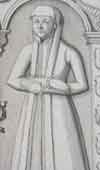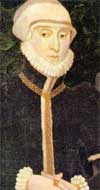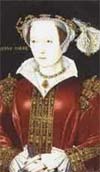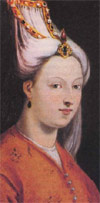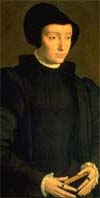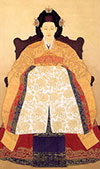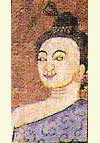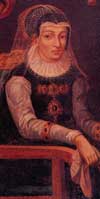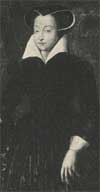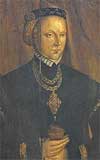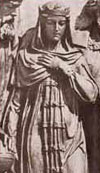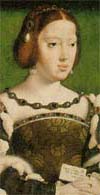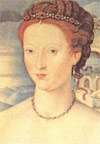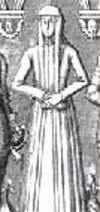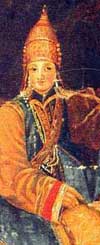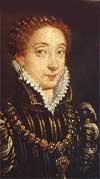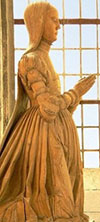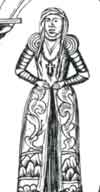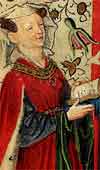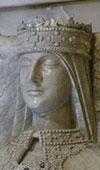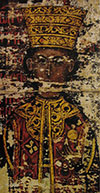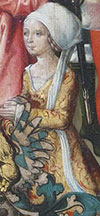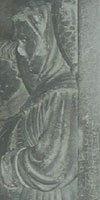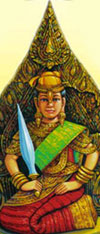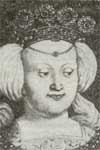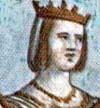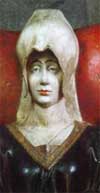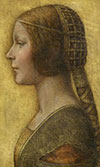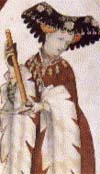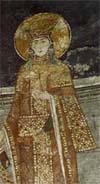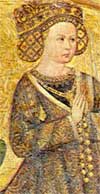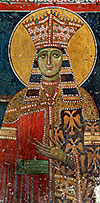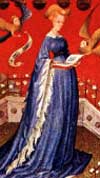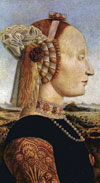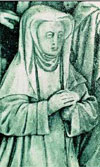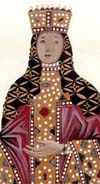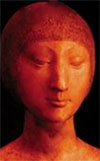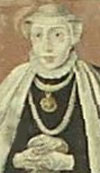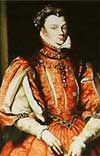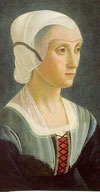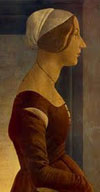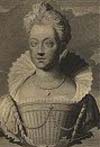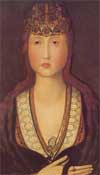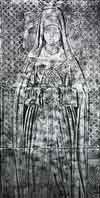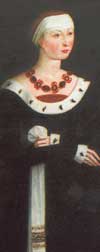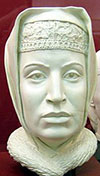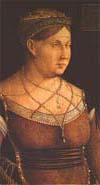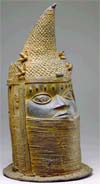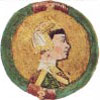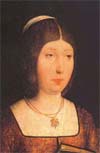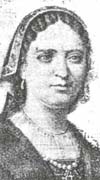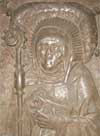Around 1550s Paramount Chieftainess Borkia of Mambolo (Sierra Leone)
Migrated from Guinea in the mid-16th century, most likely as part of the Mane invasion. Her chiefdom was conquered by Bullom warriors after a very short period.
Around 1550s Paramount Chieftainess Baimba Mariama Kallay of Mongo (Sierra Leone)
Came in the mid 16th century from Maly after the fall of the Empire.
1550-74 Sovereign Duchess Marguerite de France of Berry (France)
Daughter of François I of France and Duchess Claude de Bretagne, she was married to Emmanuel-Philibert, duc de Savoie, and lived (1523-74).
1550-83 Joint Administator Duchess Antoinette de Bourbon-La Marche of the Duchies of Aumale and Guise (France)
Demonstrated considerable administrative talent at domestic economy as well as in the running of the vast Guise dominions
surrounding their chateau of Joinville after the death of her husband, Duke Claude de Guise, together with her daughter-in-law, Anna d’Este. Described as a remarkable woman, combining a strong sense of family pride with a wry sense of humour, she exerted a powerful influence on the childhood of her granddaughter Mary, Queen of Scots during the latter’s thirteen-year sojourn in France, and was one of her principal advisors, and acted as proxy for her daughter, Mary of Guise during the betrothal ceremony of the Queen of Scots and the Dauphin Francis in 1558. Her two other daughters were Abbesses, Renée de Guise of St. Pierre in Reims and Antoinette de Joinville of Faremoutiers. Also mother of 9 sons. The daughter of Count François de Vendôme and Marie de Luxembourg, she lived (1493-1583).
1550-66 Joint Administrator Duchess Anna d’Este of France of the Duchies of Aumale and Guise (France)
1550-1607 Politically Influential in France
During her marriage to Francis de France, Duke of Aumale and Guise, she was in charge of the family estates and the enormous fortunes of the Guise after the death of her father-in-law, Claude. At court she was active on behalf of her father, Duke Ercole II d’Este of Ferrara, and acted as mediator between France and Ferrara. In 1563 her husband was assassinated. She held the leader of the French Huguenots, Gaspard de Coligny, responsible for the assault and her contemporaries considered her responsible for the shot which was fired on him in 1572 and which became the starting signal for the St. Bartholomew’s Day massacre. 1566 she had married Jacques de Savoie, Duke of Nemours and Genevois, and spent most of her time in Annecy or on the road between Genevois and the court of France. She acted as mediator between her husband and the Duke of Savoie, and still claimed a prominent place in official ceremonies at the French Court. After the death Jacques in 1585 she lived in Paris. With the formation of the Catholic League, in which her sons played a prominent part, her importance increased again. In 1588 King Henri III ordered the murder of her two oldest sons and her imprisonment. Some contemporaries also held her responsible for the assassination of the king. During the siege of Paris by Henri IV, she was declared “queen-mother” by the League, but after his conversion to Catholicism, she recognized him and tried to convince her sons to do the same. She spent her last years in the highly respectable position of “superintendante de la maison” of the Queen Marie de’ Medici. Her mother, Renée de France, was Duchess of Chartres 1515-75. She lived (1531-1607).
1550-82 Adelantada Catalina Montejo of Yucatán (Mexico)
Inherited position of Adelantado (a kind of governor/landowner) jointly with her husband, Alonso Maldonado. After his death she was in charge of the area alone.
1550/55-71 Princess-Abbess Agathe Heggenzer von Wassersteltz Säckingen (Germany)
After the resignation of Fürstäbtissin Magdalene no canonisses remained in the chapter and the “grand verge” (Grossmeier) Hans Jakob von Schönau acted as administrator, but the Austrian Government and Bishop Christoph Metzler of Konstantz asked the 3 canons to elect an Abbess. At the time she was a nun at St. Katharinental bei Diessehhof and she is known to have been in Säckingen at lest 1552 together with another nun from her original convent but she did not take office until 1555. She restored the chapter and is seen as it’s second founder, brought it back on its feet economically, and restored the church. The water supply was renewed and several treaties were made between the Chapter and the city of Säckingen.. She also introduced new and more sombre status and reinstated the secular authority of the chapter which the Grossmeier had “ursurped” during the interregnum. She was daughter of Landvogt Johan Melchior Heggenzer.
1550-61 Acting County Sheriff Eline Mogensdatter Gøye of the County of Skjoldnæs, Denmark
Eline Gøye was married to Mourits Olufsen Krognos and Vincents Juel. She was daughter of one of the country’s major landowners, Mogens Gøye, but he
had many children, and she therefore only inherited half of the estate Clausholm together with a brother. She was in dispute with her sister-in-law Anne Rosenkrantz, and in 1561 a compromise was reached, which according to Eline favourised Anne. Later same year Anne also was appointed Lensmand (County Sheriff) Skjoldnæs, which Eline had got after the death of her first husband. She was sister of another major landowner and Lensmand, Birgitte Gøye, and lived (circa 1510-63).
1551 Queen Jalampa Siri Sudhamma Mahadevi of Lanna (Chiang Mai) (Thailand)
Also known as princess Thao Meh Ku, she was married to Sethathirat of Lan Xang, who became king of Chiang Mai. After he was deposed, she ruled on her own until she was deposed herself by Mekut (Mekkhuti), the king of the Shan State of Muong Nai (he was succeded by Queen Wisuthatevi in 1564). Sethathirat continued fighting against Lanna until his death in 1571.
1551-64 Reigning Lady Duchess Sabina von Bayern of Nürtingen in Württemberg (Germany)
After the birth of the Crown Prince Christoph in 1515 she fled the threats of her husband Ulrich with both her children to her brothers,
the Bavarian Dukes Wilhelm und Ludwig, and only after her son ascended to the throe she was able to return to Württemberg, where she took up residence in her dowry in Nürtingen, where she held a small court, which became a local centre of Protestantism. She lived (1492-1564).
1551-72 Sovereign Countess Charlotte de Roye of Roucy (France)
Succeeded her father, Charles de Roye, married to François III de la Rochefoucauld and was succeeded by her son Josué de La Rochefoucauld de Roye.
1551-60 Princess-Abbess Katharina II von Tecklenburg of Essen (Germany)
During her tenure in office, the protestant movement became stronger. 1555 was the year of the Augsburg Peace, where it was made clear that the subjects had to have the same faith as their sovereign. In Essen the citizens were mainly protestant, but Katharina remained catholic, and the city council saw this as a way to free the city from the dominance of the Abbess, and for a period they were successful. Daughter of Otto IX von Tecklenburg and Irmgard von Cuyk-Rietberg. Her older sister, Jakobäa was Abbess of Vreden (1533-1563), and the younger Irmgard Abbess of Quernheim since 1534. Their niece Anna was heiress of Tecklenburg und Rheda (1527-82) and married to Everwin III von Götterswick Count of Bentheim-Steinfurt. Katharina lived (1517-60).
Until 1551 County Sheriff Birgitte Steensdatter Bille of the County of Sandby (At the time part of Denmark, now Sweden)
Until 1553 County Sheriff of the County of Katsløse (Denmark)
Birgitte Bille’s husband, Jens Torbensen Rosensparre died in 1553. Sandby is situated in the landscape of Skåne which was annexed by Sweden in 1658.
She (d. 1553).
1551-52 Acting County Sheriff Sidsel Jensdatter Ulfstand of the County of Kalundborg with the Shire of Arts Løve, Ods and Skippinge and Samsø, Denmark
1554-circa 75 County Sheriff of Villands Herred in Skåne (At the time part of Denmark, now Sweden)
In 1535, during the “Fight of the Count” (Grevens Fejde) Sidsel Ulfstand’s husband, Knud Pedersen Gyldenstierne til Tim, was imprisoned by Count Christoffer, and he was not freed until Copenhagen gave in to Christian 3. one and a half year later leaving her in charge of his estates. He rejoined the Council of State became in charge of the tenancy of Kalundborg Slot. After his death she acted as an energetic and able administrator with economic sense. She was in charge of her husband’s estate for her minor children, she inherited some estates from her childless brothers and in 1554 she was given charge of Villads Herred in Skåne for life. During the Seven Year War 1563-70 she lend money to the crown against security in estates in Ramsø and Tune Counties. As County Sheriff of Villands herred, she made good use of her talents as she had to gather supplies for the army, conscribe peasants for the war, collect taxes and maintain roads, bridges and defences in a unruly boarder area, and she was also a frequent visitor at court. She mainly lived at Ljungby, but also often lived at Bønnet, where she was the patron of the parish church of Horbelev from 1565. She was very preoccupied with securing that her pastors lead a sober life, and one of them, Mr. Jakob, had to ask for her forgiveness. She seems to have a formidable women, also much respected by her children. Mother of 7 children and (d. circa 1575).
1551-… County Sheriff Sophie Holgersdatter Rosenkrantz of Börringe Kloster in Skåne (At the time part of Denmark, now Sweden)
Sophie Rosenkrantz was widow of Axel Axelsen Brahe til Krageholm, Hammar, Vittskövle og Tunbyholm (d. 1551), and (d. 1558).
1551-54 County Sheriff Ane Christensdatter of Hindselgård with Refs Herred in Thy, Denmark
Widow of Jens Lassen, citizen of Hostebro, who had held the tenantcy as security for lones. After his death, she was given royal permision to keep the tenantcy for life. She handed over the right to the administration and income to Erik Rud but kept the estate.
1551 County Sheriff Helvig Mogensdatter Gøye of the County of Bygholm with the Shires of Bjerge, Hatting, Nim and Vor, Denmark
Helvig Gøye til Avnsbjerg og Ormholt was in charge of the tenantcy after the death of her first husband, Otto Henriksen Gyldenstierne. Secondly married to Mogens Gøye til Bremversvold. She (d. 1597).
1551 County Sheriff Eline of the County of Nygård, Denmark
Widow of Anders Rølike. Her background is not known.
1552-67 HM Mary Stuart, Queen of Scots (United Kingdom)
1558-87 Titular Duchess of Touraine (France)
Ascended to the throne of Scotland when she was just six days old. At age five she was sent to France to be brought up in the French court, and
eventually married King Francis II, who died the next year, where after Mary returned to Scotland where a series of politically unwise love affairs and her continued adherence to Catholicism in a Protestant country led to trouble and a revolt against her. Forced to flee to England for refuge, but Queen Elizabeth kept her under a form of imprisonment for the next 19 years. Watched closely, she was implicated in a series of conspiracies against Queen Elizabeth, and was executed, but her son, Jacob later succeeded as king of England. Mary lived (1552-87).
1552-75 County Sheriff Alhed Jørgensdatter Urne of Krønge Birk, Denmark
Alhed Urne was widow of Jørgen Venstermand, who had first been married to Maren Hansdatter Griis. She lived (1505-after 60).
1553 HM Jane, By the Grace of God, Queen of England, France and Ireland, Defender of the Faith and of the Church of England and also of Ireland in Earth, under Jesus Christ, Supreme Head (United Kingdom)
Lady Jane Grey was also known as Queen of England, France and Ireland, Defender of the Faith, Supreme Head on Earth of the
Church of England and Ireland. She was the great-granddaughter of Henry VII through her mother, Lady Frances Brandon, daughter Mary, the younger of King Henry VIII’s two sisters. On May 21, 1553, John Dudley, Duke of Northumberland, who exercised considerable power at that point in the minority of King Edward VI, joined with Jane’s father, Duke of Suffolk, in marrying her to his son, Lord Guildford Dudley. Edward VI accepted Jane as his heir and on his death she was proclaimed Queen on July 10 and the Council of the Realm recognized her claim. The rightful heir, Edward’s sister, Mary Tudor, had the support of the populace, and on July 19 even Suffolk, who by now despaired of success in the plans for his daughter, attempted to retrieve his position by proclaiming Mary Queen. Jane was later beheaded (as was her husband) in 1554 having lived (1537-54).
1553-58 HM Mary I Tudor, by the Grace of God, Queen of England, France and Ireland, Defender of the Faith, etc. (United Kingdom)
1553-54 Supreme Head on Earth of the Church of England and Ireland
She was the daughter of Henry VIII and Catherine of Aragon, and restored papal supremacy in England, abandoned the title of Supreme Head of the Church, reintroduced Roman Catholic bishops and began the slow reintroduction of monastic orders. She also revived the old heresy laws to secure the religious conversion of the country; heresy was regarded as a religious and civil offence amounting to treason. As a result, around 300 Protestant heretics were burnt in three years. Her decision to marry Philip, King of Spain from 1556, in 1554 was very unpopular; the protest from the Commons prompted her reply that Parliament was ‘not accustomed to use such language to the Kings of England’ and that in her marriage ‘she would choose as God inspired her’. England suffered during her reign. The economy was in ruin, religious dissent reached a zenith and England lost her last continental territory. She possibly died from cancer, leaving the crown to her half-sister Elizabeth. Mary lived (1516-58).
1553-79 De-facto Reigning Dowager Countess Maria von der Hoya of Bronckhorst, Lady of Borckelo (Germany)
After her husband, Jobst, Graf zu Bronkhorst und Herrn zu Borculo, was killed in an accident the fief reverted to the Diocese of Münster, but she continued to be in charge of the administration until her own death.
1553-59 Princess-Abbess Ursula I Schad of Heggbach (Germany)
Prioress and Second in Command 1540-53 until her election as ruler of the territory. She resigned because of bad health, and died later the same year.
1553-70 Dowager Reigning Lady Elena von Pfalz-Simmern of Schwarzenfel in Hanau-Lichtenberg (Germany)
Widow of Count Philipp II von Hanau. The castle served as the seat of the dowry government for other dowager countesses of Hanau as well.
Until 1553 County Sheriff Johanne Jørgensdatter Krumpen of the County of Kjølskegård, Denmark
Johanne Krumpen was widow of Jacob Eskilsen Høegh til Lergrav, Eskær Vang and Kjølskegård, who died after 1528 at a not known time. She lived (circa 1480-circa 1553).
1553-79 County Sheriff Lene Tønnesdatter Viffert of the County of Havelse
1564-79 County Sheriff of Dalby Kloster (Then Denmark, now Sweden)
Lene Viffert was given ownership for life of Havelse and later granted the tenantcy of Dalby Kloster after the death of her second husband, Jacob Sehested til Havelsegård i Havelse Magle, but had to promise to marry Claus von Ungern til Käsel og Clausholm på Øsel, who was given the right of succesion after her death. (fik ventebrev). Her first husband was Basse Christoffersen Basse til Sørup. She (d. 1579).
1553-85 Politically Influential Electress Anna af Danmark of Sachsen (Germany)
Reigned at the side of her husband, Kurfürst August von Sachsen (1626-86), with whom she lived a very harmonious marriage. She
was especially when it came to the fights over religion from 1574, her opponents blamed her of ‘Gynaecocracy’, and she always took the side of the Lutherans in the fights with the Calvinists. In 1563 she intertwined in the negotiations between Denmark of Sweden together with her mother, Dorothea von Sachsen-Lauenburg, and managed to end the long war between the two countries, she initiated that her husband took the side of her brother, Frederik II, and had Emperor Maximilian II. act as mediator in the conflict. She was also a very able trader and industrialist, and in 1578 her husband transferred the administration of all the Electoral Domains to her and she was a pioneer within modern agriculture. She was also knowable with medical plants, and even the Queen of Portugal asked for her help. In 1548 she was handed over the administation of her dowries in Weissenfels, Freyburg (or Sangerhausen). The daughter of Christian III of Denmark and Norway, she signed her letters, ‘Anna, born as Royal Danish Stock, Electress of Sachsen.’ She was mother of 15 children, and lived (1532-85).
1554-60 Regent Dowager Queen Marie de Guise of Scotland (United Kingdom of Great Britain)
Married to James V of Scotland and regent for her daughter, Mary Queen of Scots. The daughter of Claude de Lorraine, duc de Guise, she was also known as Mary of Lorraine. Before her marriage to James V in 1538, she had been married to Louis d’Orléans, Duc de Longueville, who died in 1537. When James died in 1542, shortly after his daughter’s birth, James Hamilton, Earl of Arran, became regent. By 1554, with French aid, Marie de Guise had replaced the ineffectual Arran as regent, and she made no secret of her desire to bring France and Scotland together. Meanwhile, Protestantism was spreading rapidly in Scotland, and Marie, though at first conciliatory toward the reformers, began a campaign of suppression. In 1559 the Protestants, exhorted by John Knox, rose against the regent and declared her deposed. She received French aid, but the Protestants, allied with the English, proved the stronger force. The civil war was concluded shortly after Marie’s death by the Treaty of Edinburgh (1560), which ended the French domination of Scotland and opened the way for the establishment of the Protestant church. She lived (1515-60).
1554-55 Regent Infanta Juana of Spain
Acted as stand-in for her brother, Felipe II, who had been appointed regent of Spain by their father, Carlos I (Emperor Karl V), but who was in England
some of the time with his wife, Mary I Tudor. Juana had returned to Spain after the death of her husband, the Crown Prince of Portugal, leaving her son, Sebastao behind. In 1555 their father abdicated in favour of Felipe. She founded a very rich monastery and remained influential till her death. She lived (1537-73).
1554-79 Queen Regnant Kalinyamat of Jepara (Indonesia)
Succeeded to the throne when her husband, R. Toyib or “Sultan Hadlirin”, was killed by Bupati Jipang. The commercial port gave wealth to the kingdom and she sent her combat fleet for Malacca to attack and destroy Portuguese in 1551 and 1574, but her forces did not manage to drive Portuguese away from Malacca. The daughter of Sultan Trenggono of Demak, she was originally named Retno Kencono. (d. 1579).
1554-55 Regent Dowager Abakyala Nannono of Buganda (Uganda)
The seventh wife of Kabaka Nakibinge Kagali, she acted as regent for 8 months after his death, pending the birth of her posthumous child, but when it showed out to be a daughter (Nono), her husband’s son by his 4th wife, Kabaka Mulondo Sekaja, was elected king. She was daughter of Seggirinya, of the Dgo clan.
1554-1610 Sovereign Princess Marie de Créquy of Poix, Dame de Mareuil (France)
Granddaughter of Jossine, who was Dame de Poix around 1526. Marie married Gilbert de Blanchefort, Lord of Saint-Janvrin. She lived (1526-1610).
1554-56 Abbess Nullius Caterina Acquaviva of the Royal Convent of Saint Benedetto in Conversano, Temporal and Secular Ruler of Conversano (Italy)
Member of the Countly Family of Conversano and other territories in Puglia in the South of Italy at the time in the Kingdom of Napoli.
1555-1572 Queen Regnant Juana III d’Albret of Navarra and Co-Princess of Andorra, Duchess of Albert, Comtesse de Foix-Béarn-Grailly, Périgod, de Rodez, d’Armagnac, Perche, Fezensac, de L’Isle-Jourdain, Porhoët and Pardiac, Viscomtesse de Limoges, Brulhois, Lomagne, Fezenzaguet, Cressey, d’Auvillars, Baroness de Castelnau, Caussade, Montmiral and Dame de La Flêche and Baugé (France and Spain)
Also known as Jeanne d’Albret, she grew up in France as a French princess. She married Antoine de Bourbon out of love but their marriage
was unhappy because of his constant infidelities. He died just before she succeeded her father as Queen of Navarra. She converted to Calvinism en 1560 and favoured this faith in Navarra and Béarn as her other domains was under the suzerainty of the king of France. She was involved in the different wars of religion of the time, and in 1571 she made Calvinism the state religion in Béarn and Navarre, and in order to maintain and affirm her authority in her domains, she negotiated the marriage of her son Henri with Marguerite de Valois, sister of Charles IX. She died before the celebration of the marriage and the Saint-Barthélemy massacre on the French Protestants. Her son became king of France and trough him the post of Co-prince has passed on to the Presidents of the French Republic. She lived (1528-72).
1565-71 Reigning Abbess Charlotte de Bourbon-Montpensier of the Royal Abbey of Jouarre (France)
Daughter of Louis III de Montpensier et de Jacqueline de Longwy. With the help of Queen Jeanne III de Navarre, she found refuge innHeidelberg and married Willem van Oranje-Nassau, Stadtholder of the Netherlands and had 6 daughters of whom Louise-Juliana, Catharina Belgica and Charlotte-Brabantine became regents after their husband’s deaths, and Charlotte Flandrina (1579-1640) became Abbess de Poitiers. She lived (1546-82).
1555-66 Reigning Abbess-General Catalina Sarmiento of the Royal Monastery of Santa Maria la Real de Las Huelgas in Burgos (Spain)
As one of the only abbesses in the history of the Catholic church, the Señora Abadesa of Las Huelgas de Burgos held quasi Episcopal powers.
1555-56 Acting County Sheriff Anne Pedersdatter Lykke of the County of Stege with the two Shires of Møn
1564-74 County Sheriff of the Church Servants in the County of the Shire of Gjerlev
1569-70 Acting County Sheriff of Spøtrup
1569/70-74 County Sheriff of the Counties of Medelsom and Sønderlyng with Spøtrup, Denmark
Anne Lykke til Demstrup administered Stege after her first husband, Anders Bentsen Bille til Søholm, was killed in the Feud of the Count and was in
charge of Medelsom etc. after the death of her seond husband, to Otto Jørgensen Krumpen til Trudsholk, a member of one of the oldest noble families of the country and one of the most influential men of their time, who died without issue as the last male member of the family. She held Spøtrup as security for lones and exchanged it with Øtsløf Kloster in 1570. Her last husband was Claus Daa. 1574 she returned the letter of security for the Tenantcies to the king who dropped a case against her. Her branch of the family Lykke was also known as Lykke Munk til Overgaard. She (d. after 1574).
1556-58/60 Co-Regent Dowager Empress Hamida Banu Begum of The Mughal Empire (India)
After the death of Emperor Humayun (1530-1556), who spend 15 years in exile 1540-55, his 14-year-old son, Akbar, succeeded to the throne, and Hamida Begum (perhaps also known as Maliam Anga) was part of the regency. She lived (1527–1604)
1556-64 Regent for the Governor Mah-Chehak Begum of Kabul, Afghanistan
Also known as Mah Čučak Bigum, she was regent for her son, Prince Mirza Muhammad Hakim (1553-56-85), son of the Moghul Emperor Humayum (1508-56), to whom she was a concubine. She was murdered in 1565.
1556-57 Regent Dowager Princess Françoise de Breeze of Sedan and Bouillon (France)
Took over the government after the death of her husband, Robert IV de Sedan, who was also created Duke de Bouillon. She was
daughter of Diane de Portier, mistress of the French King. Françoise was also Countess of Maulevrier and had two sisters, Diane de Valois, who was Duchess of Chatellerault etc., and Louise de Breeze, Dame d’Anet. Françoise was mother of 9 children, and died 1557.
1556-80 Reigning Dowager Lady Dowager Electress Dorothea af Danmark og Norge of Neumarkt in Pfalz (Germany)
After the death of her brother, Hans, in 1532, Dorothea von Dänemark und Norwegen was considered a serious contender to the
Danish and Norwegian Throne by her Habsburg relatives, who still supported her father, Christian 2, who had been imprisoned and died in prison in 1559. Her mother, Elisabeth von Habsburg (Isabel of Spain), died 1526 and together with her brother and sister, she grew up at the court of her grat-aunt and aunt, the Governor Generals of the Netherlands, Margaret I and Maria. She was married to Friedrich II von Pfalz (1482-1556). After his death, she transferred her claims to the Danish throne to her sister, Christine, Regent of Lorraine from 1545. In spite of her Catholic relatives and the new Calvinist Elector of the Palitinate, she kept her Lutheran faith in her dowry where she lead a lavish life and remained in close contact with her Habsburg relatives for the rest of her life. She did not have any children, and lived (1520-80).
1556-68 Politically Influential Duchess Sophie of Poland of Braunschweig-Wolfenbüttel (Germany)
1568-75 Sovereign Lady of Schöning and the Amt Jerxneim
Also known as Sophie die Jagiellonin, she was engaged in diplomatic activities both with her native Poland and the rest of Europe during the reign of her husband, Heinrich the Younger, she was also active in Politics, and an outstanding intellectual capacity and cultural personality. After her husband’s death, and the accession to the throne of her stepson, she retired to her dowry, which she reigned as a sovereign with rights over administration, juridical matters, trade and a small army. She became extremely rich, and her sisters and her husband’s relatives and later their descendants fought over the inheritance, which was not settled for another 100 years. The daughter of King Zygysmund I of Poland and Bona Sforza, she had no children, and lived (1522-75).
1556-94 Princess-Abbess Maria Jacoba von Schwarzenberg of Buchau (Germany)
She was in dispute with the bishop of Konstanz and strongly maintained her own rights as ecclesiastical leader and the position of her territory. She was also promoter of religious and cultural affairs. In 1559 she signed a decision of the Imperial Diet (Reichstagsabscheid), participated in the the Assembly of the Swabian Circle (Kreistag) 1569, represented by the Count of Fürstenberg in the Imperial Diet 1572 and 1576, and by the Truchess von Waldburg in 1577. She was daughter of Freiherr Christoph and Eva von Montfort, and lived (1515-94).
1556-57 County Sheriff Sidsel Andersdatter Bille of the County of Gårdstange and the Shire of Frost (At the time part of Denmark, now Sweden)
Sidsel Bille was widow of Niels Tønnesen Parsbjerg til Kulla Gunnarstorp, Lensmand of Vrejlev Len(d. 1556). She (d. 1566).
1556-80 County Sheriff Mette Hansdatter Lange Munk of Holmegård, Denmark
Mette Lange became in charge of the tenantcy after her husband, Iver Kjeldesen Juel, died the same year he became County Sheriff. She was later granted the tenantcy for life.
1557-62 Regent Dowager Queen Catarina von Austria of Portugal and the Algaves
Her husband João III died without leaving instructions about regency. A hastily convened council of nobles declared that it had been his wish that Queen Catarina should undertake the office of regent and she was duly appointed and governed in the name of her grandson, Sebastião (1557-78). She was daughter of Juana I la Loca and Emperor Maximillian. After Sebastião came of age at 14, she retired to a convent and lived (1507-78).
1557-80 Sovereign Countess Anna von Tecklenburg-Schwerin of Tecklenburg und Rheda
1562-73 Regent of Bentheim
1566-72 Regent of Steinfurt-Wevelinghoven and Granau (Germany)
Succeeded father, Konrad von Tecklenburg-Ibbenbüren, and married to Everwin III von Götterswich, Graf von Bentheim-Steinfurt
(1536-62), but she remained a staunch Lutheran when Everwin joined Catholism, and he tried to take over her territories and lock her in the tower of the castle of Tecklenburg, but the lords of the immediate county backed her. The situation was solved when he died of syphilis. After his death, she was regent in Bentheim and after the death Arnold III, also regent in Steinfurt. In 1580 she handed over Tecklenburg and Rheda to her son, Arnold IV von Bentheim-Tecklenburg. It is said about her that she had knowledge of healing plants and that she prevented the prosecution of witches in her territory. She lived (1532-82).
1557-.. County Sheriff Queen Dorothea von Sachsen-Lauenburg of Denmark of Vejle Mølle
1558-66 County Sheriff of Holme Kloster
1559-71 County Sheriff of the County of Koldinghus with the Shires of Brusk, Jerlev, Holmans, Tørrild and ½ of Andst, the County of Ålholm with the Shires of Fugelse and Musse, the Counties of Ravnsborgn and Åkær with the Shire of Had
When her husband, Christian III, King of Denmark and Norway and Duke of Schleswig-Holstein (1503-34-59) died, she withdrew to her dowry that she also administered as a fief-holder, Lensmand, being in charge of aspects of the local administration. She was very influential as head of the family. She also held Als, Sundeved og Ærø in the landscape of Slesvig. She lived (1511-71)
Circa 1557-74 Acting County Sheriff Sidsel Clausdatter Bille of the County of Kjølskegård, Denmark
Sidsel Bille was widow of Just Jacobsen Høeg Banner til Vang og Lergrav (d. 1557), who had first been married to Mette Mogensdatter Gøye.
1557 Abbess Nullius Barbara Acquaviva d’Aragona of the Royal Convent of Saint Benedetto in Conversano, Temporal and Secular Ruler of Conversano (Italy)
Daughter of Andrea Matteo III Acquaviva d’Aragona, Duke of Atri etc. (1457-1529), and probably his second wife Caterina della Ratta, Countess di Caserta, Alessano e Sant’Agata (from 1488). Her italian title was Badessa di Santa Maria dell’Isola a Conversano dal 1558
1557 Reigning Abbess Magdalena von Reischach of Wald, Lady of the Offices of Wald, Vernhof and Ennigerloh (Germany)
Only in office for a few months.
1557-68 Reigning Abbess Margrethe von Reischach von Hohenstofffeln of Wald, Lady of the Offices of Wald, Vernhof and Ennigerloh (Germany)
The chapter was a major landowner and also held lower jurisdiction in a number of surrounding villages.
1558-1603 Elizabeth I, Queen of England, France and Ireland, Defender of the Faith, Supreme Head on Earth of the Church of England and Ireland (United Kingdom)
Daughter of Henry VIII Tudor and Anne Boleyn, she succeeded her half-sister Mary. she was very well educated (fluent in six languages). Her 45-year reign is generally considered one of the most glorious in English history. During it a secure Church of England was established. Its doctrines were laid down in the 39 Articles of 1563, a compromise between Roman Catholicism and Protestantism. Although autocratic and capricious, she had astute political judgement and chose her ministers well. Her reign also saw many brave voyages of discovery, which prepared England for an age of colonisation and trade expansion, In 1588, aided by bad weather, the English navy scored a great victory over the Spanish invasion fleet of around 130 ships – the ‘Armada’ which was intended to overthrow the Queen and re-establish Roman Catholicism by conquest, as Philip II believed he had a claim to the English throne through his marriage to Mary I. She was succeeded by James VI of Scotland, and lived (1533-1603).
1558-61 Regent Infanta Maria de Austria of Spain
In charge of the government during the travels of her brother Felipe II in the Empire. She was married to Maximillian II von
Habsburg, Holy Roman Emperor. Their son, Archduke Albrecht of Austria, Duke of Teschen, married the daughter of Felipe – Infanta Isabella, Governor of the Southern Netherlands. Maria lived (1528-1603).
1558-78 Politically Active Margravine Elisabeth von Brandenburg-Küstrin of Brandenburg-Ansbach (Germany)
The most important aide of her husband, Georg Friedrich (1539-1603) until her death. She lived (1540-78).
1558-64 Princess-Abbess Elisabeth II von Gleichen of Gernrode and Frose (Germany)
Several members of her family – of the Counts of Gleichen – were Princess-Abbesses and held other ecclesiastical offices.
1558 Acting County Sheriff Anne Ottesdatter Rosenkrantz of the County of Skanderborg with the Shires of Framlev, Gjern, Hjelmslev, Sabro, Tyrsting, Vrads, Støvring, Hald, Onsild and Ning, Denmark
1561-67 County Sheriff of the County of Skjoldnæs
After the death of her husband, Albert Gøye, in 1558, Anne Rosenkrantz was left in charge of the family possessions. Her lands were scattered all over the country, but she managed to unify most of it, and she achieved the right to appoint the judges within her jurisdiction. Anne was involved in many disputes with her relatives, among others the sister-in-law Eline Gøye, and in 1561 she was appointed Lensmand (County Sheriff) of Skjoldnæs after Eline was removed from this position. In 1566 Anne was ordered to give up the fief again – but only pawed way for the newly appointed Lensmand the following year. She lived (1522-89).
1558-67 Joint County Sheriff Margrethe Jochumsdatter Beck of the County of Ruggård with the Shire of Skovsby, Denmark
Margrethe Beck was appointed jointly with her husband, Palle Christoffersen Ulfeldt (d. 1571) for a period of 20 years, but died after 9 years. Her husband then married Margrethe Clausdatter Brockenhuus. She (d. 1567).
Circa 1558-62 Acting County Sheriff Bege Pedersdatter Skram of Brinkgård, Denmark
Bege Skram til Stovgård was widow of Jørgen Hansen Juel. Apparently only one daughter, Karen Juel, survived. She (d. after 1562).
1559-67 and 1580-82 Stadholder Margaretha de Parma of The Netherlands
1559-67 Governor of Franche-Comté
1572-86 Perpetual Governor of L’Aquila (Italy)
Also known as Madama or Margarita de Austria, her full title was Archduchess of Austria, Infanta of Spain, Princess of Burgundy, Milan, Naples and Sicily. She was daughter of Emperor Karl V and his mistress Johanna van den Gheynst. Her first husband was Alessandro de’ Medici, Duke of Firenze (1510-37), the son of the Black servant Simonetta da Collavechio and Cardinal Giulio de Medici (the later Pope Clement VII), was finally assassinated a few months after their wedding in 1536. She then received the titles of Feudal Duchess of Borbona, Penne and Posta and Feudal Lady of Campli, Castel Sant’Angelo (now Castel Madama), Civita Ducale (now Cittaducale), Leonessa, Montereale and Ortona, Lady of Amatrice, Borbona, Posta which she held until her death. In 1538 she was married to Ottavio Farnese (1525-86), whose father was given the Duchies of Parma and Piacenza by his father, Pope Paul III. In 1545 she became mother of twins. Her half-brother, King Felipe II of Spain, appointed her Governor-General of the Netherlands, and she proved to be an able administrator, but resigned after the Duke of Alba’s crushing of the Dutch opposition against the Spanish rule. She then returned to Italy and was governor of L’Aquila by her brother. Her son Alessandro Farnese was Governor-General of the Netherlands until 1580 when she replaced him. After his return, she was kept a virtual prisoner in Namur, until she was allowed to return to Italy in 1583 where she died three years later. She lived (1522-86).
1559-68 Regent Doamna Chiajna of Walachia (Romania)
After the death of her husband, Mircea Ciobanul, who was Voivode of Wallachia in 1545-1552, 1553-1554 and in 1558-1559, she was regent for her son, Petru cel Tînăr (Peter the Young). She was daughter of Petru Rareş, ruler of Moldova.
1559-89 Princess-Abbess Lucia Hildebrand of Heggbach (Germany)
A former Prioress, she took over enormous depths during a period of bad harvests, hard winters, wet summers, epidemics of plague in 1564, 1572/73, 1574, 1579 and 1589 and on top of it all heavy “turk taxes”. But her bad handling of the economy made the situation worse and the existence of the whole territory was endangered, and she had to resign from her post for the same reason. She lived (1523-1605).
1559-60 Acting County Sheriff Øllegaard Jacobsdatter Trolle of the County of Visborg with Gotland (At the time part of Denmark, now Sweden)
Øllegaard Trolle was a major landowner, widow of Christoffer Hvidtfeldt, mother of 11 children, and lived (1513-78).
1559-62 and 1568-74 County Sheriff Anne Olufsdatter Krognos of Hundlund Kloster
Appointed after the death of her husband, Klaus Podebusk. During her second term in office she held the tenantcy as security for lones. (Pantelen).
1559-63 Joint County Sheriff Catharine Gregoriusdatter Ahlefeldt of Borgeby Len in Skåne (At the time part of Denmark, now Sweden)
1565-82 Joint County Sheriff of the County of Gladsaxe with the Shire of Albo, Denmark
First appointed joint County Sheriff together with her husband, Hans Spiegel til Borreby (d. 1599), who bought the fief and estate of Borgeby and then appointed as security for lones. She had first been married to Johan Stake and Lucas Krabbe. Her
husband married Hilleborg Hansdatter Lindenov til Julskov (d. 1602), widow of Emmike Kaas after her death. She (d. 1582).
1559-… County Sheriff Mette Johansdatter Oxe of Ralsvig på Rygen (Germany)
1559 Acting County Sheriff of Boisø Kloster, Denmark
1566-68 County Sheriff of Ørslev Kloster
Mette Oxe acted in the name of her four sons after the death of her husband, Hans Barnekow, of an old Wendian noble family, who had been appointed hereditary tenant by the Duke of Pommern, it was confirmed by the Duke and King of Denmark in 1564. Was later granted the tenantcy of Ørslev Kloster. 3 of her sisters; Inger, Pernille and Sidsel also acted as County Sheriffs.
1559-60 Acting County Sheriff Lucie Mortensdatter of the County of Jonstrup, Denmark
Daughter of Morten Ebbensen til Gavnø, possibly of the Laale-family, and Benedikte Rubek, and took over the administration after the death of her husband, Christian Eriksen Pors (or Christiern).
Until 1559 Feudal Marchioness Diana de Cardona of Giuliano, Contessa della Chiusa, Baronessa di Borgia (Italy)
Second wife of Vespasiano I, Marchese di Sabionetta, Principe di Sabionetta, 1st Duca di Sabionetta, Conte di Roddi e Ricalta, Barone di Caramanico e Tutino, Marchese di Ostiano, Conte di Fondi, Duca di Traetto, Viceroy of Navarra an Valencia, Knight of Golden Fleece Order. She died upon the delivery of a child.
1560-63 Regent Dowager Queen Catherine de’ Medici of France
1562-89 Sovereign Duchess of Valois, Countess Auvergne and Boulogne
In 1533 she was married to Henri, Duke of Orleans, who became the French king in 1547. As Queen she was very influential in bringing aspects of Italian culture to France, such as their theatre and food. After her husband’s death, she gained political power as regent for her sons. An ambitious woman, she actively involved herself in the political intrigues of the court, always trying to increase royal power. At first Catherine tried to reconcile France’s opposing Catholic and Protestant factions as their violent disputes threatened national unity. But instead she initiated the massacre in 1570 of Protestants (the massacre of St Bartholomew). Succeeded her aunt, Anne de la Tour as Countess of Auvergne in 1524, and father Lorenzo II de Medici as titular Countess of Urbino 1519-21. Mother of 10 children, she lived (1519-89)
1560-62 De-facto regent Maham Anga of the Mughal Empire (India)
The chief nurse of Emperor Akbar, she gained influence after she convinced Akbar to dismiss his minister, Bairam. Her power began to wane in 1561, when Akbar appointed Atkah Khan as chief minister. Five months later her son, Adham Khan, Akbar’s foster-brother, attempted to assassinate Atkah Khan, but was executed, and she died shortly after, and the emperor, who was now 19 ruled alone from then on.
1560 Head of the Regency Council Dowager Duchess Maria von Sachen-Wettin of Pommern-Wolgast (Poland/Germany)
1574-83 Reigning Dowager Lady of the Administrative Office and Castle of Pudagla in Pommern-Wolgast
After the death of her husband, Philipp I Duke von Pommern-Wolgast (1515-31-60) a Council of Regency took over the government for her son, Johann
Friedrich (1542-60-1600). She was guardian for her sons who shared the inheritance of another relative, who abdicated in 1569; Bogislaw XIII von Pommern-Barth/Neuenkamp and later of Pommern-Stettin, Ernst Ludwig von Pommern-Wolgast, Barnim X von Pommern-Rügenwalde und Bütow and Kasimir VI, who was Evangelican Bishop of Cammin. She was also guardian for the daughters Amelia, Margaretha and Anna. The Duchy was hit by The Seven Years War (1563-70), which demonstrated how powerless the Duchy was. Lack of finances and of military power, forced it to remain neutral and thereby it ended up as a “playbill” between the foreign powers. Her Johann Friederich received the Imperial confirmation of his fief (kaiserliche Belehnung) at the Reichstag in Augsburg in 1566. She was daughter of Duke and Elector Johann von Sachsen and Margareta von Anhalt, and lived (1516-83).
1560-76 Member of the Council of Regency Dowager Countess Margarethe von Hoya of Diepholz (Germany)
1560-93 Reigning Dowager Lady of the Office of Auburg
1585-93 Regent of Diepholz
Following the death of her husband, Rudolf IX, a regency council took power under the leadership of Duke Wilhelm von Braunschweig-Lüneburg-Celle in the name of her son Friederich II, and she managed to become part of the council, even though she had not been designated a seat from the beginning. Margarethe von Diepholz was also given the whole of the County as her dowry. In 1582 the Hoya-line died out and she tried to secure her inheritance without success, The same year her only grandson died and 3 years later her son followed. Nominally the county fell to Braunschweig-Lüneburg but in effect she managed to act as regent for her granddaughter, Anna Margarethe (1580-), possibly because Duke Wilhelm had become mentally ill. She reorganised and modernised the administration. The daughter of Jobst II von Hoya and Anna von Gleichen, she had been elected as Abbess of the Noble Chapter of Bassum in 1541, but remained at the court of her parents, and lived (1527-93).
Circa 1560-circa 1600 Clan Leader Grania O’Mally of the West Coast of Camacht and Achill Island, Ireland
1565-1603 “Pirate Queen”
Also known as Grace O’Malley or Gráinne Ni Mháille, she was only daughter of Dubndara O’Mally. Her husband, Donal O’Flatherty, leader of the neighboring clan, was killed and she managed to hold the besieged castle of the family. Imprisoned in 1578-79 and 1593 for piracy and her sons and son-in-law was also held prisoners by the British. Her fleet numbered some 20 ships, and her blatant piracy was seriously emptying the pockets of English merchants at Galway. She wrote a letter to the Chiefess of the Tudor Clan, Queen Elizabeth I, and was granted an audience in London, which resulted in the release of her relatives and the right to continue her activities on Sea and on Land – though under English flag. She lived (1530-1603).
Beatriz Clara Cova Inca, Señora del Valle de Yucay.
1560-1600 Lady Doña Beatriz Clara Cova-Inca of Valle de Yucay, Peru
Only daughter and heir of the last Inca of Peru, Sayri Tupac and his sister and wife María Manrique Cusi Huarcay (circa 1531-after 1586). After her
father’s death, her possessions were administered by various Spanish guardians and she was placed in a convent, until her mother managed to get the pension she had been promised by her late husband and had found refuge at the residence of Cristóbal Maldonado. Beatriz later married Martín García de Loyola, Lord de Calatrava and their only daughter, Doña Ana María de Loyola Cova y Coya-Inca, was named “The Legitimate Representative of the past Sovereign Incas of Peru”, Marquesa de Santiago de Oropesa and Adelantada del Valle de Yucay and Yupangui and Lady de Loyola in 1614. Beatriz lived (1558-1600)
Until 1560 County Sheriff Karen Gans of the County of Ydernæs, Denmark
Widow of Thomas Logen (or Lage), who died in the 1550s. Her second husband, Jacob Krafse became County Sheriff (Lensmand) 1560-circa 72.
Around 1560 Princess-Abbess Ludmilla de Bliziva of the Royal Chapter St. Georg at the Hradschin in Prauge (Czech Republic)
Another version of her surname was von Bliziwa.
1560-61 Princess-Abbess Maria von Spiegelberg of Essen (Germany)
The counts of Spiegelberg had ruled their Small County, cantered around Coppenbrüg since around 1280. In 1494 they inherited the County of Pyrmont, but in 1557 the family died out in the male line. The fief was inherited by Braunschweig-Calenberg, but with the condition that the sovereignty was inherited in the female line to a sideline of the family of Lippe. In 1485 the county was inherited by the counts of Gleichen and in 1631 by Nassau-Oranje, who sold it to Hannover in 1819.
1561-99 Politically Influential Countess Katharina Vasa av Sverige of Ostfriesland (Germany)
1565-1610 Reigning Lady of Pewsum including the Manningaburg and the Mill of Pewsum
1599-1610 Dowager Lady of the Amt Norden, Berum, Woquard, Loquard and Campen
Katharin Wasa was influential during the reign of her husband, Edzard II von Ostfriesland and was an active participants with her brother-in-law, the joint ruler with her husband. She used her dowry to buy the Lordship of Pewsum and she extended the castle of Manningaburg. She was very active with charity work. When her husband died, she demanded the soverignty of the administrative offices she was given as her dowry, but her son, Enno III, maintained that she would only recieve the incomes from the lands as stipulated in her marriage contract, but she only accepted this after he sent 200 soldiers to the area. Mother of 6 sons and 5 daughters and lived (1539-1610).
1561-75 Princess-Abbess Irmgard III von Diepholz of Essen (Germany)
Pröbstin – or second ranking – in the Chapter until her election as its sovereign. Like Maria von Spiegelberg, she was catholic and that caused problems with the predominantly protestant City of Essen. In 1568 Irmgard applied to the imperial supreme court to resolve a wider, century-old dispute between the Abbesses and the Essen citizenry over the rights and responsibilities of the citizens. The judgement, which took 102 years to deliver, was ambiguous. The Abbess was declared the “sole authority and rightful princess of the state”, to whom the citizens owed obedience as “subjects and members of the state”. At the same time however the city was defined as a “civitas mixta” or free city of the German Empire, and therefore not a county, which would have meant complete subjugation to the aristocracy, nor a municipality without jurisdiction or statutory power. This judgement gave rise to continuing legal disputes, which carried on until 1803, when the state was finally secularised. Irmgard also took a keen interest in coal mining.
1561-69 Princess-Abbess Marguerite V de Noyelle of Nivelles, Dame Temporaire and Spirituelle of Nivelles (Belgium)
The abbess of the chapter was Princess of the Holy Roman Empire and Political Leader of the City of Nivelles.
Until 1561 Reigning Abbess Antoniette de Joinville of Faremoutiers (France)
Following the concordat de Bolgone, signed in 1516 between François I and Pope Léon X, the abbesses were named by the king. Her sister, Renée, was Abbess of St. Pierre until her death in 1602. The daughter of Duke Claude de Guise and Antoinette de Bourbon-La Marche, she lived (1531-61).
1561-62 County Sheriff Karen Globsdatter Krabbe of the Counties of Amtofte , Amtofte Kloster and Thistedgård with the Shire of Hundborg, Denmark
1576-78 County Sheriff of the County of Voergård
1579 County Sheriff of the County of Vinderslevgård
Until 1586 County Sheriff of the County of Strekhals
Karen Krabbe til Nissum, Skovsgård og Voergård, or Karen Krabbe Glob, was married to Nils Hansen Skeel Nygård til Vinderslevgård, Ullerup,
Merringgård, Nipgård, Skovsgård, Momtoftegård og Thistedgård (d. 1561). She settled the inheritance with her son-in-law Otto Banner and got Vinderslevgård in exchange. 1578 she and her daughter, Ingeborg Skeel, got the right to the juristiction of the Estate of Vorgård. Ingeborg was County Sheriff from 1585. She lived (1509-86).
1561… Acting County Sheriff Dorothea Nielsdatter Tornekrans of Bråde Len
Dorte eller Dorothea Tornekrans was widow of Niels Markvardsen Skiernov til Mejlgård (d. 1561), who had been granted the tenantcy for life by the Bishop some years before and confirmed by the king after the Reformation. She (d. earlist 1591).
1561-62 and 1562-72 Acting County Sheriff Magdalene Eriksdatter Banner of the County of Skivehus Len with the Shires of Lørre, Harre, Hindborg and Rødding, Denmark
Magdalene Banner was left in charge of the fief after the death of her husband, Iver Krabbe. She (d. 1597).
1561-72 County Sheriff Jytte Presbjørnsdatter Podebusk of Vestervig Kloster, Denmark
Jytte Podebusk was widow of Knud Gyldenstierne (d. 1568), who held the tenantcy before her. She (d. 1573).
1561-62 Acting County Sheriff Mette Eriksdatter Hardenberg of Biskotorp, Denmark
Mette Hardenberg was widow of Didrik Henningsen Qvistzow til Rørbæk etc. (d. 1561). Mother of one daughter, Anne
who died young. She (d. 1573).
1561-62 County Sheriff Anne Albrechtsdatter Glob of Sebber Kloster and Asmild Kloster, Denmark
Anne Glob was widow of Jørgen Urne (d. 1560), and was appointed to both tenantcies for life. (d. 1562).
1562-65 Acting County Sheriff Margrethe Hennekesdatter Rantzau of the County of Skodborg with Malt and ½ of the Shire of Andst, Denmark
Margrethe Rantzau was married to her relative, Jesper Hansen Rantzau, Amtmand in Flensborg and Lensmand in Schmoel, Skodborg, Haderslev and Tørning Len, and she took over the administration of one of his fief after his death.
1562-63 Acting County Sheriff Dorthe Maltesdatter Viffert of the County of Viskumsgård with the Shire of Synderlyng, Denmark
Dorthe Viffert til Øls was widow of Peder Christoffersen Kruse til Ballegård, Ryomgård og Kjellerup. She lived (circa 1514-after 1563).
1562-63 County Sheriff Else Holgersdatter Ulfstand of Ås Kloster in Halland (At the time part of Denmark, now Sweden)
1563-64 County Sheriff of Svaløv Len
1565-69 County Sheriff of Øvid Kloster
1567-.. County Sheriff of Rørum Len, Denmark
Else Ulfstand administered the tenantcy after the death of her husband, Tage Thott, together with her sister, Thale Ulfstand, who was also County
Sheriff of Hesselbjerg from 1595. Her daughter, Thale Thott, was County Sheriff of Lensmand of Åhus and Åsum in Skåne 1587-90. She lived (1520-73).
1562-1622 Politically Influential Empress Mariam uz-Zamani Begum Sahiba of the Mughal Empire (India)
As one of Jalaluddin Muhammad Akbar’s three chief queens, she was politically involved in the court until Nur Jahan became empress. Like other few women at the Mughal court, she could issue official documents (farman), which was usually the exclusive privilege of the emperor. She used her wealth and influence to build gardens, wells, and mosques around the country. In 1586, she arranged a marriage of her son, Prince Salim (later Jahangir), to her niece, Princess Manmati (Manbhawati Bai), who was the mother of Prince Khusrau Mirza. Even though she remained a Hindu after her marrage, she was buried according to Islamic custom and was not cremated. Born as Rajkumari Hira Kunwari Sahiba – or Harkha Bai, she was the eldest daughter of Kacchwaha Rajput, Raja Bharmal, Raja of Amber, and lived (1542-1622).
1563-79 Regent Dowager Countess Katharina von Waldeck-Eisenberg of Lippe (Germany)
After the death of her husband, Bernhard VIII (1527-36-63), she was in disputes with the other regents for her son Simon VI, mainly
Count Hermann Simon zu Pyrmont (d. 1576). Her son was appointed Imperial Commissioner and was in charge of mediating hereditary disputes and gained more and more importance as the years went by. She lived (1524-83).
1563-1621 Reigning Dowager Lady Dowager Queen Katarina Stenbock of Strömsholms Estate with the Shire of Snevringe , Fiholms Estate with the Parishes of Säby and Stora Rytterne, the estates of Tynnelsö and Magerö wit Aspö, the Parishes of Överselö and Ytterselö with Tosterö in the Parish of Strängnäs and the Estate of Kungsberga with the Parishes of Fogdö, Vansö and Helgarö, Sweden
She was engaged to another man when king Gustav Vasa decided to marry her after the death of his previous wife, her aunt, Margareta Leijonhufvud. He was 37 tears older than he, and she was more his nurse than his wife. She was the first Queen Dowager to be named Riksänkedrottning – Dowager Queen of the Realm, and lived (1535-1621).
1563-circa 88 County Sheriff Anne Vernersdatter Parsberg of Derup
1580-81 Acting County Sheriff of the County of Øster Gårdstange and the County of Reving (At the time part of Denmark, now Sweden)
1580-93 County Sheriff of the Counties of Vram, Visby, Stibberup and Revinge, Denmark
Anne Parsberg was first married to Christoffer Gyldenstierne and secondly to Hans Jepsen Skovgaard til Gundestrup (1526-80), Councillor of the Realm and Lensmand of Helsingborg.
1563-87 County Sheriff Margrethe Axelsdatter Urup of the County of Søfed (At the time part of Denmark, now Sweden)
Margrethe Urup til Ugerup was widow of Erik Madsen Bølle til Terløse, Elved and Orebygård and Lensmand at Tureby (d. 1562). She did not have any children. The local administration and juridical system was in the hand of a royal appointed Lensmand (County Sheriff) who each administered a Len (fief or tenantcy). It was normally the local manor-owner, and if that was an unmarried woman she was in some cases appointed Lensmand in her own right, in other cases a woman administered the Len after her husband’s death.
1563-65 County Sheriff Ingeborg Andersdatter Bille of Øvid Kloster, Denmark
Jomfru Ingeborg Bille held the tenantcy as security for lones. She was a rich landowner and inherited Egedegaard from her two unmarried aunts, Ermegaard Bentdsatter and Birgitte Torbendsdatter Bille who had inherited the estate from their fathers, the brothers’ Bent and Torben who owned it jointly. Both cousins died 1587, and from these three unmarried women – Jomfruer – the estate got the present name, Jomfruens Egede (Egede of the Virgin (or unmarried lady)). She (d. 1608).
1563-after 68 County Sheriff Lisbet Johansdatter Urne of the County of Klingstrup, Denmark
Lisbet Urne was widow of Peder Lykke til Skovsbo, granted the tenantcy for life. 1577 she married Johan Bockholt. She (d. 1584).
1563-91 County Sheriff Agnete Busksdatter Skenk of the County of Pandumgård with the Shire of Hornum and the Estate of Snorup, Denmark
Agnete Skenk til Brudagergård was widow of Jørgen Jørgensen Prip til Pandumgård len. She (d. before 1599).
1563-71 County Sheriff Ellen Pallesdatter Bang of the County of Lønborggård and Lønborg Birk
Ellen Bang was widow of Jørgen Hennekesen Kremon Rantzau til Kærgård og Lønborggård. 1570 she was permitted to keep the tenantcy for 8 years, but it was paid off the following year when she married the German noble Ernst von Reckenberg. Her third husband was
Mads Nielsen Skade.
1564-78 Queen Regnant Wisuthatevi of Lanna (Thailand)
Also known as Phra Nang Visuti, Wisutthi Thewi or Wisutthithew (Maha Tewi) she was youngest daughter of Phaya Ket and placed on the throne by the Burmese after King Phra Mekut was deposed, and married to King Burengnong, or Bayinnaung. of Hantawaddy and Pegu, who sacked Ayudhaya in 1569 and continued fighting until his death in 1581. Lanna became a vassal state required to pay annual tribute of gold and silver trees, and manpower as necessary in times of war. She was the last descendent of Mengrai to rule, and after her death, the Burmese sent their own princes to rule in Lanna. (d. 1578).
1564-1633 Sovereign Countess Catherine de Clèves-Nevers of Eu and Souveraine de Chateau-Renaud (France)
Successor of her brother, Jacques de Clèves. First married to Antoine de Croÿ, prince of Porcien and in 1570 to Henri de Lorraine, duc
de Guise, who was assassinated in 1588. (1548-1633)..
Until 1564 Princess-Abbess Barbara II von Sandizell of Obermünster in Regensburg (Germany)
Her relative, Moritz was Prince-Bishop of Freising until he resigned in 1566.
1564-79 Princess-Abbess Barbara III Ratzin of Obermünster in Regensburg (Germany)
1219 the “reichsunmittelbare” – Imperial Immediate – convent came under direct Papal protection and in 1315 Emperor Ludwig the Bavarian appointed the Abbess as Princess of the Realm. Heinrich II granted the convent immunity and during the reign of Konrad II, the abbess even received a royal sceptre. 1484 it was turned into a noble Ladies Chapter (Gräflicher Damenstift) with a seat and vote in the Diet of the Realm and the Princess-Abbess also sat on the Bayrischer Kreis (Bavarian Circle) in 1500, which was the Regional Assembly.
1564-70 Princess-Abbess Elisabeth III von Anhalt-Zerbst of Gernrode and Frose (Germany)
As Fürstäbtissin she was member of the Upper Saxon Circle Estate (Reichskreisstandschaft), the regional assembly Member of the Upper Saxon Circle Estate (Reichskreisstandschaft), the regional assembly. She was also member of the College of the Prelates of the Rhine, whose 17 members (Princess-Abbesses and Prince-Abbots) had a joint vote in the Council of the Princes of the Imperial Diet, where the representative of the Prelates sat on the Ecclesiastical Bench. She resigned in order to marry Count Wolfgang II von Barby. She was the youngest daughter of Johann von Anhalt-Zerbst and Margrethe von Brandenburg was succeeded by her niece, Anne Marie von Anhalt, and lived (1545-74).
1564-66 Acting County Sheriff Margrethe Andersdatter Reventlow of the County of Åstrup, Denmark
1566-80 County Sheriff of the County of Jegindø
Margrethe Reventlow was the second wife of Erik Krabbe (1510-64), and after his death, she was in charge of the fief until a new Lensmand (County Sheriff) was appointed. Held Jegindø as security for lones until it was paid off by Tyge Krabbe. She lived (1525-1606).
1564-73 County Sheriff Johanne Nielsdatter Rotfeld of the County of the Shire of Hindsted, Denmark
Johanne Rotfeld til Eskær was widow of Hans Lykke, but apparently appointed to the tenantcy in her own right.
1564-? County Sheriff Karen Jacobsdatter Ged of Gisleberg Len, Denmark
Karine or Karen Ged til Røsøholm og Jordbjærg was widow of Mogens Krabbe til Vegholm og Skillinge, and held the tenantcy as security for lones. (d. 1587).
1565-circa 76 Regent Dowager Countess Agnes von Bentheim-Steinfurt of Rietberg (Germany)
After the death of her husband Count Johann II of Rietberg, Lord auf Esens, Stedesdorf und Wittmund (1541-1562) she acted as regent for her daughters, Armgard and Waldburgis. The Landgrave of Hessen occupied the county, and in 1565 the
daughters were granted the fief (des Lehens erneut belehnt). In 1567 she granted Wittmund City Rights.
1564/65-82 Abbess with the authority of a County Sheriff Margrethe Urne of the Chapter and Town of Maribo and surroundings (Denmark)
Entered the chapter in 1542 and “reigned as Abbess ably and well like no other abbess before or after her”. There were complaints that the chapter was opened to anyone who wanted to visit, the canonesses fought openly and refused to comply with the rule or the abbess, many were drunk on a regular basis, drinking up the fourteen barrels of beer received each year as rent and more. It was also asserted that women’s rooms were used as brothels for any young nobleman who wandered inside. She was daughter of Knud Urne til Søgård, and (d. 1582).
1565-76 Hereditary Countess Armgard von Rietberg of Rietberg (Germany)
1576-84 Sovereign Countess of Rietberg
Also known as Irmgard, she was daughter Johann II and Agnes von Bentheim-Steinfurt. After her father’s death, the Landgrave of
Hessen occupied the county, but her mother protested and in 1565 she and her sister, Walburgis, were given back the fief. The latter received the Harlingerlands and Armgard received Rietberg. She was first married to Erich Count von Hoya (from 1568) and from 1578 with Simon VI. von der Lippe. She did not have any children and was succeeded as Countess by her sister, Walburgis.
1565-84 Lady Walburgis von Rietberg of the Harlingerland (Germany)
1584-86 Sovereign Countess of Rietberg
The two sisters were granted the territory three years after their father’s death, and in 1576 the inheritance was finally settled. Also
known as Walburga, she was married to Count Enno III von Ostfriesland. After having given birth to two daughters she died two months after the birth of her only son, who only lived a few days. Her two daughters seem to have been taken in the care of her mother-in-law, Anna of Sweden. Walburgis was succeeded by daughter, Sabine Catharina von Ostfriesland (b. 1582) with her father as regent for a number of years. The younger daughter, Agnes, married Lord Gundacar zu Liechtenstein and Nicolsburg in 1603. The marriage-treaties resulted in various lawsuits – the last ended in 1835 – where the Princes of Liechtenstein claimed the County of Rietberg and they still use the weapon and title for sidelines of the family. Walburga was the last of the house of Werl-Arnsberg, and lived (1555/56-86)
1565-before 1609 Reigning Marchioness Anne de Croÿ of Renty (Belgium)
Succeeded father, Guillaume and was first married to Emanuel de Lalaing, Seigneur de Montigny (d. 1590) and secondly to Philippe de Croy, Comte de Sole (d. 1612).
1565-75 Princess-Abbess Margarethe II zur Lippe of Herford (Germany)
Also Abbess of Freckenhorst 1570, and of Borghorst 1572. She introduced the reformation after years of oppostion by her predecessor, whereafter Herford became a secular protestant Stift – the only one to be reformed. The other Protestant Chapters were Lutheran. She was daughter of Simon V, Count of Noble Lord zur Lippe and Magdalene von Mansfeld. Her sister, Magdalene was sovereign from 1586. She lived (1525-78).
1565-74 Acting County Sheriff Birgitte Mogensdatter Gøye of the County of Kapelgård, Denmark
1565-66 County Sheriff of the County of Tølløse
1565-71 Acting County Sheriff of the Counties of Kappelgården and Ringkloster
1571-72 County Sheriff of the County of Åkær
1572 County Sheriff of the County of Ydernæs
After her mother’s death, Birgitte Gøye was brought up at the convent Ringkloster by Skanderborg. Her relationship with her stepmother, Margrethe Sture, was very bad. 1537 she became Lady of the Chamber (Kammerjomfru) of King Dorotheas and became a close friend of Princess Anna, later electress of Sachsen. Married Councillor of the Realm, Admiral Herluf Trolle in 1544 after she had managed to break off another engagement. They had no children, but she was in charge of the upbringing of many young noble ladies who lived with her for numerous years. In 1564 she and Herluf founded Herlufsholm Boarding school for children of the nobility and she was its Chancellor 1565-67. In 1571, after she had lost her other fiefs, Dowager Queen Dorothea, gave her the tenantcy of Åkær by Horsens, but after the Queen’s death, Birgitte also lost this possession, until she was given Ydernæs for life. She lived (circa 1511-74).
1565-66 Acting County Sheriff Mette Olufsdatter Rosenkrantz of the County of Kalundborg, Denmark
1565-67 County Sheriff of the County of Strø in Skåne (At the time part of Denmark, now Sweden)
All her life, Mette Rosenkrantz was extremely rich, and together with her sister, Birgitte, she inherited the estate of Vallø, a very big possession, she administered Skarhult for her children of the first marriage with Councillor of the Realm Steen Rosensparre, and her second husband, Chancellor Peder Oxe, had given her possession for life of his enormous lands and the estates of Gisselfeld, Tølløse and Løgismose, which she could not inherit, since they had no children, and she won the cases his relatives raised against her disputing the legality of his transfers. As all other estate owners at the time she went through numerous disputes and court-cases not least because their lands were scattered over big areas, not one unit. She also inherited lands from her mother, Ide Munk (d. 1586), and was probably the biggest landowner of her time and a reformed the way the estates and farms were run. Mother of 3 children, and lived (circa 1533-88).
1565-85 County Sheriff Abel Sørensdatter Skeel of the County of Lundenæs with the Shires of Bølling, Ginding, Hammerum and Hjem and the County of Dueholm
1565 Acting County Sheriff of the County of Riberhus Len with the Shires of Gjørding and Skad, Denmark
Abel Skeel was in charge of the fief after the death of her husband, Hr. Niels Hansen Lange Munk til Kærgård, Fadersbøl og Visselbjerg. 1573 King
Frederik 2 asked her to give one of the three bells of the Chapter of Dueholm to the Church of Sct. Clemens Kirke in Nykøbing Mors, as the old bells had been lost in the fire of 1560. She did not have any children, and (d. 1585).
1565-67 County Sheriff Elsebe Axelsdatter Brahe of the County of Fliginde (At the time part of Denmark, now Sweden)
Elsebe Brahe took over after the death of her husband, Hans Jepsen Skovgaard. She did not have any children her two fiancees prior to her marriage had both died.
1565-66 Acting County Sheriff Apollonia Frederiksdatter von Ahlefeldt of the County of Hagenskov with the Shire of Bog, Denmark
Apollonia von Ahlefeldt was widow of Joachim Brockdorff. She was daughter of Frederik von Ahlefeldt, of Pinneburg in Slesvig-Holstein and Catharine Henningsdatter Pogwisch. She was mother of one son, and lived (circa 1515-88).
1565-91 County Sheriff Inger Johansdatter Oxe of Lund Sankt Peders Kloster (Then Denmark, Now Sweden) and the County of Søllestedgaard, Denmark
1565-66 Acting County Sheriff of the County of Nykøbning with the two Shires of Falster
Inger Oxe was widow of Jørgen Brahe til Tostrup, who had been appointed County Sheriff of Dowager Queen Sophie, who held Lolland and Falster as her dorwy. As they did not have any chidren they became the foster parents of the later famous astronomer Tycho Brahe. Chief of the Court (Hofmesterinde) of Queen Sophie af Mecklenburg 1572-84. 3 of her sisters, Mette Pernille and Sidsel also were County Sheriffs. She (d. 1592).
1565-74 County Sheriff Pernille Johansdatter Oxe of the County of Korsør with the Shires of Flakkebjerg and Slagelse, Denmark
Pernille Oxe was appointed to the tenantcy in succession to her late husband, Admiral Otto Rud, who had died in a Swedish prison. The sister of Inge and Sidsel Oxe and the Chancellor Peder Johansen Oxe, she lived (1530-76).
1565-78 County Sheriff Ide Truidsdatter Ulfstand of Hassens Birk
1587 Acting County Sheriff of Marup, Denmark
1589-91 County Sheriff of Mørup in Halland (Then Denmark, now Sweden)
Ide Ulfstand was widow of Falk Gøye, she held Hassens as security for lones and exchanged Marup and Mørup with other properties in an agreement with Eiler Brokkenhuus. Granted Mørup with out any duties to the king when she followed Princess Anne to Sachen. She (d. circa 1604).
Around 1565 County Sheriff Birgitte Clausdatter Bille of the County of Svendstrup
1575-? County Sheriff of the County of Ydernæs, Denmark
Birgitte Bille was widow of Christoffer Galle and held the tenantcy as security for lones (Pantelen). She (d. after 1613).
1566-86 Co-Guardian Duchess Elisabeth von Pfalz-Simmern of Sachsen-Coburg-Eisenach (Germany)
Her husband, Duke Johann Friedrich II von Sachsen-Coburg-Eisenach, (1529-95), had attempted to win back the dignity of Elector through taking up arms. He was defeated and imprisoned for life by the Emperor and Imperial Diet. She then lived with her brother-in-law, Johann Wilhelm von Sachsen-Weimar, together with her two sons, Johann Casimir von Sachsen-Coburg (1564-1633) and Johann Ernst von Sachsen-Eisenach and after his brother’s death also in Coburg (1566-1638), but later she set up her own court in the Zollhof zu Eisenach, in 1571 at the Castle of Wartburg and finally at the Castle of Eisenberg. In 1570 the Imperial Diet had reinstated her sons and named three electors: Friedrich III. von der Pfalz, August von Sachsen as Johann Georg von Brandenburg as their guardians and in 1572 the duchy was divided in a part for each son. 1578-81 they both studied at the University of Leipzig, and in 1586 they assumed the reigns in their duchies. Johann Friederich II was still imprisoned and died one year after her. Her two oldest sons died in infancy, and she lived (1540-94).
1566-1631 Dame Catherine Parthenay-L’Archevêque of Parthenay-Soubise and Mouchamp (France)
Also known as de Parthenay-Larchevêque, she was a poet, dramaturgist and mathematician and a center of the protestant culture in
the North Eastern part of France. 1568 married to Charles de Quélenec Baron du Pont., who died during the Saint Barthelemew’s Night in 1572. A few years later she married René II de Rohan Vicomte de Rohan, Prince de Léon, Comte de Porhoët, and took up residence in Bretange and developped a number of protestant churches. When her husband died in 1586 she concentrated on raising her 5 children and in 1627-28 she participated in the defence of the City of Rochelle against the armies of Cardinal de Richelieu.. After the fall of the city she was imprisoned at the Castles of Blain and Josselin. Her oldest son, Duke Henri II de Rohan-Soubise (1579-1638), became chief of the Huguenot Party together with Condé, Coligny and Henri de Navarre and was succeeded by his daughter, Marguerite de Rohan upon his death. Catherine was daughter of another Huguenot leader, Jean V (1512-1566) and Antoinette Bouchard (d. 1580), and lived (1554-1631).
Sidsel Oxe
1566-? County Sheriff Sidsel Johansdatter Oxe of the County of Broby (At the time part of Denmark, now Sweden)
1571-92 County Sheriff of the County of Rødinge, Denmark
1573-74 Dowager County Sheriff of the County of Ålborghus with the Shires of Års, Flæskum, Gislum, Hindsted, Hornum, Horns, Hvetbo and Kære and the County of Viskumgård
Sidsel Oxe was daughter of Johan Oxe til Nielstrup and Mette Mogensdatter Gøye and was appointed tenant in her own right. When her husband, Councillor of the Realm, Erik Jørgensen Podebusk til Bidstrup died, she administered the tenantcy. He inheited Øster Velling Birk from his mother, Ermegård Andersdatter Bille, when she died 1564. In 1593 Sidsel was granted the jurisdiction of Øster Velling, giving her right to appoint the judge (birkedommer) and received the income from the costs of the proceedings and fines. She (d. 1593).
1566-68 County Sheriff Margrethe Nielsdatter Rotfeldt of the County of Ulvskov, Denmark
Margrethe Rotfeldt was widow of Hans Mandrupsen Holk, who defended Varberg Castle in Halland against the Swedish troops, but was run over and held prisoner with her and their 2 children. He died shortly after and they were freed the following year. She lived (circa 1540-75).
1566-68 County Sheriff Sidsel Eilersdatter Bryske of Vissenbjerg Birk, Denmark
Sidsel Bryske inherited the tenantcy from her brother, Antonius (Klausen) Bryske. She was widow of Eskild Gøye. She (d. 1573).
1566-76 County Sheriff Maren Eilersdatter Friis of the County of Vejstrupgård, Denmark
Marine or Maren Friis was widow of Claus Brockenhuus, she held the tenantcy for life. She (d. 1576).
1566-73 Princess-Abbess Barbara II von Liechtenstein-Murau of Göss bei Leoben (Austria)
Possibly daughter of Otto von Liechtenstein-Murau (d. 1564) and Benigna von Liechtenstein (of the later Princes of Liechtenstein) (d. 1579). Her parents were not related.
1566-70 Reigning Abbess-General Inés Manrique de Lara y Castro of the Monastery of Santa Maria la Real de Las Huelgas in Burgos (Spain)
Daughter of Pedro Manrique de Lara y Sandoval, Count de Treviño, Duke de Nájera, Señor de Amusco, Navarrete etc., Chief Treasurer of Vizcaya, Chief Notary of the Kingdom of León, Capitain General of the fronteres of Aragón, Navarra and Jaén and the army of Navarra and Guiomar de Castro
Korean Queen
1567-68 Regent Dowager Queen Shim of Korea
Also known as In-sun Wang-hu, she was the widow of Myongjong (1534-1567), and adopted the third son of Prince Tok-hung, who then succeeded his uncle as Kun Jong-jon or Sonjo (1552-1608). She lived (1532-75).
1567-79 Regent Dowager Countess Margarethe von Braunschweig-Lüneburg of Mansfeld zu Hinter-Ort (Germany)
After the death of her husband, Count Johann von Mansfeld, she took over the regency for son Ernst VI (1561-1609). She was daughter of Duke Ernst I von Braunschweig-Lüneburg and Sofie von Mecklenburg, and lived (1534-96).
1567-1625 Politically influential Queen Anna af Danmark of Scotland and England (United Kingdom)
The newest research shows that she was very influential during the reign of her husband, James VI of Scotland and from 1603 James I of England. She was a shrewd and powerful player in the court politics of Scotland and, later, England. Her influence can be seen in James’s choices for advisors and beneficiaries of royal attention. She also developed an alternative court and sponsored many of the other artistic ventures in one of the most productive and innovative periods of English cultural history. James’ and Anna’s longstanding dispute over the raising of the heir, Henry, caused a major scandal of the time and was suspected as a plot against the king’s safety. In order to assert her own power, Anna actually forced a miscarriage upon herself; an event that is referred to in much hitherto unnoticed contemporary diplomatic correspondence. She lived (1574-1619)
1567-70 Acting County Sheriff Gørvel Fadersdatter Sparre of the Counties of Vefre and Høgby, Denmark
1570-72 Acting County Sheriff of Helne Kirke in Land (Allehelgenes Kloster)
1574-81 Acting County Sheriff of the County Verpinge (Skåne)
1574-1605 County Sheriff of the County of Borgeby
1582-1605 County Sheriff of Börreringe Kloster and the Shire of Frost (Frostherred)
1586-1605 County Sheriff of the County of Sørby
1599-1605 County Sheriff of the County of Skøtsherred
1601-05 County Sheriff of the Counties of Hiöby and Lindholm in Skåne (Now Sweden)
Gørvel Sparre was one of the last members of the so-called “Nordic nobility” which existed during the Union between Denmark, Norway and Sweden as
she had possessions in all three countries. She was an only child and inherited Norway’s largest estate Giske from her mother’s brother in 1537. During the The Count’s Feud 1534-36 she was kept prisoner with her seven stepchildren at her second husband’s estate, Varberg in Skåne, and also gave birth to her only son, who died 1548. She secured her possessions by giving large grants to the king, and in exchange she became Lensmand (County Sheriff) for life of Verpinge, and she were later given other fiefs to administer for the crown for life. She continued to grant most of her Norwegian estates to the crown, and in 1601 she appointed king Christian 4 as her sole heir after the death of her only child, Nils Ulfstad. In a number of her tenantcies, she also held pastorial rights. Married to the Swedish Councillor of the Realm, Peder Nilsson Grip (d. 1533), Truid Gregersen Ulfstand (d. 1445) and Lave Axelsen Brahe (d. 1567). She lived (circa 1509-1605).
1567-.. County Sheriff Tale Holgersdatter Ulfstand of the County of Rørum, Denmark
1595-99 County Sheriff of the County of Hesselbjerg in Skåne (At the time part of Denmark, now Sweden)
Tale Ulfstand’s husband, Poul Pedersen (Laxmand) den yngre til Stenholt, died 1557. At first she administered Rørum jointly with Else Ulfstand and later with Lisbeth Rosenkrantz. She owned the castles of Skabersjö, Häckeberga and Høgestad in Denmark and in the landscapes that was conquered by Sweden in 1658.
1567 Acting County Sheriff Vibeke Clausdatter Podebusk of the County of Odensegård
1567-68 Acting County Sheriff of the Conty Stege with the two Shires of Møn, Denmark
Viveke or Vibeke Podebusk was widow of Evert Bildt. She held Herrested as security for lones. She was owner of Raunholt and
Lindholm Castle and in 1580 was granted the jurisdiction of Raunholt, which meant that she had the right to appoint the judge (birkedommer) and received the income from the costs of the proceedings and fines.). She (d. 1596).
1567-79 County Sheriff Karen Eriksdatter Banner of the County of the Shire of Rugsø, Denmark
1580-82 County Sheriff of the County of Satsø
1582-1611 County Sheriff of the County of Orlofgård
1611 Acting County Sheriff of the County of Jungshoved
1611 Acting County Sheriff of the County of Vordingborg with the Shire Bårse, Hammer and Tybjerg
Karen Banner til Høgholt held the teantcy as security for a lone to her husband, Gregers Truedsen Ulfstand, who was County Sheriff 1548-80, and held the fief of Orlofgård after the death of her first husband Gregers Ulfstand and the fief of Jungshoved after the second, Henrik Lykke til Overgaard og Hverringe. She inherited the estate of Gisselfeld and Ryegård in 1588 after the death of Mette Rosenkrantz til Vallø, who had inherited it from her husband, Karen’s uncle, Peder Oxe in 1575. (d. 1611).
1567-91 County Sheriff Birgitte Eilersdatter Rønnow of the County of Kirkeby, Denmark
Birgitte Rønnow was widow of Henning Jørgensen Qvitzow til Sandager, Rørbæk, Lykkesholm and Falde (1513-1569), who had first
been married to Ide Thomesdatter Lange to Lydum (d. 1553). She (d. 1590).
1567-91 County Sheriff Anne Nielsdatter Friis of the County of Gudumlund, Denmark
Anne Friis held the biscopal fief for life until she handed it over to Jens Kaas. She was married to Chresten Krabbe, mentioned to Viumgård in 1592.
1567-1610 Princess-Abbess Maria Segesser von Brunegg of Gutenzell (Germany)
She is considered one of the most important rulers of the territory. During the visitation in 1574, by the Abbot of Bodenseezisterze, who was in charge of the clerical affairs and responsible for the economic affairs, the 47 Heggbachers and other neighbouring convents were praised for their piety and it lasted another 50 years before the convent reforms were introduced. Another version of her name is Maria von Segesser aus Brunegg.
1567-90 Royal Abbess Magdalena von Habsburg of the Royal Chapter of Hall in Tirol (Königliches Damenstift Hall) (Austria-Hungary)
She founded the royal Chapter for royal and noble ladies that existed until 1783. She lived there with her two sisters, Margaretha and
Helena. Daughter of Emperor Ferdinand I and Anna of Hungary, she lived (1532-90)
1568-circa 72 Regent Dowager Duchess Anna-Maria von Brandenburg–Ansbach of Württemberg (Germany)
Widow of Christoph (1515-50-68) and regent for son Ludwig (1554-68-93) together with her brother Margrave Georg-Friedrich of
Brandenburg, Margrave Karl von Baden and Pfalzgraf Wolfgang von Zweibrücken. The mother of 12 children, she lived (1526-89).
Circa 1568-97 Sovereign Marquise Renée d’Anjou of Mézières, Countess de Saint-Fargeau (France)
The only child and heiress of Nicolas d’Anjou, marquis de Mézières and Gabrielle de Mareuil, she was married to François, Prince-Dauphin d’Auvergne, Duc de Montpensier (1582), duc de Saint-Argau (1572) and de Châtellerault (1582/84), who lived (circa 1542-92). She was succeeded by her son, Henri de Bourbon, duc de Montpensier, de Châtellerault et de Saint-Fargeau, prince souverain de Combes, prince de la Roche-sur-Yon, dauphin d’Auvergne, marquis de Mézières et chevalier des ordres du roi, gouverneur du Dauphiné et de Normandie, and lived (1550-97).
1568-80 Princess-Abbess Renée de Dinteville of Remiremont, Dame of Saint Pierre and Metz (France)
Coadjutrice 1565-68 and elected Abbess because duke Charles III of Lorraine preferred an Abbess from the local nobility of the Duchy.
1579 was forced to accept Barbe de Salm as Coadjutrice of the Chapter. She was the issue of a noble family of high-ranking courtiers.
1568-78 Reigning Abbess Marie III de de Bernemiscourt of Bourbourg, Lady of Oxelaere, Noordpeene, Faumont and Coutiches (France)
Daughter of Lord of Thieuloye and Lievin.
1568-92 Reigning Abbess Margarethe von Goeberg of Wald, Lady of the Offices of Wald, Vernhof and Ennigerloh (Germany)
The General of the Order of the Cisterciensers (Ordensgeneral) visited the chapter in 1573.
1568-69 Acting County Sheriff Rigborg Lauridsdatter Tinhuus of the County of Silkeborg, Denmark
Rigmor Tinhuus til Julskov was widow of Hans Johansen Lindenov. She was mother of 1 son and 2 daughters, and (d. 1572).
1569 Queen Visutthikasat of Ayutthaya (Ayudhaya) (Thailand)
Also known as Thepkasattery or Khun Pirenthep, she was the last of the old ruling family, her husband, Mahathammaracha (Maha
Tammaradschathirat or King Maha Thammaraja), Chief of the Sukhothai, was king (1569-90). She is not listed as Queen Regent in most chronologies, but the Thai National Museum in Bangkok list her as such.
1569-1623 Sovereign Princess Marie de Penthièvre of Martigues (France)
Created Princess after her father, Sébastien de Luxembourg, Duke de Penthièvre, was killed. She married Philibert-Emmanuel de Lorraine, duc de Meroeur (d. 1602). And their daughter brought Martigues to her husband, Cécar de Bourbon-Vendôme, legitimated son of Henri IV.
Circa 1569-72 Sovereign Lady Jeanne de Mérode of Veulen (Belgium)
Her brother died in 1569, but the date of her accession has not been confirmed.
1569-84 Joint Guardian Dowager Duchess Anna von Hessen of Pfalz-Zweibrücken-Veldenz-Parkstein and Pfalz-Birkenfeld-Zweibrücken (Germany)
After the death of her husband Duke Wolfgang von der Pfalz-Zweibrücken (1526-69), she became joint guardian for their fourth and fifth sons,
Friedrich von der Pfalz-Zweibrücken-Veldenz-Parkstein (1557-97) and Karl (1560-) together with her brother Onkels Landgraf Wilhelm IV. von Hessen-Kassel, Kurprinz Ludwigs VI. von der Pfalz and her two older sons Philipp Ludwig von Pfalz-Neuburg und Johann I. von der Paflz-Zweibrücken. She was mainly engaged with her sons upbringing and education – in the orthodox Lutheran faith. She had a total of 13 children. Her sister, Agnes, was In-charge of the Government of Sachesen 1546-53 and Reigning Dowager Lady of Weissenfels and Weissensee 1553-55. Anna lived (1529-91).
1569-80 Reigning Dowager Lady Dowager Duchess Margarete von Braunschweig-Wolfenbüttel of the Administrative Office and Castle of Staufenburg in Harz in Braunschweig-Wolfenbüttel (Germany)
At the time of ther marriage to Johann von Münsterberg zu Oels in Slesia she was granted the Castle and Lordship of Frankenstein as her dowry with the approval of the Estates, but after her husband’s death in 1565, her stepson sold the castle and she engaged in a dispute that lasted until 1577 when Emperor Rudolf II as King of Bohemia finalised a compromise. In the meantime her brother, Duke Julius von Braunschweig-Wolfenbüttel in Calenberg und Göttingen, granted her the Castle as her dowry, which she transformed into a hospital. She lived (circa 1516-80).
1569-83 Politically Active Queen Katarina Jagellonica of Sweden
Originally named Katarzyna Jagiellonka, she was the youngest daughter of Sigismund I of Poland and Bona Sforza. In 1562 Katarina and the duke
Johan (Brother to king Erik) got married, a marriage that was not blessed by king Erik. As a result Johan and Katarina was thrown in to jail at Gripsholms Castle. During their prison period Katarina gave birth to Isabella and Sigismund. 1566 Tsar Ivan in Russia demanded that Katarina Jagellonica would be extradited to him. King Erik liked the idea but As he was forced to abdicate in 1568 he didn’t get the chance to realize the extradition. As Queen Katarina tried to re-establish the catholic church in Sweden. As she had good contact with (among other) Cardinal Hosius and her husband was interested in the new reforms, which had been carried out in the catholic church, she made good progress. Her death marked the end of the attempt to re-establish the catholic church in Sweden. She lived (1526-83).
1569 Joint Leader of the Northern Rebellion Lady Jane Howard in England (United Kingdom)
Another of the rebellion-leaders. Her husband the 6th Earl of Westmoreland, Charles Neville, was another of the leaders of the failed rebellion. In effect she had more to do with raising the troops than he did. She was well educated but not the cleverest when it came to understanding political machinations. She was first to urge the rebels to rise up against the queen and yet she expected Elizabeth to pardon her when they failed. She hoped to arrange the marriage of her brother, the Duke of Norfolk, to Mary Queen of Scots and put them both on England’s throne. Norfolk was executed for treason in 1572. Jane Howard lived under house arrest for the rest of her life, while her husband fled to the Continent and lived there in exile. She lived (1537-93).
1569 Joint Leader of the Northern Rebellion Lady Anne Somerset in England (United Kingdom)
One of the leaders of the Rebellion of the Earls of Northern England revolted against Elizabeth in order to restore Catholicism to England. The rebels hoped to free Mary, Queen of Scots from captivity. Queen Elizabeth put down the rebellion, and her troops killed 3. 000 of the rebels Lady Anne escaped to the Netherlands in 1570 and died here. Marred to Thomas Percy, 1st. Earl of Northumberland who had a very important role in the Rising of the North, he fled to Scotland once that rebellion was defeated, where he was captured by the Earl of Morton and handed over to the English government, and publicly executed in 1572. The Earldom went to her brother-in-law and the estates inherited by their four daughters. She was daughter of the Earl of Worcester, and lived (1538-91).
1569-98 Princess-Abbess Anna II von Kirmbreith of Niedermünster in Regensburg (Germany)
As Reichsprältin (Imperial Prelate), the Fürstäbtissin had a vote in the College of the Prelates of the Rhine, whose 17 members (Princess-Abbesses and Prince-Abbots) had a joint vote in the Council of the Princes of the Holy Roman Diet (Reichstag), where the representative of the Prelates sat on the Ecclesiastical Bench. (Geistliche Bank der Reichsfürstenrat) and she was also member of the Geistlischen Fürstenbank (Lords Spiritual) of the Bavarian Circle (Bayrischer Kreis).
1569-circa 1601 Princess-Abbess Marie I van Hoensbroek of Nivelles, Dame Temporaire and Spirituelle of Nivelles (Belgium)
One of her ancestors, Knight Herman Hoen, was appointed Lord van Hoensbroek by Duchess Johanna van Brabant in 1388 for his service at war. The family were later given the title of Count.
1569 Abbess Nullius Isabella II Acquaviva of the Royal Convent of Saint Benedetto in Conversano, Temporal and Secular Ruler of Conversano (Italy)
The list of Abbesses of the chapter is not complete and there are at least two different versions of the chronology of the reign of the Abbesses, and in an alternative list, she appears as ruler in 1621. She was another member of the family of the Counts of Conversano.
1570-1609 Ratu Loharaung of Tagulandang (Indonesia)
Daughter of a local minor ruler, Raja Bowntehu, she became the first monarch of whole Tagulandang. Succeeded by Prince Balango, the son of her daughter, Princess Tansekoa.
Together with her son, Duke Albrecht V von Bayern (1528-79), she was guardian for her grandson, Margrave Philipp II von Baden-Baden (1559-69-99) after the death of both his parents, Philibert (1536-54-69) and Mechtild von Bayern (1532-65) (Her daughter). Philbert, had inherited Baden-Baden from his father, Bernhard III, who was her uncle, and who had inherited his share of the state when her father died as she was his only child. The other share was inherited by her other uncle Ernst I, and their decendants: Christoph, Philipp and Karl von Baden-Durlach claimed the regency, but she had already received the homage by the inhabitants and Estates (“die Erbhuldigung eingenommen”) and was confirmed as regent by the Emperor. She lived (1507-80).
1570-81 Reigning Dowager Duchess Katharina von Mecklenburg of Hainau (Chojnów) (Poland)
In 1538 she was married to Duke Friederich III von Liegnitz and held the Slesian Duchy as her dowry. Also known as Katarzyna Meklemburska, she was daughter of Duke Heinrich V von Mecklenburg and Helena von der Pfalz, mother of sons and 3 daughters, and lived (1518-81).
Around 1570 Leader of the Immigration to Kiribati Nei Anginimaeao
Around 1570 Chief of Tabiang in Kiribati
According to the oral history, she lead the immigration to the Kiribati islands together with her brother, Na Kouteba, who commanded a fleet of canoes which left Beru, not long after the wars had started under Tem Mwea, when Bakarerenteiti was Uea of Beru. No one was in danger of losing lands on Beru Island and it seems probable that she and her followers thought it a good time to settle on an island not quite so crowded. Others had left during the wars and settled on most of the islands to the north as far as Marakei. She clearly knew exactly where she was going and what she was going to do, and she did it with superb skill. Afterwards she became chief of parts of the islands.
Around 1570 Chief Nei Teborata of Toakira (Kiribati)
One of the followers of Nei Anginimaeao, who gave her the territory to administer on her own. Kiribati still has female chiefs. If there are only daughters in the family, the eldest daughter would be called Chiefess but the nearest male relative will do the work until the son of the Chiefess will be old enough to take it on. The succession passes to the firstborn child, and if the eldest child is a daughter she will be called Chief but her eldest brother will do the work until her eldest son is old enough to take it on.
1570-71 Joint County Sheriff Margrethe Nielsdatter Bild of the County of Ørbæk, Denmark
Margrethe Bild was given the tenantcy for life together with her husband, Henrik Friis til Hesselager, who died in March 1571. She died two months
later. They had 13 children together. (d. 1571).
Until 1570 County Sheriff Karen Pederdatter Fikkesen of the County of Gedestorp, Denmark
Karen Fikkesen was widow of Mads Torbernsen til Sandby (of the Hässelholm family), and held the tenantcy as security for loans (Pantelen).
Until 1570 County Sheriff Karen Krumstrup of Toreby Birk, Denmark
Widow of Lave Urne, she held it as security for lones jointly with Jakob Brockenhuus.
1570-77 Princess-Abbess Anne Marie von Anhalt of Gernrode and Frose (Germany)
Also known as Anna Maria von Anhalt-Bernburg-Zerbst, she succeeded her aunt as the first of 4 sisters to occupy the now titular dignity as Fürstäbtissin. The territory had in reality been incorporated into the Principality of Anhalt, with her father as “administrator” and holder of Gernrode’s vote in the Diet of the Realm (Reichstag). She resigned in order to marry Duke Joachim Friederich Schlesien, Duke of Liegnitz, Brieg and Wohlau (1550-1602), and became mother of 6 children. She was daughter of Prince Joachim Ernst von Anhalt and Eleonore von Württemberg, and lived (1551-1605).
1570-81 Reigning Abbess-General Francisca Manrique of the Royal Monastery of Santa Maria la Real de Las Huelgas in Burgos (Spain)
Daughter of Fadrique Manrique de Lara y Manrique de Lara, Mariscal de Castilla, Señor de Fueguinaldo etc. and doña Antonia de Valencia, Señora of the family which originated from the Kingdom of Castilla.
1571-1600 Princess-Abbess Anna Jakobäa von Sulzbach of Säckingen (Germany)
As the only canoness remaining in the Chapter, she was elected by the canons. Expanded the possessions of the chapter and continued the building projects of her predecessor and 1575 the new residence of the chapter (Stiftsgebäude) was finished. The year before Ursula Giel had entered the chapter and was soon after followed by 2 other ladies. Also known as Maria Jacobe, she lived (1538-1600).
1571-72 Acting County Sheriff Beate Klausdatter Bille of the County of Rødinge and the Shire of Frost (At the time part of Denmark, now Sweden)
Until 1575 County Sheriff of Vissenbjerg Birk, Denmark
Beate Bille was married to Otto Tygesen Brahe, Councillor of the Realm and Fief-holder of Helsingborg. She administered the tenantcy in Skåne, now Sweden, jointly with Sidsel Oxe. Among her children were the famous astronomer Tycho Brahe, and Margrethe, who was County Sheriff (Lensmand) of Lanskrona in 1612, and lived (1526-1605).
1571-.. County Sheriff Magdalene of the County of Møgeltønder, Denmark
Widow of Claus Rantzau.
1571-87 County Sheriff Karen Ottesdatter Blome of the County of Hørbygård, Denmark
Karen Blome was widow of Mogens Godske (of the Bielke Family), who had previsously been married to Margrethe Torbendsdatter Sparre. She was from Holstein and her family was close to the king, who gave them joint ownership of the tenantcy of Hørbygård from 1539 and he later held many tenantcies and fiefs. She (d. 1587).
1571-74 Reigning Dowager Lady Dowager Margravine Katharina von Braunschweig of Crossen in Brandenburg-Küstrin (Germany)
During the reign of her husband, Markgraf Johann von Küstrin, she was instrumental in the spread of the Reformation in the Margraviate of Brandenburg. She had so-called “wild garden” in a suburb of Küstrin and other goods in Schaumburg, Drew and her favorite seat Dębno, a gift from her husband. She settled Dutch religious refugees here, who started a vibrant clothi-making industry. She built a school and a church and in 1562, Dębno was granted a city charter. Also founded the first pharmacy in Ośno Lubuskie and built another in Küstrin from which she provided the poor with free medicine. She was very popular, was known by the population as Mother Käte. She was mother of 2 daughters, and lived (1518-74).
1571-1614 Hereditary Countess Elisabeth von Stolberg of Wertheim and Bereuberg (Germany)
The 3 daughters of Count Ludwig of Stolberg, Lord of Wertheim am Main and Königstein am Taunus were joint heiresses. Their husbands: Count Dietrich VI von Manderscheid-Schleiden, Philipp von Eberstein and Ludwig von Löwenstein alternated in the government for one year at the time until the possessions were divided in 1581. Elisabeth’s first husband died in 1593 and the following year she married Wilhelm von Kreichingen. She had no children.
1572-1604 Sovereign Duchess Catherine de Bourbon de Navarra of Albret, Comtesse d’Armagnac and Rodez
1577 Lieutenant-général of Béarn
1582-92 Regent of Béarn (France)
Succeeded her mother, Juana III of Navarra in some of her fiefs, and was also Princess of Navarra and “Madame France” through her father, Antoine de Vendôme. She was heir presumptive to the throne of Navarre, the County of Bearn, the Co-Principality of Andorra and the Duchy of Donnezan. Her brother, King Henri III of Navarra, became Henri IV of France in 1589 and two years after her death she had a son. She was married to Henri de Lorraine, Duc de Bar, who was succeeded by his daughter by the second marriage, Nicoläa. Catharine had no children, and lived (1559-1604).
Circa 1572-1605 Sovereign Countess Marie de Brimeu of Megen (The Netherlands)
It is not clear if she was the direct successor of Charles de Brimeu, who died 1572, but she is recorded as regent of the Free Imperial
County jointly with her husband, Charles de Croÿ-Aarschot, Duke of Croÿ and Prince de Chimay, who died 1610, and was succeeded by a distant relative, François Henri de Croÿ-Crecques.
1572-90 Guardian Dowager Countess Dorothea von Solms-Sonnenwalde of Reuss zu Gera (Germany)
Her son, Heinrich II Posthumous (1572-1635), was born 2 months after her husband, Heinrich XVI Reuss zu Plauen, Gera and Krainchfeld, died in April, and she was guardian while some male relatives acted as regents. Her son was also Lord of 1/6 of Lobstein from 1577 and 1/3 of Ober-Kranichfeld from 1596 until he inherited all the estates of Ober-Kranichfeld and Lobenstein in 1616. She lived (1547-95).
1572-90 Countess Regnant Marguerite de Foix of Candale, d’Astarac et de Bénauges (France)
After her brother, Henri, was killed at Sommiéres, she inherited her family’s possessions. She was married to Jean-Louis de Nogaret de la Valette, Duc d’Epernon (1554-1642), but had no children. She imprisoned her sister, Madame Françoise de Candale (d. 1649), and forced her to become a nun, but after her death, she left the convent and started a process in order to gain the family possessions. Marguerite lived (1567-93).
1572-1624 Reigning Abbess Jehanne I de Bourbon of Jouarre (France)
Her sister, Charlotte, had been Abbess before her, but became a protestant and later married Willem van Oranje-Nassau, Stadtholder
of the Netherlands. Another sister was Louise, Abbess of Faremoutier, (1548-86). They were Duc Louis II de Bourbon “le Bon” de Montpensier, etc, and his first wife Jacqueline de Longwy, Countess de Bar sur Seine. She lived (1541-1624).
1572-73 and 1576-79 County Sheriff Dorthe Iversdatter Krabbe of Spøtrup, Denmark
Jomfru Dorthe Krabbe was granted the tenantcy jointly with her fiancé, Count Günther von Barby, but he died, and she married Benedikt von Ahlefeldt, who was County Sheriff 1573-76. After his death she married Erik Lykke.
1572-1604 Overseer of the Crown Lands Zofia Działyńska of Brodnica, Poland
As representative of the king she was in charge of certain aspects of the local administration.
1573 Regent Dowager Duchess Dedis Imedi Bagration of Samtzkhe (Georgia)
Governed in the name of her son Minucihr after the death of her husband, Duke Kaihosro II Djakeli. After the Ottomans conquered the country, he converted to Islam and took the name, Mustafa, and she was bestowed with 3 villages. She was daughter of Duke Bagrat I of Muchrani, and (d. 1580).
1573-76 Princess-Abbess Anna II von Harrach of Göss bei Leoben (Austria)
Possibly daughter of Count Leonhard III von Harrach and Barbara von Gleinitz and widow of Leonhard von Sinzendorf (1506-48). She lived (1510-76).
1573 Acting County Sheriff Anne Corfitzdatter Hardenberg of the County of Helsingborg (At the time part of Denmark, now Sweden)
Of high nobility, Anne Hardenberg was chambermaid to Queen Dorothea 1557-71, and here she got to know king Frederik 2 (king from 1559) who fell
in love with her, and wanted to marry her, but this met widespread opposition. In 1572 she married Councillor of the Realm, Oluf Mouritsen Krognos, who died after only six months marriage. She lived at her dowry Bregentved and managed to keep her husband’s family at distance with the help of the royal family. She (d. 1589).
Circa 1573-81 County Sheriff Margrethe Christensdatter Sandbjerg of Øland and Vig Len, Denmark
Margrethe Sandberg was widow of Niels Kjeldsen Juel til Astrup, Bøvling Len og Vilstedgård Len. (d. 1581).
1574-84 Regent Dowager Duchess Françoise de Bourbon-Vendôme of Sedan (Sagan) (France)
She took the reins after death of her husband Henri-Robert de La March, Duke of Sagan and Titular Duke of Bouillon, in the name of her son Guillaume-Robert (1562-88), who was succeeded by sister, Charlotte. Françoise was daughter of Louis III de Montpensier and Jacqueline de Longwy, comtesse de Bar-sur-Seine and lived (1539-1587)
1574-84 Princess-Abbess Elisabeth II zu Regenstein of Quedlinburg (Germany)
Daughter of Count Ulrich VI of Regenstein (Reinstein) and Countess Magdalena von Stolberg.
Until 1574 Princess-Abbess Magdalena zu Wied-Runkel of Elten (Germany)
She was daughter of Count Johan III zu Wied and Elisabeth of Nassau-Dillenburg. (d. 1574).
1574-78 Reigning Dowager Lady Dowager Countess Walburga zu Wied of the Town, Adminsitrative Office and Winery of Butzbach in Stolberg (Germany)
Widow of Count Ludwig zu Stolberg, whose sister was Princess-Abbess Anna II von Quedlinburg. Her own sister was Princess-Abbess
Magdalena von Elten. Her husband inherited Königstein from his relative Count Eberhard IV zu Eppstein-Königstein in 1535, Wertheim, Breuberg from his daughter Katharina, the widow of the last count of Wertheim und Breuberg, Michael III, in 1556 and it fell to their younger daughter Anna zu Stolberg-Rochefort and her husband Ludwig III von Löwenstein in 1598. (d. 1578).
1574 Acting County Sheriff Kirstine Clausdatter Ulfeldt of the County of Koldinghus with the Shires of Brusk, Jerlev, Holmans, Tørrild and ½ of Andst, Denmark
Kirstine Ulfeldt was widow of Morten Svendsen (Orning) til Eget, who had been appointed Lensmand of Koldinghus in 1563 by Queen Dorothea, who held it as her dowry. He was member of a poor noble family and had first been married to Maren Clausdatter (Strangesen), widow of Godske Holck. Kirstine had first been married to Poul Abildgaard til Vranderup, and (d. 1589).
1574 Acting County Sheriff Gørvel Abrahamsdatter Gyldenstierne of the Counties of Høgsted, Katsløse and Magleby in Skåne (Then Denmark, now Sweden)
1574-77 County Sheriff of Bekkeskov Kloster, Denmark
Gørvel Gyldenstierne til Asserbo had exchanged other property to get the 3 tenantcies. She had first been married to Gert Jensen Ulfstand til Bønnet and secondly to Laue Truedsen Ulfstand til Torup. She (d. 1577).
1574 Acting County Sheriff Berite Eriksdatter Banner of the County of Vester Skerning, Denmark
Berite Danner exchanged the tenantcy with other lands. Her first husband, Claus Bryske died 1565, in 1578 she married Knud Bille (d. 1592). She (d. 1591).
Until 1574 Marquise Marie de Clèves de l’Isle, Countess de Beaufort (France)
Daughter of Francois I de Clèves, Duke of Nevers. 1574 she married Henri I de Bourbon, Prince de Condé, Duc d’Enghien, and died during the birth of her daughter, Catherine de Bourbon, Marquise d’Isles (1574-95). She lived (1553-74).
1574-95 Marquise Catherine de Bourbon of de l’Isle, Countess de Beaufort (France)
Succeeded mother, Marie de Clèves, who died during her birth. Catherine lived (1574-95).
1574-83 Politically Influential Nurbanu Sultan Valide Sultan of The Ottoman Empire (Covering Turkey, Greece, The Balkans, parts of the Middle East and Northern Africa)
When her husband, Selim III died, she kept his corpse in an icebox to conceal the death until her son, Murad III (1574-95), could be
summoned from Manisa, where he was governor. He arrived 12 days later, and she run the government together with the Grand Vizier Sokollu Mehmet Pasha and became the chief advisor of her son. She also carried on a correspondence with the regent of France, Catherine de’ Medici, promoting good relations between the two courts. She was the first of influential women in the period called the Sultanate of Women. Probably born as Cevilia Venier-Baffo, the illegitimate issue of two Venetian noble families, and was she captured by the Turks on the Aegean Island of Paros in 1537, and lived (1525-83).
1575-86 Rex Poloniae Anna Jagiellonka of Poland
Succeeded her father, King Zygmunt I the Old of Poland, and was co-regent with her husband Stefan Batory, but she was not
politically influential and only titular “king”. After the death of her husband, she introduced nephew Zygmunt Vasa of Sweden (the son of her sister) on the throne. She was a follower of the Contra-reformation, and lived (1523-96).
1575-1605 17th Alii Aimoku Kaikilani of Hawai’i (USA)
Succeeded Queen Kaikilani who reigned sometime in the 15th century, and she first married her cousin Kanaloakua’ana, 16th Alii Aimoku of Hawaii and secondly to Lonoikamakahiki, joint Alii Aimoku of Hawaii, younger son of Keawe-nui Aumi, 16th Alii Aimoku of Hawaii, and succeeded by son, Keakealanikane, 18th Alii Aimoku of Hawaii.
After 1575-86 Regent Dowager Margravine Cecilia Vasa of Baden-Rodemachern (Germany)
Also known as Cäcilia Wasa, she was allowed to take over the regency after many years of processes against the stipulation in the will of her husband, Christoph II of Baden (1537-75). Her son, Eduard Fortunatus von Baden (1565-1600), was Margrave of Baden-Baden (1588-96). She lived a stormy life and travelled a lot. She spent a year in London, where her oldest son was born, and became a friend of Queen Elizabeth I. At some point she lived at her dowry Arboga in Sweden where she started an iron-mine and was behind piracy at the Baltic Sea. When her son died, his oldest son Wilhelm was only 7. He did not become Margrave of Baden-Baden until 1621 and it is not clear if either Cecilia or her daughter-in-law, Marie von Eichen (d. 1636), played any role during his minority. Apart from her oldest son she was mother of 5 sons who all were unmarried or died young. The daughter of King Gustav I Vasa of Sweden and his second wife Margareta Eriksdotter Leijonhufvud, she lived (1540-1627).
1575-78 Princess-Abbess Elisabeth VI von Manderscheid-Blankenheim-Gerolstein of Essen (Germany)
All the Ladies of the Chapter had the right to participate in the Landtag of the Ecclesiastical Territory of Essen, which met at least once a year in the Great Hall of the Chapter, but the Secretary of the Chapter or other office-holders often represented them. She was in close contact with her brother, Count Hermann and resigned in order to marry Count Wirich von Daun-Falkenstein. Her sister, Margareta, was Princess-Abbess of Eltern and Vreden until her death in 1602. Elisabeth was daughter of Count Arnold and Margaretha von Wied, and lived (1544-86).
1575-86 Princess-Abbess Felicitas I von Eberstein of Herford (Germany)
At this time the line of Hereditary Stewarts, the Lords von Helfenstein, was dying out. The last Lord, Johann XIV, had one daughter, Wilhelmina, who married Otto von Rolshausen, who was granted the Lordship of Mühlbach by Felicitas Countess von Eberstein.
1575-87 Princess-Abbess Barbara III Blarer von Wartensee of Schänis (Switzerland)
Reached a compromise with the villages in Gasterland and Kerenzen about the tithe. Her brother Johann Jakob was Provost of Bischofzel and another relative of hers, Jakob Christian Blarer von Wartensee, was Bishop of Basel – he lived (1542-1608). Her family had owned the Borough of Wartensee and in 1405 they got the “Landrecht” of the Appenzelle-Canton and stayed out of the Appenzeller-wars. The daughter of Kasper, Chief steward of Arbon and Siguna von Diesbach, and lived (1536-87).
1575-1611 Reigning Abbess Eléonore III de Bourbon of the Royal Abbey of Fontevraud (France)
The French Princess had great influence with her nephew, King Henri IV of France, and her affection for him was so great that, towards the end of her life, when he was assassinated, her nuns dared not tell her lest the shock should be too great. She was daughter of Duc Charles IV de Vendôme and Françoise d’Alencon, Duchesss de Beaumont. Her brother, Duc Antoine de Vendôme, was married to Juanna III of Navarra and therefore Titular King of Navarre (1555-62) – they were parents of Henri IV – and 3 of her sisters were also Abbesses, Madeleine (1521-61) in Poitiers, Catherine in Notre Dame de Soissons and Renée (1527-83) in Chelles. Eleonore lived (1532-1611).
1575-76 Acting County Sheriff Karen Christoffersdatter Gyldenstierne of the County of Bygholm with the Shires of Bjerg, Hatting, Nim and Vor and the County of Sankt Hans Kloster, Denmark
Also known as Karen Gyldenstjerne til Stjernholm. After the death of her husband, Holger Ottesen Rosenkrantz til Boller, she administered his fief for a
period. He was Stadholder in Norway, military commander of the realm. Statholder in Nothern Jutland and a few years later he became Marshal of the Realm. They were closely connected to King Frederik 2., who was the sponsor of one of their sons. She was an able administrator, built several manor houses and a new church in Uth. She also collected a number of folk songs, which is one of the most important sources for knowledge of this tradition. Around 1590 she moved to Skt. Hans Kloster in Horsens, which she renamed, into Stjernholm. She had bought a number of houses in the town of Horsens, which caused much dispute with the city council, because she claimed that as a noble she did not have to pay tax and thereby she damaged the economic life of the city. It was not until 1598 that the case was settled. She was accused using sorcery to harm Anne Hardenberg at the neighbouring estate, but no case was raised and the king settled the dispute. 1599 her son, Frederik, was convicted to lose his “honour” because of his relationship to Rigborg Brockenhuus. He was allowed to travel to Hungary to fight the Turks, but died in Prague in 1602. She was the oldest child of Christoffer Gyldenstierne (d. 1562) and 39-year old Anne Parsberg (1515-87), who had 9 other children after her. The mother of 4 sons of whom 2 died as infants, she lived (1544-1613).
1576-1610 Queen Amina Sarauniya of Zazzua, Zaria and Abuja
1580-82 Queen of Kano (Nigeria)
At the age of sixteen, she became the heir apparent (Magajiya) to her mother, Bakwa of Turunku, the ruling Queen of Zazzua, one of a number of Hausa city-states, which dominated the trans-Saharan trade after the collapse of the Songhai empire to the west. With the title came the responsibility for a ward in the city and daily councils with other officials. Although her mother’s reign was known for peace and prosperity, She also chose to learn military skills from the warriors. Her mother died around 1566 and the reign of Zazzua passed to her younger brother Karama. At this time she emerged as the leading warrior of Zazzua cavalry. Her military achievements brought her great wealth and power. When she died after a 10-year rule, she became Queen of Zazzua. She set off on her first military expedition three months after coming to power and continued fighting until her death. In her thirty-four year reign, she expanded the domain of her state to its largest size ever. Lived (circa 1533-ca- 1610).
1576… Adelantada Juana Ortiz de Zárate of Corrientes, Santa Fe and Buenos Aires, Adelantado of Chile (Chile)
Following the death of her father, Juan Ortiz de Zárate, Adelanto and Governor, founder of the City of Santa Fe and Buenos Aires, she inherited the estates of the family and apparently Emperor Charles V named her Adelantado of Chile. She was married to Juan de Torres de Vera y Aragón, who became Governor in 1578, and mother of Juan Alonso de Vera y Zárate. The seems that her mother was the Inca Princess, Leonor Yupanqui, daughter of Tupac-Hupalla (Originally Auqui Huallpa Tupac) puppet-emperor in 1533.
1576-78 Sovereign Duchess Elizabeth d’Austrice of Berry (France)
Given the duchy after the death of her husband, King Charles IX (1550-60-74), the son of Henri II and Catherine de’ Medici. Their only child was Princess Marie-Elisabeth who lived (1572-78) – and her husband therefore was succeeded by his brother Henri III. Elizabeth lived (1554-78).
1576-1602 Princess-Abbess Florentina von Putterer of Göss bei Leoben (Austria)
The chapter of canonisses (Kanonissen or Chorfrauenstift) was founded around 1000 by Countess Palatine Adala of Bavaria. The abbot or provost administered the estates of the clerical ladies, arranged the statues and appointed the prioress. In 1020 her grandchild, Aribo III handed it over to the protection of Emperor Heinrich II, who granted it immunity and raised it to the status of an Chapter of the Realm – or Imperial Immediacy (reichsunmittelbaren Abtei) – the only one in Austria – and removed the Chapter from the influence of the Metropolits of Salzburg.
1576-51 Reigning Dowager Lady Dowager Duchess Anna Sophie von Brandenburg of the Cities and Administrative Offices of Crivitz and Lübz in Mecklenburg-Schwerin (Germany)
Alternatively resided at Eldenburg after the death of her husband, Johann-Albrecht I of Mecklenburg-Schwerin. The daughter of Elector Albrecht von Brandenburg, she was mother of 3 sons, and lived (1527-91).
1576-91 County Sheriff Anne Mandrupsdatter Holck of the County of Hørby, Denmark
Anne Holck til Stadsgård was widow of Verner Tønnesen Parsberg til Harrested og Sandbygård, Lensmand of Sölvesborg (d. 1567). She (d. 1591).
1577-79 De-facto joint ruler Queen Mahid-I Uliyah of Persia (Iran)
Also known as Mahd-e Olya, she initially dominated her husband, Mohammad Shah, who succeeded his brother, Shah Esma’il II, a pro-Sunni ruler who was poisoned with the participation of their sister Pari Khan Khanom after only one year at the throne. Mohammad proved to be a weak leader, but after her assassination in 1579 the Qezelbash took control. Meanwhile Ottomans took advantage of Iran’s political turmoil to launch a major invasion of the country.
Consequently extensive territories were lost to Ottomans, including most of Azerbaijan, with Tabriz, and Georgia. The Safavid Dynasty was of Turkmen origin and established themselves first at Tabriz, which had been the capital of the Mongol Il Khans, in Turkish speaking Azerbaijanistan. They also brought the Shi’ite branch of Islam to Persia.
1577-78 Reigning Sri Rani Makayiram Thirunal of Travancore (India)
The Kulusekhara Dynasty of Travancore (or Tiruvankur) is of very ancient lineage, tracing its origins to the Royal House of Vanad and dating from 1100 AD. They attained considerable power during the reign of Ravi Varma Kulasekhara, during the early years of the fourteenth century. Marco Polo claimed to have visited his capital at Quilon, a centre of commerce and trade with China and the Levant. Europeans were attracted to the region during the late fifteenth century, primarily in pursuit of the then rare commodity, pepper.
1577-84 Head of the Regency Government Dowager Margravine Anna von der Pfalz-Veldenz of Baden-Durlach (Germany)
After the death of her husband, Karl II (1553-77), she was regent for her sons together with Elector Ludwig VI. von der Pfalz and Duke Ludwig von Württemberg. The 2 oldest sons were Markgraf Ernst Friedrich von Baden-Durlach and, Markgraf Jakob von Baden-Hachberg. The third son, Georg Friedrich inherited the whole territory in 1604. She was daughter of Pfalzgraf Ruprecht von Veldenz and Ursula, Wild- und Rheingräfin von Daun-Kyrburg und Salm and mother of 8 children, and lived (1540-77)
1577-82 Superintendent Maria Marguerite de Mérode of Bergen op Zoom (The Netherlands)
Given the Marchionate as a fief by the States of Brabant, but did not recieve the title of Marchioness. The king of Spain had
administered it after the death of her uncle, Jan IV van Glymes, who died childless in 1567. She was Joint administrator with her husband, Jan baron van Wittem from 1578. Both were deposed by the Dutch after they sided with the Spanish, and the possession was given to the Prince of Oranje and not until 1588 is the eldest of their three daughters, Maria, given the Marchionate as a fief. She lived (1560-88).
1577-1631 Reigning Lady Sophia Hedwig von Braunschweig-Wolfenbüttel of the Administrative Office of Darsim in Pommern-Wolgast
1592-1631 Dowager Reigning Lady of the Administrative Unit, the City and Castle of Loitz, the Estate of Ludwigsburg bei Greifswald and the Estate of Zerpenzyn (Sophienhof) in Pommern-Wolgast (At the time German now Poland)
Her husband, Duke Ernst Ludwig of Pommern-Wolgast (1545-69-92), handed over the village to her as her dowry, and after his death, she took over her dowry that had been expanded by a number of estate through her 15 year long marriage and lived there with her 2 daughters and a son. During the years 1597 to 1601 she followed her son, Duke Philipp Julius von Pommern-Wolgast (1584–1625) to Wolgast to support the education in government affairs conducted by the guardian Duke Bogislaw XIII until 1603. She was daughter of Julius von Braunschweig-Wolfenbüttel and Hedwig von Brandenburg, and her younger sisters, Elisabeth and Dorothea Augusta were Contra-Abbess of Gandersheim from 1578 and Princess-Abbess from 1611 respectively. She lived (1561–1631).
1577 Reigning Dowager Lady Dowager Queen Karin Månsdotter of Sweden of Liuksiala Kungsgård in Finland
Initially the mistress of King Eric XIV and later married to him to the “left hand” in a morganatic marriage in 1567; and then in 1568
, when she was ennobled and crowned Queen under the name Katarina Magnusdotter. He was deposed on grounds of insanity in 1569, a few years later she was placed under house arrest in Åbo in Finland, her son, Gustav, was removed from her but she was allowed to have her daughter Sigrid with her. Her brother-in-law, Johan III, granted her the Royal Estate of Liuksiala which she administered justly and wise. She lived (1550-1612).
1577-79 Princess-Abbess Josina I von Manderscheid-Blankenheim und Gerolstein of Thorn (The Netherlands)
At the elections for the successor of Margaretha von Brederode, Josina von der Marck got the most votes, but since she was not yet 30, Josina von Manderscheid, took over the position of ruler of the territory. After a few years she fell seriously ill and nominated Josina v.d. Marck as her successor. She was daughter of Gerhard and Franziska von Montfort. Her sister Helena was a lady of the chapter until she left it in order to marry Count Reinhard von Brederode. Josina lived (1537-79).
1577-81 Princess-Abbess Sibylle von Anhalt of Gernrode and Frose (Germany)
1601-14 Reigning Dowager Lady of Leonberg
Even though she was still a minor, her father, Joachim Ernst von Anhalt, forced through her election as successor of her sister, Anne Marie, as titular
sovereign of the territory. It was confirmed by Emperor Rudolf II the same year. She only issued one decree in which she gave some land to the widow of Stefan Molitor, the first evangelican Superintendent of the chapter. When she resigned to marry Duke Freiderich von Württemberg (1557-1616), she was succeeded by another sister, Agnes Hedwig. She was mother of 14 children, and lived (1564-1614).
1577-89 Princess-Abbess Margarethe II von Chlum of Gandersheim (Germany)
Elected as successor of her sister, Magdalene, but after the Duke of Braunchweig occupied the territory and installed his daughter, Elisabeth zu Braunschweig-Wolfenbüttel, as de-facto as ruler, she had to flee to Neuenheerse and was only able to return after the second contra-abbess Margarete von Warberg died in 1587.
1578-82 “Titular” Contra Abbess Elisabeth zu Braunschweig-Wolfenbüttel of Gandersheim (Germany)
After Margareta von Chlum was elected as Princess-Abbess, her father, Duke Julius, occupied and claimed that she was the real ruler, and Margareta had to flee. Margarete von Warberg was in power until 1587, and only then Margareta II was able to return. Her older sister, Sophia-Hedwig, reigned her dowries in Pommern from 1677 and their younger sister, Dorothea Auguste was Princess-Abbess of Gandersheim from 1611. In 1583 she married Count Adolf XIII. von Holstein-Schauenburg (1547–1601) and had one son, Julius von Holstein-Schauenburg (1585–1601). In 1604 she married Duke Christoph von Braunschweig-Harburg (1570–1606). She lived (1677-1618).
1578-1600 Sovereign Lady Anna Walburga von Neuenahr-Bedburg of Moers, Bedburg, Garsforf and Rosberg (Germany)
Also known as Waldburga von Neuenhar, Countess von Hoorn, or Regierende Gräfin Walburgis von Neuenahr-Moers, she succeeded
her brother, Hermann Graf von Neuenahr-Moers. Moers was occupied to by the Archbishopcy of Köln 1584-88 and by Maurits van Oranje 1588-94. Bedburg and Garsdorf was claimed by Adolf Bentheim-Steinfurt and Roesberg was held by the Ketler family 1578-circa 1595 until she sold the lordship to this family. She was first married to Philipp von Montmorency-Nivelle, Count von Hoorn, who was decapitated in 1567, and in 1570 to her nephew Adolf von Neuenahr, Lord of Neuenhar, Moers, Limburg, Bedburg, Alpen, Alterna, Weerth, Hackenboiche, Lennep and Helfenstein (circa 1545-1589). In 1594 named Maurits van Oranje as her heir. She lived (1522-1600)
1578-88 Princess-Abbess Elisabeth VII von Sayn of Essen (Germany)
During her reign “only” 14 witch-processes were conducted, only a fraction of the processes in the neighbouring countries. She was daughter of Count Adolf of Sayn and Maria von Mansfeld. Her brother’s daughter Anna Elisabeth (1572-1608), inherited the county from her uncle in 1606. Anna Elisabeth was married to Count Wilhelm zu Sayn and Wittgenstein (d. 1623).
1578-1614 Princess-Abbess Barbara von Breiten-Landenberg of Lindau (Germany)
Member of an old countly family.
Around 1578-circa 1606 Princess-Abbess Marie-Madeleine de Rebstock of the Royal Abbey of Andlau, Lady of Wagenbourg and Marlenheim etc. (France)
Conferred the fief of Wangenbourg at at her brother, Jean-Gabriel Rebstock, in 1606.
1578-1600 Reigning Abbess Antoniette II de Wissocoq of Bourbourg, Lady of Oxelaere, Noordpeene, Faumont and Coutiches (France)
Daughter of the Lord of Bomy.
1578-1611 Olangio to hoelialio Wulutileni Raja To Huliyalio of the Downlying Parts of Gorontalo (Indonesia)
The principality in North Sulawesi was divided between to branches of the same dynasty, which reigned a part each. She belonged to the Raja To Huliyalio-Branch and her title means ruler of the downlying parts. She succeeded her father, Tuliabu, and was followed on the throne by daughter, Mboheleo.
1578-79 Acting County Sheriff Margrethe Eriksdatter Lange of the County of Ålborghus with the Shires of Års, Flæskum, Gislum, Hindsted, Hornum, Horns, Hvetbo and Kære and the County of Viskumgård
1615-16 Acting County Sheriff of the County of Bygholm Len with the Shires of Bjerge, Hatting and Nim, Denmark
After the death of her first husband, Jens Nielsen Kaas, Margrethe Lange was acting Lensmand (County Sheriff) until a successor was appointed. Afterwards married to Knud Brahe (1555-1615) and after his death she was in charge of Bygholm etc. As most fief administrators she belonged to the ancient non-titled nobility. (d. 1622).
1578 Acting County Sheriff Birgitte Timmesdatter Rosenkrantz of the County of Nebbegård, Denmark
1580 Acting County Sheriff of Rosenkrantz of the County of Kalundborg with the Shires of Arts Løve, Ods, Skippinge and Samsø
Birgitte Rosenkrantz was widow of Bjørn Kaas who was Lensmand in Helsingborg and Malmöhus. She later had a relationship to her
late husband’s cousin, Gjord Kaas. Because it was considered to be incest at the time, she was executed on the command of King Christian 4. Gjord went into exile, and when he returned after 17 years he too was executed. According to the legend she is today the “White Lady”; a ghost at Stårup Castle. (d. 1603).
1578 County Sheriff Bege Clausdatter Emmiksen of the County of Hundsbæk, Denmark
Bege Emmiksen til Damgård was widow of Peder Galskyt (d. circa 1554). She (d. circa 1613).
1578 County Sheriff Magdalene Clausdatter Sehested of the County of Æbelø, Denmark
Magdalene Sehested til Spandetgård was widow of Mourids Podebusk and lived most of her life in Ribe, where she died after having been blind for some years. She was daughter of Claus Sested or Sehested, and lived (1538-1611).
1578 County Sheriff Kirsten Pedersdatter Galt of the County of Børglum Kloster, Denmark
Kirsten Galt til Tyrrestrup was widow of Erik Kaas til Voergård og Lindbjergård, Lensmand of Børglum Kloster 1574. He had first been married to Berte Seefeld. She lived (1536-1616).
1578-90 Feudal Princess Zenobia del Carretto of Melfi (Italy)
Succeeded her father, Marcantonio Doria del Carretto, as Princess of the Holy Roman Empire and married Gian Andrea Doria, Duke di Tursi and Marchese di Torriglia etc. (1540-1606). The family retained certain sovereign rights until the War of the Spanish Succession, and the title became dormant to a degree. It was revived though, under less autonomous conditions, in 1760. She lived (1541-90).
1578-1603 Politically Active Margravine Sophia von Braunschweig-Lüneburg of Brandenburg-Ansbach (Germany)
1603-39 Reigning Dowager Lady in Nürnberg
Following the death of his first wife, Elisabeth von Brandenburg-Küstrin, she took over her role, as the most important aide of her
husband, Georg Friedrich (1539-1603), who had no children in any of his marriages. Sophia lived (1563-1639).
1580 Candidate for the throne Infanta Catarina de Guimarães of Portugal
After the death of King Sebastião de Aviz-Beja she was one of the contenders for the throne, but he was succeeded by his great-uncle, the Cardinal-King Henrique, who died tow years later, and again she was one of the contenders and had a strong position, even though her older sister had several children, but in the end the throne was taken over by King Felipe II of Spain. In 1640, when her grandson João II, Duque de Bragança, became king as João IV, she was proclamed as the rightful heir. She was daughter of Infant Duarte de Aviz-Beja, Duque de Guimarães, son of King Manuel I, and Infanta Isabel de Bragança, married to João I de Bragança, Duke of Bragança and mother of 8 children. She lived (1540-1614).
1579-86 Regent Dowager Duchess Katharina Sidonia von Sachsen-Lauenburg of Teschen-Freistadt (Poland)
Also known as Katarzyna Sydonia Cieszyn, she reigned the the Slesian Duchy in the name of her son Adam Wacław after the death of
her husband, Duke Wenzel III Andam. In 1586 she married Emmerich III Forgach, Obergespan of Trentschin. The daughter of Duke Franz I and Sibylle von Sachsen-Freiberg, she was mother of 6 of her husband’s 9 children. Her son’s daughter, Elisabeth Lukretia, succeeded her brother Friederich Wilhelm (1601-17-25) as ruler of Teschen in 1625. Katherina Sidonia (d. 1594).
1579-1623 Sovereign Duchess Marie de Luxembourg of Penthièvre and d’Étampes and Vicomtesse de Martigues (France)
Succeeded her father, Sébastien de Luxembourg. She was married to Philippe-Emmanuel de Lorraine, Duc de Bretagne (1576–1602), who was Duke of ‘Étampes et de Penthièvre by the right of his wife. At the death of King Henri III, he claimed his inheritance, and they established an independent government at Nantes as head of the Bretonic League. When Philippe-Emmanuel made peace with King Henry IV, their daughter, Françoise de Lorraine-Mercœur (1592-1669) was married to his legitimised son César de Bourbon, Duc de Vendôme. Françoise was the richest heiress in the kingdom, and inherited the titles in 1602 upon her father’s death, but Marie also held them until her own death. She lived (1562-1623).
1579-1604 Princess-Abbess Josina II von der Marck of Thorn, Lady of Thorn, Ittervoort, Grathem, Baexem, Stramproy, Ell, Haler and Molenbeerse (The Netherlands)
Had been elected Abbess already in 1577, but since she was not yet 30, she had to step aside for Josina von Manderscheid. In 1586 she obtained a seat and voting right in the Westphalian Circle of the Diet of the Realm and the following year she participated in the Assembly in person. But she was the “black sheep” among the Princess-abbesses, and was, among other things, accused of printing false money. She was daughter of Johann II von der Marck and Margareta van Wassenaer, and was succeeded by her sister, Anna, and lived (1546-1604).
1579-94 Princess-Abbess Magdalena von Gleissenthal of Obermünster in Regensburg (Germany)
1219 the reichsunmittelbare Chapter came under direct Papal protection and in 1315 Emperor Ludwig the Bavarian appointed the Abbess as Princess of the Realm. Heinrich II granted the Chapter immunity and during Konrad II, the abbess even received a royal sceptre. 1484 the Abbey was turned into a Chapter for Noble Ladies, with a vote in the College of the Prelates of the Rhine, whose 17 members (Princess-Abbesses and Prince-Abbots), which had a joint vote in the Council of the Princes of the Imperial Diet, where the representative of the Prelates sat on the Ecclesiastical Bench. (Geistliche Bank der Reichsfürstenrat). The Fürstäbtissin also sat on the Bavarian Landtag and from 1495/1500 member of the Geistlischen Fürstenbank (Lords Spiritual) of the Bayrischer Kreis (Bavarian Circle) and in 1521 mentioned as Reichsprälatin (Imperial Prelate) in an inventory of the Reichsstände – the territories of the Realm.
1579-80 Acting County Sheriff Dorthe Mogensdatter Gyldenstierne of Åkær with Hadsherred, Denmark
Dorthe Gyldenstierne was in charge after the death of her husband, Christian Munk, former Stadholder of Norway et cetera. She lived (1547-1583).
1579-82 County Sheriff Margrethe Rantzau of the County of Gudum Kloster, Denmark
Widow of Otto Emmiksen. Detailed information missing.
1579-97 Politically Influential Empress Maryam Sena of Ethiopia
During reign of her husband, Sarsa Dengel (1563-97). The country had been plagued by anarchy and civil war for generations, and it continued during her husband’s period as Emperor.
1580-90 Regent Dowager Sultana Cand Bibi of Bijapur
1596-99 Regent of Ahmadnagar (India)
After her husband, ‘Ali ‘Adil Shah II, was killed in 1580, she ruled with great prudence and intelligence till her nephew, Ibrahim ‘Adil Shah II, came of age. When order was restored in the Bijapur kingdom she went back to her motherland Ahmadnagar, where the ruler, Murtada Shah, died at a moment when the foreign relations of the state were strained to breaking point and war was imminent. She returned to Bijapur and mustered some reliable troops for the defence of Ahmadnagar fort against the army of the Mughals. After this great defence, she was known as Chand Sultana. Later the Mughals succeeded to turn her troops and had a siege over Ahmadnagar in 1599. She resisted the Mughal attacks with such courage that the invaders were repelled at many places. At length, Hamid Khan, the traitor allowed the Mughal force to enter Ahmadnagar, and entered the palace to kill her. She fought bravely but was killed, and thus, the Mughals captured Ahmadnagar in 1600. She was daughter of Hussain Nizam shah of Ahamadnagar, and lived (1550-99).
1580-1611 Sovereign Marquise Henriette de Savoie of Villars, Countess of Tende and Sommerive (France)
Daughter of Honoré II and Jeanne-Françoise de Foix and married to Charles de Lorraine. Her daughter, Catherine de Lorraine (1585-16189) and son-in-
law, Carlo I Gonzaga, Duke of Mantova, Monferrato, Nevers and Rethel were Duchess and Duke of Mayenne. Henriette lived (1541-1611).
1580 Acting County Sheriff Anne Iversdatter Krabbe of the County of Åkær with the Shire of Had, Denmark
Anne Krabbe was widow of Axel Viffert, who had taken over the teantncy in 1579. She married Erik Kass til Voergaard in 1595 and became a widow again 3 years later. Her sister, Karen, was Acting County Sheriff in 1594. Anne was mother of 2 daughters by her first husband and 1 by the second, and (d. 1625).
1580-92 County Sheriff Else Hansdatter Mule of the County of Nordby, Denmark
Else Mule was widow of Iver Bertelsen, Magister in Sorø, Headmaster of Ringsted Kloster (1548-83) and Niels Pedersen Krag, Professor of History, Royal Histographer, Rector of Copenhagen University and Headmaster of Sorø Academy (d. 1602), who was send on various diplomatic missions and was ennobled by King James of Scotland. Her family had held the position of mayor of Odense for generations. She lived (1556-1605).
1580-.. County Sheriff Gese Brockenhuus of the County of Rynkeby with the Shire of Gudme, Denmark
Exchanged the tenantcy with other estates. Widow of Erik Bille. Detailed information missing.
1580 Acting County Sheriff Kirsten Clausdatter Ulfeldt of the County of Skodborg, Denmark
Kirsten Ulfeldt had the tenantcy exchanged to her on behalf of her children. First married to Poul Abildgaard (d. 1563) as his third wife and secondly to Svend Mogensen Orning til Eget, who had first been married to Maren Clausdatter Strangesen Bild (circa 1502-73), who was County Sheriff (Lensmand) of Koldinghus. She (d. 1589).
1580-1601 Overseer of the Crown Lands Anna Kłoczewska of Małogoszcz, Poland
She was also known as Kłoczowska.
1580-1602 Princess-Abbess Barbe de Salm of Remiremont, Dame of St. Pierre and Metz etc. (France)
Also known as Maria Barbara von Salm. The Duke of Lorraine forced her predecessor to accept her as Coadjutrice in 1579, but the other canonesses refused to accept her automatic successio and instead elected Huberte de Chastenay and appealed to the pope, but he ruled in favour of Barbe, who appointed her rival as Coadjutrice and managed to build up a good relationship with the ladies of the chapter. 1588 the territory was again hit by the plague. (d. 1602)
1581-1604 Sovereign Duchess Claude Catherine de Clermont of Retz, Dame de Dampierre and Baronne de Retz (France)
Originally she was created Duchess-regnant together with her husband. She lived (circa 1543-1604).
1581-1610 Captain-Donatary Margarida Côrte-Real of the Captainship of Angra including the Island of Terceira, Praia and São Jorge in the Azores (Portugal)
Held the office of Capitana do donatário, which was similar to that of governor, jointly with her husband, Cristovão de Moura, 1st marquês de Castelo Rodrigo (1538-1613), Vice-King of Portugal on several occations. She succeeded her father, Vasco Anes Corte-Real (1530-77-81), was mother of 3 children, and lived (1570-1610).
1581-… Regent Dowager Lady Elisabeth von Pallandt-Culemborg of Holstein-Schaumburg-Gemen (Germany)
Widow of Jobst II von Schaumburg-Gemen, who had participated in the freedom-fights of the Dutch against the Spanish and as a result, the lordship had been raided by the Duke of Alba in 1568. Born as Gräfin von Palandt.
1581-1625 Joint Reigning Princess Anna Ostrogska of Jarosław (Then Ukraine, now Poland)
The daughter of Zofia ze Sprowy, who ruled (1545-80) and her first husband, she was married to Alexander Ostrogski at the age of 19 and they settled in Jaroslaw and in 1606 she bought the half of the town owned by her sister, Katarzyna Sieniawska the second half of the city. She died after a lengthy illness after having lived (1575-1635/36).
1581-1606 Joint Reigning Princess Katarzyna Sieniawska of Jarosław (Ukraine)
Together with her sister, she ruled the town and domain which was established by an Ukrainian prince in the 11th century. In the Great Northern War of 1700-21 the region was repeatedly pillaged by Russian, Saxon and Swedish armies, causing the city to decline further and it was under Austrian rule from the First Partition of Poland in 1772 until Poland regained independence in 1918. (d. 1606).
1581-86 Princess-Abbess Agnes Hedwig von Anhalt of Gernrode and Frose (Germany)
The third of four of daughters of prince Joachim Ernst von Anhalt to be titular head of the territory. She was follower of Melanchthons (Philippstine), which was in opposition to the ruling Lutheran Orthodoxy in Dresden. At the age of 14 she married Kurfürst August von Sachsen-Dessau, who died of a stroke after less than a month. And then, after 5 years as ruler of Gernrode, she married as his second wife, Duke Johann von Holstein-Sønderborg in 1588. He was the brother of August’s first wife, Anna of Denmark. Agnes-Hedwig gave birth to 7 children of which 2 daughters survived, and lived (1573-1616).
1581 County Sheriff Karen Ottesdatter Gyldenstierne of the County of Sølvitsborg with the Shires of Medelsta, Vester or Bregne and Lister in Blekinge
1586-89 County Sheriff of Snersted in Skåne (At the time part of Denmark, now Sweden)
Karen Gyldenstierne was also known as Karen Ottes to separate her from her many contemporary cousins with the same name. Her husband,
Jørgen Marsvin (1527-81), was Lensmand at Landskrona and member of the Danish Council of State until his death. Her cousin, Karen Gyldenstierne, was Acting County Sheriff of Bygholm 1575-76. Karen Ottes lived (1542-89).
1581 Acting County Sheriff Christence Nielsdatter Rotfeld of the County of Bygholm with the Shires of Bjerge, Hatting and Nim, Denmark
Christence Rotfeld was widow of Bjørn Kaas, who had taken office the previous year. Mother of 7 children, and lived (circa 1535-1601).
1582-1615 Sovereign Duchess Marguerite of Valois, Senlis, Clermont et d’Etampes (France)
1608-15 Countess of Auvergne et d’Eu
Succeeded mother, Catherine de Medici, in Valois. In 1572 she was forced to marry the Protestant Henri of Navarra (later Henri IV) to
seal Catholic-Protestant reconciliation. She was involved in a number of extramarital love affairs at the courts of both her brother Henri III at Paris and her husband at Nerac. Expelled from the royal court for her political intrigues, she returned to the unwilling Navarre in 1584. After taking up arms against her husband, she was banished to the castle of Usson in Auvergne, where she soon took control. In 1599, ten years after her husband’s accession to the throne, she consented to the annulment of her marriage. She was a very important cultural personality; her charm and literary talent were admired by the leading writers of the age and was also known as Reine Magot. She lived (1553-1615).
1582-1619 Sovereign Duchess Diane de Valois of Châtellerault, d’Angoulême et d’Etampes (France)
1593-96 Governor of Limousin
1605-19 Governor of the Bourbonnais
Daughter of Diane de Portiers and King Henri II of France, and was legitimized as Princess of France in 1548. She first married Orazio Farnese, Duke of Castro and secondly with François Villers-Cotterets, Duke de Montmorency. She lived (1538-1619).
1582-87 Reigning Abbess-General Leonor de Castilla of the Royal Monastery of Santa Maria la Real de Las Huelgas in Burgos (Spain)
The last Perpetual Abbess – that is elected for life. Her successors were elected for three-year periods. Possibly the 10th child of Alonso
de Castilla, Lord del Mayorazgo de Valladolid, of an illegitimate sideline of the royal house of Castilla, and Ines de Acuna.
1582-87 De-facto Ruler Contra Abbess Margarete von Warberg of Gandersheim (Germany)
Followed Elisabeth zu Braunschweig-Wolfenbüttel as the contra-abbess and real ruler after the official office-holder, Margareta II, had to flee in 1578.
1582-1611 County Sheriff Karen Eriksdatter Banner of the County of Orlofgård, Denmark
1611 Acting County Sheriff of the County of Jungshoved
1612 Acting County Sheriff of the County of Vordingborg with the Shires of Bårse, Hammer and Tybjerg
Karen Banner held the fief of Orlofgård after the death of her first husband Gregers Ulfstand and the fief of Jungshoved after the second, Henrik Lykke til Overgaard og Hverringe. She inherited the estate of Gisselfeld and Ryegård in 1588 after the death of Mette Rosenkrantz til Vallø, who had inherited it from her husband, Peder Oxe, who was her uncle, in 1575. (d. 1611).
1582-96 Abbess with the authority of a County Sheriff Sophia Gyldenstjerne of the Chapter and Town of Maribo and surroundings (Denmark)
Elected by the Assembly of Canonesses and instated by the two Councillors of the Realm, Chancellor Ejler Grubbe and Steen Brahe. In the beginning she was an able administrator but soon the old disputes among the canonesses entrupted again and she was removed from office by King Christian 4. She was in charge of the estats of the chapter and mangade the Town of Maribo jointly with the Confessor.
1582 Hereditary Landgravine Maximiliane von Pappenheim of Stühlingen, Lady of Hohenhöwen (Germany)
Inherited the territory after the death of her brother, Hereditary Marshal Maximilian von Pappenheim, and was married to Count Friedrich Rudolf von Fürstenberg.
1583-… Joint Sovereign Lady Susanne von Wildenstein of Breitenegg (Germany)
The daughter of Alexander III von Wildenstein, she inherited 1/4 of the lordship. Married to Georgs von Rindersbach.
1583-… Joint Sovereign Lady Agnes von Wildenstein of Breitenegg (Germany)
Younger daughter of Alexander III von Wildenstein, she inherited 1/4 of the lordship from her brother, Friedrich Karl I von Wildenstein. Married to a Lord von Haslang.
1583-1609 Reigning Dowager Lady Anna Elisabeth von Pfalz-Simmern of the County and Castel of Philippsburg in Hessen-Rheinfels (Germany)
Her husband Philipp II of Hessen-Rheinfels (1541-67-83) had apparently received the county of Philippsburg from his father, Philipp of Hessen-Kassel (d.1567). They did not have any children, and she lived (1549-1609).
1583-1611 Princess-Abbess Katherina II Brümsi von Herblingen of Schänis (Switzerland)
During her term in office the chapter burned down twice, in 1585 and 1610, and she sold some of the possessions in South Germany in order to extend the buildings of the Abbey and church. She reformed the Chapter and exerted her position as ruler of the territories. She was daughter of Eberhard von Brümsi, Lord of Altenklingen and Rosa von Breitenlandenberg.
1583-98 Princess-Abbess Ursula II Steinhauer of Baindt (Germany)
Probably member of the noble family of Steinhauer zu Bulgarn.
Around 1583 Abbess Nullius Vittoria Palagano of the Royal Convent of Saint Benedetto in Conversano, Temporal and Secular Ruler of Conversano (Italy)
Both secular and temporal ruler of the territory.
1583-98 Joint County Sheriff Magdalene Andersdatter Emmiksen of the County of Vissenbjerg Birk (or Grøftebjerg), Denmark
Magdalene Emmiksen was the owner of Millinge and Hejsager, she held the tenantcy jointly with her sister, Margrethe. After her death it was taken over by her husband, Erik Bille til Kjærsgård. Apparently her first husband had been Albert Maltesen Viffert with whom she had a son, Anders. She (d. 1598).
1583-85 Joint County Sheriff Margrethe Andersdatter Emmiksen of the County of Vissenbjerg Birk (or Grøftebjerg), Denmark
Margrethe Emmiksen was unmarried and held the fief jointly with her sister. (d. 1585).
1583 Acting County Sheriff Lisbeth Christoffersdatter Galde of the County of Vinstrupgård, Denmark
Lisbeth Galde was in charge of the tenantcy after the death of her first husband, Eggert Ulfeldt. She later married Jørgen Friis, as his
third wife. He was County Sheriff of Vinderslevgård and Lysgård Herred, Skivehus, Hald, Akershus and Sejlstrup, also Judge, Councillor of the Realm and Stadholder of Norway. They were burried on the same day. (d. 1616).
1583-1602 County Sheriff Beate Ågesdatter Brahe of the Counties of Gislumsherred and Ramsø, Denmark
Beate Brahe heldt the fief for life as security for a lone. She was widow of Jørgen Pedersen Lykke (Munk) til Hverringe og Overgård, Bonderup, Hessel, Ovegård and Bregenholm, and lived (after 1523-1602).
1583-84 Acting County Sheriff Karen Henriksdatter Friis of the County of Ålborghus, Denmark
Karen Friis was acting Lensmand or (County Sheriff) after the death of her husband, Bjørn Andersen Bjørn til Stenalt, Bjørnsholm,
Voer, Gunderupgård og Strandbygård. 1562-66 Judge in Zealand, Councillor of State 1567, Lensmand of Fredsgård, Stege, Københavns Slot, Roskildegård, Tryggevælde, Århusgård og Ålborghus. They had 3 children and he had 6 children with his first wife, Sidsel Ulfstand. Karen Friis lived (1541-1601).
According to the Portuguese chronicler Mendez Pinto, the mercantile elite decided in 1584 to give the throne to the sister of the murdered king after twenty years of unstable rule. She ruled as Raja Ijau the ‘great queen’ and was also known as Ratu Hijau “The Green Queen”. She was on the throne when the first Dutch and English Company agents visited Patani, and one of these, Jacob van Neck, writing in 1604, reported a relatively prosperous state under her rule and she was well disposed to merchants, and was one of the major traders and financiers of the city. Her Malay monarchy absorbed a diversity of foreign traders into a polyglot elite united by the royal person, a Malay lingua franca, and a pattern of rules and sacred regalia passed down from courts such as Malacca and Pasai. The Chinese were the major merchants, but the most important of them, like the leading commercial official Datu Sirinara, had adopted Islam and the Malay manners of the court. Her aunt, Raja A’isyah had sometime been regent for Sultan Bahdur after Sultan Manzur Syah who ruled (1564-73). She was succeeded by sister and (d. 1616).
1584-1616 Administrator Countess Maria von Oranje-Nassau of Buren, Leerdam and some of the Nassau Properties (The Netherlands)
Daughter of Countess Anna van Egmond of Buren and Leerdam and Willem I, Count of Nassau and Prince of Oranje. In 1567 her brother, Philips Willem was adducted to Spain and the next 10 years she spent by her uncle, Johann VI, Count of Nassau-Dillenburg. The Prince of Orange had given control over Philips Willem’s properties to her, before he was assassinated in 1584. After her marriage to Count Philipp zu Hohenlohe-Neuenstein in 1595, a curator was appointed to care for the paternal inheritance which her younger half-brother, Mauritz had demanded control of. In the summer of 1595, Philips Willem, was allowed to leave Spain and return to Brussels, but was still kept under tight Spanish control. The following year they met secretly in Clèves; their first meeting in 28 years. She continued to administer her properties and founded an orphanage in Buren. She lived (1556-1616).
1584 Acting Lady Hilleborg Hansdatter of Gotland (Sweden)
Acting Lensherre – royal appointed lord of the fief – after the death of her husband, Emicke Kaas, until his successor arrived to the island.
1584-1601 Princess-Abbess Anna III von Stolberg-Weiningsrode of Quedlinburg (Germany)
Daughter of Heinrich the Older and Countess Elisabeth von Gleichen. Her brother, Wolfgang became Domherr of Halberstadt in 1512 at the age of 10
and 2 years later he as chosen as Koadjutor as the Dean of the Cathedral (Dompropst) and he succeeded to the eccleastical office at the age of 15 and received its incomes while it was executed by a Vicar. Later he also became Dean of Dardesheim and Königstein. She lived (1565-1601).
1584-1635 Princess-Abbess Magalena von und zu Eltz of Munsterbilzen, Dame of Wellen, Haccourt, Hallembaye and Kleine-Spouwen (Belgium)
When she was elected abbess in spite of the fact that she was only around 20 years old, the failed candidate, 35 year old Magdalena von Eynatten, sister of the predecessor Maria, protested and the case dragged on for years until the Vatican ruled in von Eltz’s favour and she was officially installed in 1591. 1610 she was first mentioned as Princess of the Realm in an official document, but the Prince-Bishop of Liège protested, and they engaged in a fierce powerstruggle. In 1616 she had her sister, Claudia, named as Coadjutrice, but she married the following year. The chapter was also marked by the ongoing wars and was hit by plague in 1622-23, 1629 and 1633-36. She was daughter of Godfried von Eltz-Uttingen and Regina van Elter, and lived (circa 1564-1635).
1584 Acting County Sheriff Hilleborg Hansdatter Lindenov of the County of Visborg with Gotland (At the time Denmark, now Sweden)
Hilleborg Lindenov was in charge of the tenantcy after the death of her husband, Emmike Kaas. She later married Hans Speil til Borreby og Julskov, and (d. 1602).
1585-97 Politically Influential Duchess Jakobäa von Baden of Jülich-Kleve-Berg-Mark (Germany)
Also known as Jakobea or Jakobe, she married Johann Wilhelm (1592-1609), and since her father-in-law, Wilhelm IV, was mentally
deficient and her husband mentally ill and both therefore were unable to rule, she took the reigns after her marriage in 1585, managing to get some councillors on her side. She stood between the catholic party around the powerful Marshal Wilhelm von Waldenburg, supported by the Spanish Low Countries and the protestant lead by the Counts von Broich and Valckenstein and Lords von Rheydt, who tried to remove the catholic regentess with the help of the Dutch General States. Because of the intrigues of her sister-in-law, Sybille, she thought about moving back to Bavaria, but the responsibly towards her husband made her stay in Düsseldorf. She became more and more powerful, but Sybille spread rumours about her unmoral way of life and in 1595 Von Waldenburg held her prisoner, she was accused and convicted of infidelity and kept in the castle for two years. With the help of her brother-in-law, Count Leuchtenberg, she wrote a document of defence and managed to have a trial arranged, but died before the trial was called. After her death, her husband married Antionia of Lorraine (d. 1610), but did not have any children. She lived (1558-97).
1585-86 Acting County Sheriff Kirsten Christiansdatter Lykke of the County of Vordingborg with the Sires of Tryggevælde and Faxe, Denmark
Kirsten Lykke was also known as Kirstine, and was in charge of the administration of the tenantcy after the death of her husband, Eiler Grubbe til Lystrup (1532-85), who was at one time Chancellor of the Realm. In 1594 she married Niles Gyldenstierne til Bjørnholm, and lived (1558-1630).
1585-1604 Acting County Sheriff Ingeborg Nielsdatter Skeel of the County of Sejlstrup
1586 County Sheriff of the County of Amtofte and Strekhals, Denmark
Ingeborg Skeel had bought Voergård in 1578 together with her mother, Karen Krabbe and they got the right of lower court in the
parishes of Voer, Albæk og Skæve, which meant that they appointed the judge and got the income from fines and the costs of the law cases. She was an able farmer and trader, and administered both her own and her husband’s estate. After the death of her husband, Otto Banner til Asdal, she took over the administration of the fief, and after her mother died the following year, she took over her two small royal fiefs; Amtofte in Thy and Strekhals in Mors (Northern Jutland). There are many stories about her as an evil mistress who killed the architect of one of her estates and a harsh employer towards the peasants, but the stories does not seem to be based on facts. She was daughter of Niels Skeel and Karen Banner, had no children, and lived (circa 1545-1604).
1585-16.. County Sheriff Margrethe Skovgaard of the County of Davinde, Denmark
Jomfru Margrethe was granted the tenantcy for life. Owned Sanderumgård together with Karen Skovgaard 1581-83. Details missing.
Sabine Katharina zu Rietberg
1586-1618 Sovereign Countess Sabine Katharina Cirksena von Ostfriesland of Rietberg (Germany)
4 years old when her mother, Walburga of Rietberg, died, and her father, Enno III Cirksena von Ostfriesland, acted as regent. She was
married to her uncle, Count Johann von Ostfriesland – who had converted to Catholism – with papal dispensation because they were too closely related. She also converted and introduced the catholic faith to her county. She died giving birth to her 11th child, and lived (1582-1618).
1586-1616 Hereditary Lady Agnes Cirksena von Ostfriesland und Rietberg of Dietrichstein-Wichelstädt, Esens Stedesdorf and Wittmund (Germany)
Sister of Countess Sabine Katharina of Rietberg, she inherited parts of the territories of her family. She was the first wife of Gundacker von Liechtenstein, Lord of Wilffersdorf and Riegelsdorf, Governor of Austria (1614-17) and 1st Prince of Liechtenstein (1623-58) and mother of two sons. His second wife was Sovereign Duchess Elisabeth Lukretia of Teschen (1599-1653). Agnes lived (1586-1616).
1586-1612 Princess Zofia Olelkowicz-Slucki of Sluck (Lithuania – Now Poland)
Only one year old when she inherited the possessions of her father, Jerzy Olelkowicz-Słucki with her mother, Barbara Kiszczanka (d.
before 1606) acting as her guardian. She married Janusz Prince Radziwill, castellan of Wilno (1579-1620) was also known as Zofia z Olelkowiczów Radziwiłłowa, and lived (1585-1612)
1586-1600 Regent Dowager Princess Barbara Kiszczanka of Sluck (Lithuania – Now Poland)
Reigned during her daughter’s minority after her husband, Jerzy Olelkowicz-Slucki’s death, the large estate in what was Lithuania at the time – it later became part of Russia, Belarus and since 1920 Poland. She was daughter of Mikolaj Kiszka, Voivode Podlaski and Barbara Chodkiewicz, and (d. before 1608).
1586-95 Reigning Dowager Duchess Barbara of Brandenburg of Brieg (Brzeg) (Poland)
Also known as Brandenburska, she was widow of Duke Georg von Brieg (Jerzy II of Brzeg) and held the Slesian Principality as her dowry
1586-93 Princess-Abbess Dorothea Maria von Anhalt of Gernrode and Frose
1605-15 Joint Guardian of Sachsen-Weimar (Germany)

Dorothea Maria von Anhalt, Fürstabtissin von Gernrode and Herzogin-Witwe and Regentin of Sachsen-Weimar
The last of 4 sisters to occupy the post, she resigned in order to marry Duke Johann von Sachsen-Weimar (1570-1605). After his death, the Duchy and her 10 surviving sons came under the guardianship of the unpopular Electors of Sachsen-Albertine (Albertinischen Kurfürsten). She concentrated on the education of her 8 surviving sons who shared and expanded the inheritance: Duke Johann Ernst von Sachsen-Weimar (1594-1626), Friederich (1596-1622), Duke Wilhelm von Sachsen-Weimar, zu Remda, in Eisenach, Creuzburg, Gerstungen, Salzungen, Gotha, Heldburg, Eisfeld, Weimar, Jena, Burgau, Berka, Buttsadt, Lobeda, Eisenach, Ilmenau, Kaltennordheim, etc, (1598-1662), Duke Albrecht of Sachsen-Eisenach, (1599-1644), Duke Ernst I the Pious von Sachsen-Gotha, in Tenneberg, Waltershausen, Wachsenburg, Ichtershausen, Königsberg und Tonndorf, Heldburg, Eisfeld und Salzungen, Frauenbreitungen und Wasungen, Kranichfeld, Altenburg, Leuchtenburg, Orlamünde, Krainburg, Eisenberg, Stadtroda, Ronneburg, Saalfeld, Grafenthal, Probstzella, Coburg, Sonneberg, Haldburghausen, Themar, Untermassfeld, Meiningen, Behringen und Römhild (1601-75), Friedrich Wilhelm, (1603-19) and Bernhard (1604-39), who became Duke of Franken in 1633, and the posthumously born daughter, Johanna (1606-09). She was daughter of Prince Joachim Ernst von Anhalt and Eleonore von Württemberg, died after a fall from a horse, and lived (1574-1617).
1586-1604 Princess-Abbess Magdalena I zur Lippe of Herford (Germany)
Her sister, Margareta, had been sovereign of the territory 1563-78.
Until 1586 Reigning Abbess Louise de Bourbons-Vendôme of Faremoutiers (France)
Sister of Charlotte, who was first Abbess of Jouarre and later married Willem I van Oranje-Nassau, and succeeded by another sister, Jeanne de Jouarre. She lived (1548-86).
1586-97 Reigning Dowager Lady Dowager Queen Gunilla Bielke of the Town and Estate of Björneborg with various Parishes, the Estate and Parishes of Kumo, the Estate of Sari with certain Parishes (Finland), the Estate of Brånäs in Östergötland with the Parishes of Dagsbergs, Steneby and Konungsund and hundred royal hereditary estates closest to Brånäs (Sweden)
She was widow of King Johan III of Sweden, and lived (1568-1597).
1586-1618 Reigning Dowager Lady Dowager Princess Eleonore von Württemberg of Lichtenberg in Anhalt (Germany)
Widow of Joachim Ernst, Fürst von Anhalt (1536-86) who reigned Anhalt-Köthen from 1551 and all of the parts of the Principality of Anhalt from 1570. With his first wife Agnes von Barby (1540-69) he had 3 sons and 4 daughters and they had 5 sons and 3 daughters together. She lived (1552-1618).
1586-87 County Sheriff Kirstine Andersdatter Lindenov of the County of Vesterstad (At the time part of Denmark, now Sweden)
Kirsten Lindenov was widow of Steen Clausen Bille (1527-86), who was Judge, diplomat and soldier, and she held the fief, which is situated in the
Landscape of Skåne, now Sweden. She owned the estate of Herrevad Kloster and Sellerup in her own right. After 17 years of marriage she had a son followed by one more son and a daughter (d. 1612).
1586-1626 County Sheriff Beate Christoffersdatter Huitfeldt of the County of Møllerud, the Shire of Gers and the County of Epholt, Denmark
1615-26 County Sheriff of the Counties of Lund Skt. Peders Kloster in Skåne (At the time part of Denmark, now Sweden)
Beate Huitfeldt was widow of Knud Ebbesen Ulfeldt til Svenstorp and held the small tenantcies as security for some loans. Mistress of the Court (Hofmesterinde) of Queen Anna Cathrine von Brandenburg from 1597 until her death in 1612 and for the three young princes until 1617. As an award for her court service, she was given the tenantcy of Gers Herred i Skåne and 1615 St. Peders Kloster i Lund, also Skåne, also owner of a number of estates in her own right. She wrote the history of her family and she was sister of the famous Chancellor of the Realm and historian, Arild Huitfeldt, mother of 2 sons, and lived (1554-1626).
1586-.. County Sheriff Kirsten Ludvigsdatter Gyldenstierne of the County of Vesterbygård, Denmark
Kirsten Gyldenstierne was widow of Gregers Carlsen Bryske til Skaftelevgård (d.1566) and Erik Bassesen Basse, County Sheriff of Dalby Kloster in Skåne (d. after 1581) as his second wife.
1587-93 Regent Dowager Duchess Christine von Hessen-Kassel of Holstein-Gottorp (Germany)
1587-1604 Reigning Dowager Lady of the Administrative Office and Castle of Kiel
Her oldest son, Friederich II, succeeded his father, Adolf (1526-33-86), as Duke of Gottorp at the age of 18. He died after one year and was then succeeded by their second son, Philipp (1570-87-90) and finally after his death by the youngest, Johan Adolf (1575-1590-1616). Her husband had been given the duchy after the death of his father, King Frederik I of Denmark and his older brother, Johann was given Hadersleben (Haderslev) but he died without issue in 1591. She was mother of a total of 10 children, and lived (1543-1604).
1587-90 and 1596-99 Reigning Abbess-General Inés Enríquez of the Monastery of Santa Maria la Real de Las Huelgas in Burgos (Spain)
The first Abbess to be elected for a three years period – and to be re-elected. Before that Abbesses of the chapter were elected for life.
1587-89 County Sheriff Pernille Albrechtsdatter Gøye of the County of Vesterstad (At the time part of Denmark, now Sweden)
Pernille Gøye was probably married to Hak Holgersen Ulfstand til Hikkebjerg (1535-95), who married Anne Vernerdatter Parsberg after her death. She did not have any children, and lived (1550-89).
1587-90 County Sheriff Tale Tagesdatter Thott of the Counties of Åhus and Åsum, (At the time Denmark, now Sweden)
Thale Thott or Tale Tot was in charge of Åhus and Åsum, situated in the Landscape of Skåne after the death of her husband, Arild Axelsen Urup (1528-87). A number of folk tales and folk songs were written about their love story. She lived (1550-1611).
1587 Acting County Sheriff Lene Tagesdatter Thott of Hammershus with the 4 Herreds of Bornholm, Denmark
Lene Thott was widow of Henrik Brahe. Mother of 7 children, and (d. 1599).
1587-92 Overseer of the Crown Lands Zofia Garnysz of Barcice and Rytro, Poland
Her Polish title of starościna niegrodowa translate into “Elder” in the female version and she held the territory as representative of the king.
1588-94 Regent Dowager Queen Sophie von Mecklenburg-Schwerin of Schleswig-Holstein (Slesvig-Holsten) (Denmark and Germany)
1588-1631 Reigning Dowager Lady of Lolland-Falster, County Sheriff of the County of Nykøbing with the 2 Shires of Falster and the Counties of Ålholm and Ravnsborg, Denmark
Sophie af Mecklenborg was widow of Frederik 2., and regent for her son Christian 4. in the Duchies of Slesvig-Holsten 1588-94. She was engaged in a power struggle with the Regents of Denmark, The Council of State, which had Christian declared of age in 1593, but she did not give up her position in the Duchies before the following year. She then withdrew to Lolland-Faster, where she managed her estates extremely well and became very rich, lending her son a lot of money for his warfares. Her Dowries included the jurisdiction of Majbølle, Nybølle, Kallø, Soersmark, Oreby, Urne and Vignæs Birk, which meant that she had the right to appoint the judge (birkedommer) and received the income from the costs of the proceedings and fines. She lived (1557-1631).
1588-94 Titular Duchess Charlotte de La Mack of Boullion, Princess of Sedan, Jametz and Ravcourt (France)
Inherited the title from her brother, Guillaume-Robert, and after she died giving birth to a stillborn daughter, she was succeeded by
husband, Henri de la Tour d’Auvergne. The duchy today is held by the Dukes of Rohan, via succession trough female lines. She lived (1575-94).
1588-1613 Titular Marchioness Maria Mencia van Wittem van Beersel of Bergen op Zoom, Countess van Walhain, Dame of Beerssel, Duffel, Gheel, Leefdael, Waver, Eigenbrakel etc. (The Netherlands)
Daughter of Jan van Wittem, Vicomte de Sébourg etc (d. 1588), who was joint superintendent with his wife, Marie Marguerite de Mérode, Marchioness van Bergen op Zoom (d. 1588). Maria Mencia was first married to Herman van Berg s’Heerenberg, count of Bergh, Governor of Spanish Gelre (1558-1611), and secondly to Guillaume de Melun, Prince d’Epinoy (d. 1635), and was succeeded by daughter Maria Elisabeth Clara. Maria Mencia’s sister Margareta inherited the title of Baroness van Bautershem and Ernestine inherited the title of Countess de Walhain, Viscountess de Sébourg. She lived (1581-1613).
1588-98 Princess-Abbess Elisabeth VIII von Manderscheid-Blankenheim of Essen (Germany)
Sister of Elisabeth VI, who had resigned in 1578 in order to marry an Evangelical count. The abbey was severely damaged during the wars of the time. In 1590 she appointed her brother Amtmann (Governor) in Breisig, a small territory which was also claimed by the Duke of Jülich.
1589-93 Governor Luisa Grinalda, Espírito Santo (Brazil)
After the death of her husband, Vasco Fernandes Coutinho, she acted as governor for the King of Portugal, until she returned to her Portugal and died in a Chapter in Èvora some years later. She was daughter of Pedro Álvares Corrêa and Caterina Grimaldi, and lived (1541-circa 1626).
1589-1602 Sovereign Countess Amelie von Neuenahr-Alpen of Neuenahr und Limburg, Acting Hereditary Marshal of the Diocese of Köln, Acting Lady of Alpen, Helpenstein and Lennep (The Netherlands and Germany)
In charge of Vianden and a number of attached possessions 1579-87 as an inheritance from her first husband, Heinrich von Brederode (1531-68). She
married Friedrich II von der Pfalz in 1569, but he died in 1576. In 1589 she inherited Limburg from her half-brother, Anton. In 1590 she was given the rights of use of Alpen, Helpenstein, Lennep and Erbvogtei of Köln by her half-sister, Magdalena, who was the owner of the territories after the death of their brother. Alpen was occupied by the Republic of the Netherlands in 1597 and the following year by the Spanish Low Countries which also occupied Helpenstein and the Stewardship of Köln. 1600 she took possession of Alpen and, she still held the right of Linnep and Limburg. She was succeeded by sister, Magdalena, the basis of the inheritance-settlement (erbvertrag) from 1575. Also known as Amalia, she was daughter of Gumprecht II. von Neuenahr-Alpen, Count of Limburg (1505-1552/1556), and Carda von Schaumburg (d. 1540) in her second marriage, and lived (1539-1602).
1589-1601 Sovereign Duchess Louise de Lorraine-Vaudémont of Berry (France)
After her husband, King Henri III of France, was murdered, she spend the rest of her life in mourning. She did not have any children, and lived (1553-1601).
1589-1605 Princess-Abbess Ursula II von Stotzingen of Heggbach (Germany)
Prioress and second-in-command for a number of years before her election. At the time of her reign, her family was Imperial Immediate Lords (Reichsfreien Herren) of a territory in Württemberg and were later appointed Counts.
1589-1611 Princess-Abbess Anna Erika zu Waldeck-Eisenberg of Gandersheim (Germany)
The first Evangelical ruler of the territory and for the first time since 1206 no Papal confirmation was sought for her election. She saw the fact that Emperor Rudolf II gave her the fief and regalia (mit den regalien belehnt) as a proof of the independent character of the territory and she refused to swear an oath of allegiance (Erbhuldigung) to the Duke of Braunschweig, but in 1593 she and Duke Heinrich Julius signed the “Grand Treaty” (Grosser Vertrag) where she gave the Duke a right to have a say when positions within the chapter had to be filled. On the other hand the Duke accepted that the Chapter enjoyed Freedom of the Realm (Reichsunmittelkeit). The chapter burned down in 1597 and was rebuilt in renaissance-style, which lead to heavy depths to the Duke of Braunschweig. She was daughter of Wolrad II Count of Waldeck-Eisenberg and Anastasia von Schwarzenburg, and lived (1551-1611).
1589-94 County Sheriff Anne Pedersdatter Galt of the County Nederby (At the time part of Denmark, now Sweden)
Anne Galt was widow of Anders Keldsen Bing, Councillor of the Realm, County Sheriff of Nederby and Varberg. (d. 1589) without children as the last male of his family. She lived (1546-after 1605).
1589 County Sheriff Anne Jørgensdatter Vestermand of Thistedgård with Hundborg Herred, Denmark
Anne Venstermand til Pilegård was widow of Godske Brockenhuus, and (d. after 1607).
Circa 1590-1660 Mwan and Yau Lundij Rweej of Lunda (Congo)
Succeeded by husband Cibinda Ilunga as ruler of the marshy environment of the Upemba depression, the source of the Zaire River, which encouraged the formation of a state. It demanded that its inhabitants develop forms of large-scale cooperation if they were to maintain a secure and productive lifestyle. In the Upemba environment of lakes, marshes and river channels, they needed dikes to protect homes against seasonal flooding, drainage channels, and dams to retain lake waters for dry-season fishing.
Before 1590 Datuk I Sambo of Tallo (Indonesia)
Inherited the principality from her father, I Daeng Padulu, and was succeeded by husband, Tunijallo, who was also Somba of Gowa.
1590-1607 I-Dangka We Tan-ri Tuppu, Arumpone of Bone (Indonesia)
Successor of her father, and abdicated in favour of her husband as rule by women became to be considered not to be in keeping with Islam, but he was deposed after one year for urging his people to accept Islam. Her ceremonial name was MatinroE-ri Sidenreng.
1590 Regent Dowager Princess Isabel de Mendoza of Piombino and the Lordships of Scarlino, Populonia, Suvereto, Buriano, Abbadia al Fango and Vignale and the Islands of Elba, Montecristo, Pianosa, Cerboli and Palmaiola (Italy)
After the death of her husband, Alessandro Appiani d’Aragona, she was regent for son, Giacopo VIII (1581-1603). Later her daughter, Isabella (1577-1661), was Princess of the territory 1611-24 until she was deposed by the Spanish. The daughter of Don Pedro Gonsalvo de Mendoza, COunt of Binasco, Ambassador of the King of Spain to Genova, she lived (1558-1619).
1590-? Joint Sovereign Countess Anne de Montmorency-Laval of Joigny (France)
Succeeded to the country jointly with her sister after the death of their brother Guy de Laval.
1590-1606 Joint Sovereign Countess Gabrielle de Montmorency-Laval of Joigny (France)
She sold the county to Pierre de Gondi. She d. 1616).
1590-93 Reigning Abbess-General Beatriz Manrique de Lara y Valencia of the Monastery of Santa Maria la Real de Las Huelgas in Burgos (Spain)
Her sister, Francisca Manrique de Lara y Vaencia, was Abbess-General 1570-81. Beatriz (d. 1593).
1591-1604 Guardian Dowager Electress Sophie von Brandenburg of Sachsen (Germany)
1591-1622 Reigning Dowager Lady of the Offices and Castles of Rochlitz, Colditz and Borna, the Office and Castle of Leisnig with the Cities of Leisnig and Döbeln in Sachsen
After the death of her husband, Christian I von Sachsen (1560-86-91) she was guardian for their son, Christian II (1583-91-1611) and other children.
She was very much involved in the religious fights during her lifetime and on her demand the Calvinist Chancellor Nikolaus Crell and a big part of the Saxon nobility were arrested and after a lengthily process executed in 1611. A very able administrator, she extended her dowry over the years, held a large court with many civil servants, and Colditz experienced a time of cultural and commercial growth. The castle remained the dowry of Saxonian Dowager Electresses until 1753. She lived (1568-1622).
1591-1603 Regent Dowager Countess Walburga von Bentheim-Steinfurt of Wied (Germany)
1603-05 (or 1628) Dowager Reigning Lady of Gronau in Bentheim
After the death of her husband, Count Hermann I zu Wied, she was regent for their son, Johann Wilhelm (circa 1580-1633). After he came of age, she took over her dowry in her “native” Bentheim. Mother of 3 sons and 3 daughters and lived (1555-1628).
1591 Acting County Sheriff Anne Knudsdatter Gyldenstierne of of the County of Malmøhus with the Shires of Oxle, Ingelstad and Jærestad and the County of Högby (At the time part of Denmark, now Sweden)
1591-92 Acting County Sheriff of the County of Kalundborg with the Shires of Arts Løve and Ods Skippinge and Samsø, Denmark
Anna or Anne Gyldenstierne was widow of Corfitz Viffert. She lived (1544-95).
1591-1637 Feudal Duchess Isabella Gonzaga of Sabbioneta e Treatto, Contessa di Roddi e Ricalta, Baronessa di Tutino, Itri e Minturno, Contessa di Fondi (Italy)
Succeeded her father, Vespasiano I Gonzaga Colonna is possessions and a rich dowry in gold coins. It opened a bitter dispute over the succession to the duchy of Sabbioneta with her relatives; the Gonzaga of Mantua and of San Martin. An agreement was signed and the small state was dismembered: the county of Rodigo went to Vincenzo I Gonzaga, Duke of Mantua, the Marquisate of Ostiano and the feuds of Cocoon , Rivarolo and Commessaggio were divided among the sons of Pirro Gonzaga and the she kept Sabbioneta, Itri , Fondi and Minto. She married to Don Luigi Carafa Principe di Stigliano (d. 1630). At her death she was succeeded by her granddaughter, Donna Anna Carafa de Stigliano-Gonzaga (1637-44), who was married to the Duke de Medinas de Torres, Don Ricardo de Guzmán. She lived (1565-1637).
1592-1600 Regent Dowager Duchess Dorothea af Danmark of Braunschweig-Lüneburg (Germany)
1592 Reigning Dowager Lady of the Administrative Office and Castle of Winsen (Schloss und Amt) and of Gross Rhode
From 1582 her husband, Wilhelm, suffered fits of insanity and she fled in security. After his death she was regent for son, Duke Georg (1692-1644) who inherited the duchies of Carlenberg-Göttingen from a relative. She mistrusted the Councillors who had thrown the country into chaos during her husband’s illness, took matters in her own hand and became known as an energetic and charitable regent. She was daughter of King Christian III of Denmark and lived (1546-1617).
1592-1609 Politically Influential Princess Sibylla von Jülich-Kleve-Berg of Jülich-Kleve-Berg-Mark (Germany)
Contemporary sources describe her as power-mad, stupid and vindictive. She supported Marshal Wilhelm von Waldenburg and in
1595 she handed over a petition against her sister-in-law, Jakobäa von Baden, to the Landtag in Grevenbroich accusing her of among others infidelity. She and von Waldenburg claimed to working for the healing of the insane Duke and in this way they managed to keep power. They were rumoured to have caused the sudden and mysterious death of Jakobäa, and the rumours continued for centuries. After the death of her brother, Johann Wilhelm, she engaged in a war of succession together with her husband, Archduke Karl of Austria (d. 1618) against the husbands and children of her sisters: Marie Eleonora (1550-1608), Anne (1552-1632) with her husband, Pfalzgraf Philipp Ludwig von Pfalz-Neuburg (d. 1614), Magdalena (1553-33) with Pfalzgraf Johann von Pfalz-Zweibrücken (d. 1604). In the end it was the oldest daughter of Marie Eleonora, Anna von Preussen, who inherited the duchies. Sibylle lived (1557-1627).
1592-98 Politically Influential Queen Anna von Habsburg of Poland
The beginning of the 17th Century in Poland went through a very turbulent time, and she was influential during the reign of her husband Zygmunt III Wasa, who was elected as successor of Stefan Batory as King of the Polish and Lithuanian Commonwealth. Sigismund was son of Johann III Vasa of Sweden (1537-1592) and Katarina of Poland (1526-83), the daughter of Sigismund I the Old and his wife Bona Sforza. On his father’s death, he was offered the Swedish throne, and he was crowned in 1594. He tried to rule Sweden from Poland but his uncle (duke Charles, later king Charles IX) took full control of Sweden. In 1598 Sigismund tried to defeat him with a mixed army from Sweden and Poland but was defeated in the battle of Stångebro. She was daughter of Archduke Karl II of Austria, mother of four children, and lived (1573-98).
1592-1608 Guardian Dowager Duchess Sophie von Holstein-Gottorp of Mecklenburg-Schwerin and Güstrow (Germany)
1592 Reigning Dowager Lady of the Administrative Offices of Rehna, Wittenburg and Lübz
1603-08 Administrator of Schwerin
After her husband, Duke Johann VII of (1558-76-92) committed suicide at Stargard, she became guardian for her sons, Duke Adolf
Friedrich I of Mecklenburg-Schwerin (1588-92-1628) and Johann Albrecht II of Mecklenburg-Güstrow (1590-92-1610-36) and yielded substantial influence over the government in Schwerin. After the death of her brother-in-law Sigismund August was Duke (1576-1603) and his uncle, Ulrich III (1603) she signed a treaty with the new Duke Karl which left her with the administration of Schwerin until her sons came of age. She was engaged in heavy disputes with the Treasurer Andreas Meier, whom she accused of fraud and she demeaned to have the financial control transferred to her at the Assemblies of 1604 and 1606, but it was denied. She was active in trade and commerce and modernised her residence in her dowries where she possessed full sovereignty – except for the role as fief-overlord over the nobility. But her territories were occupied several times during the Thirty Years War. Her sons accused her of mismanagement and their relationship was never good. She lived (1569-1634).
1592-1600 Reigning Abbess Agnes Reiff genannt Walter von Blidegg of Wald, Lady of the Offices of Wald, Vernhof and Ennigerloh (Germany)
As Abbess she also held the overlordship and lower jurisdiction in the villages of Wald, Buffenhofen, Burrau, Dietershofen, Gaisweiler, Hippetsweiler, Kappel, Litzelbach, Otterswang, Reischach, Riedetsweiler, Ringgenbach, Rothenlachen, Steckeln, Walbertsweiler und Weihwang by the Bodenzee Lake and outside it’s acctual territories of Igelswies, Ruhestetten und Tautenbronn.
1592 Acting County Sheriff Hilleborg Clausdatter Daa of the County of Hald, Denmark
Following the death of her husband, Jørgen Skram, Hilleborg Daa took over the administration of the fief. Daughter of Claus Daa af Ravnstrup. She lived (1549-95).
1592-93 County Sheriff Christence Cortiftzdatter Viffert of the County of Vinstrupgård, Denmark
Christence Vifferet was widow of Henrik Bille til Mogenstrup (1559-92). Mother of one son, and (d. 1604).
1592 Acting County Sheriff Lisbeth Mikkelsdatter Seested of Roskildegård with Harritsborg and Kirketjenerne under bispegården og Fadeburslenet, Denmark
Lisbeth Seested was widow of Niels Vernersen Parsberg til Harrested og Sandbygård. She lived (1555-1624).
After 1592-1631 Overseer of the Crown Lands Zofia Herburtowna Czarnkowska of Świecie, Poland
Appointed by the King as his local representative.
1592-1632 Politically Influential Urszula Meierin in Poland
The chamberialin and administrator of the Queen’s court (her surname means chamberlain) and Senior Governess and very close and unofficial
advisor of king Zygmunt III Waza (1566-87-1632) of Poland and his wifes Queen Anna Austriaczka and Queen Konstancja Austriaczka. Also known as Meyerin and her real name was possibly Ursula Gienger von Grünbüch. She lived (around 1570-1635).
1593-1604 Sovereign Countess Magdalene von Nassau-Wiesbaden of Virneburg (Germany)
After the death of her husband, Joachim von Manderscheid-Schleiden (1540-82), 2 relatives were appointed regents and guardians for her children, and she spend lot of energy keeping on to her dowry Neurburg and preventing her young son from being taken abroad for “proper catholic education” by the Spanish Duke of Alba, the governor of the Southern Netherlands – Manderscheid was within the Luxembourgian interest sphere. Her son Philipp Dietrich died in 1590 and her daughters and son-in-laws were engaged in a fight over the succession, which was solved in the way that the 3 sons-in-law alternated in reigning the country one year at a time. In the end the county of Schleiden was divided among the three. She later inherited the country of Virneburg from her brother-in-law, Count Dietrich IV von Manderscheid-Schleiden-Virneburg, who was the last male member of the line. She secured the succession for her oldest, and only surviving daughter, Elisabeth, who took over the inheritance in 1604 and transferred the county to her husband and son. Magdalene lived (1546-1604).
1593-1616 Reigning Dowager Lady Dowager Countess Anna von Nassau-Dillenburg of Weilburg and of the Lordship of Wehen in Nassau-Ottweiler (Germany)
Widow of Count Albrecht von Nassau-Ottweiler, Ottweiler, Hohenburg, Kircheim, Lahr and Mahlberg, a leading follower of the reformation and diplomat. The lordship of Wehen was poor and she managed to revitalise the economy and build a school in the area, and from 1602 she lived together with her daughter-in-law, Elizabeth von Hessen-Darmstadt at the Castle of Wehen. Mother of 14 children and lived (1541-1616).
1593-1610 Princess-Abbess Sophie Elisabeth von Anhalt-Dessau of Gernrode and Frose (Germany)
When she resigned in order to marry her cousin, Georg Rudolf (Jerzy) von Liegnitz (1595-1653), as his first wife, the Ecclesiastical Territory was secularised and incorporated into Anhalt-Bernburg. She was daughter of Johann Georg I von Anhalt-Dessau and his first wife, Dorothea von Mansfeld-Arnstein, did not have any children, and lived (1589-1622).
1593-96 and 1599-1601 Reigning Abbess-General Juana de Ayala of the Monastery of Santa Maria la Real de Las Huelgas in Burgos (Spain)
Her title was noble Lady, the superior, prelate, and lawful administratrix in spirituals and temporals of the royal abbey.
1593-1643 Reigning Abbess Louise de L’Hôpital of Montvilliers (France)
Appoined by a bulle by Pope Clement VIII. One of 3 Abbesses from the Dynasty. Nicolas, Marquis de Vitry et d’Arc, Count de Châteauvillain and Seigneur de Coubert and Lucrèce Bouhier, succeeded by niece Anne de L’Hôpital , and lived (1567-1643).
1594-1613 Queen Kusumasana Devi of Kandy (Sri Lanka)
Her father, king Karaliadde Bandara, on his deathbed had placed her in the custody of the Portugues, brought her up as a Christian under the name of
Dona Catarina. Together with the Portugese she fought Vimaladharma and as installed on the throne. Her supporter, Lopez de Souza, was killed at the battle of Danture in 1594 when she fell into the hands of Konappu Bandara, a Kandyan aristocrat who had mastered Portuguese military skills by feigning to have become a Christian became the king of Senkadagalapura (Kandy) in 1592, after deposing the Portuguese puppet Don Juan, set up by them. Konappu Bandara assumed the name of Vimaladharmasuriya I, (1592- 1604) marrying her and thereby strengthening his claim to the throne. After his death, she married his first cousin Senarat (1604-1635), a former priest. She lived (1578-1613).
1594-1608 Princess-Abbess Margaretha II Mufflin of Obermünster in Regensburg (Germany)
Elected as successor of Magdalena von Gleissenthal.
1594-1610 Princess-Abbess Eléonore von Montfort of Buchau (Germany)
Her reign was very quiet and the chapter was in a stable development. She was daughter of Count Hugo von Montfort and Magdalena von Schwarzenberg and niece of the former abbess, Margarete von Montfort (1540-56).
1594 County Sheriff Thale Holgersdatter Ulfstand of the County of Malmøhus (At the time part of Denmark, now Sweden)
In various documents Thale Ulfstand wrote her name as Thaale Wlffstandt til Skabersøe. She took over as Lensmand after the death of her brother, Hack Holgersen Ulfstand, who had been Government Councillor, Councillor of State, Marsk, Knight of the Order of the Elephant and after the death of King Frederik 2, guardian for his son, Christian 4, but was executed for treason in 1590. (d. 1604).
1594 Acting County Sheriff Karen Iversdatter Krabbe of Hammershus with the 4 Herreds of Bornholm, Denmark
Karen Krabbe was in charge of the tenantcy after the death of her husband, Falk Falksen Gøye. Her sister, Anne, was Acting County
Sheriff in 1580. Karen was mother of 2 children, and (d. 1602).
1594-1603 Politically Influential Safiye Vailde Sultan of The Ottoman Empire (Covering Turkey, Greece, The Balcans, parts of the Middle East and Northern Africa)
Already as Chief Wife of her husband, Murat III from 1574 she was the power behind the throne especially after the death of her mother-in-law Nurbanu. She continued the pro-Venetian policy of Nurbanu and maintained an extensive foreign correspondence, most notably with Queen Elizabeth I of England. When her husband died, she kept the news secret, because wanted to give her son, Mehmet, time to return from Manisa, where he was governor. In 1599 Queen Elizabeth presented him with an organ and her with a splendid carriage, which she used to excursions into the town. When Mehmet died in 1603 her grandson, Ahmet I, sent her to the Old Seray where she died 15 years later. She lived (1550-1618).
1594-1600 (†) Politically Influential Esperanza Malchi in the Ottoman Empire (Covering Turkey, Greece, The Balcans, parts of the Middle East and Northern Africa)
Throughout the ages the Queen Mothers had carried out their financial dealings through a series of Jewish women (kira), who acted as commercial agents for the secluded Harem women. She was Safiye’s kira, and became enormously rich, and the Secretary to the British embassy in the 1600s even attributed her influence to the fact that she and Safiye were lovers. In 1600 the imperial cavalry rose up in a revolt because of the devaluation of the currency. Their fury was directed towards her and she was killed together with her son.
1595-96 Acting County Sheriff Margrethe Ottosdatter Brahe of the Counties of Åkjær and Sønderlyngherred, Denmark
1612 Acting County Sheriff of the County of Landskrona Skåne (At the time part of Denmark, now Sweden)
Margrethe Brahe was in charge of the administration of the tenantcy after the death of her hsuband, Councillor of State Christen Skeel til Hegnet,
Hammeltofte and Fusingø (1543-96), who was County Sheriff (Lensmand) of the Fiefs of Bøvling Slot and Len and Aakjær Len for many years. After the death of her second husband, Christian (Kristen) Bernekov, she was in charge of his tenantcy. She was daughter of Otto Brahe til Knudstrup and Beate Bille, who was County Sheriff of Røding from 1571, and lived (1551-1616).
1595-99 Duchess Gabrielle d’Estree of Beaufort and Verneuil, Marquise de Monceaux (France)
Mistress of Henri IV of France and active in persuading him to convert from Protestantism to Catholism. She died after having given birth to a stillborn child, her third, and lived (1571-99).
1595-1615 Princess-Abbess Maria III von und zu Eltz of Munsterbilzen, Dame of Wellen, Haccourt, Hallembaye and Kleine-Spouwen (Belgium)
Possibly the daughter of Bernhard, Herr von und zu Eltz zu Üttingen und Wolmeringen, Governor of Diedenhofen, Statholder of Luxemburg, (d. b.1550) and Jutta de Villers (d. before 1534).
1596-1616 Reigning Dowager Duchess Anna von Württemberg of Hainau (Chojnów) (Poland)
Also known as Anna Wirtemberska, she held the Slesian Duchy as her dowry after the death of her first husband, Duke Jan Jerzy of Oława (Johan von Ohlau). In 1594 she was married (as the third wife) to Duke Friederich IV von Liegnitz (Fryderyk of Legnica). She was daughter of Duke Christopher von Württemberg and markgräfin Anna Maria von Brandenburg-Bayreuth, mother of two children, and lived (1561-1616).
1596-99 Acting County Sheriff Margrethe Ottesdatter Rosenkrantz of the County of Hindsgavl with Vendsherred, Denmark
After the death of her husband, Hans Johansen Lindenov, Margrethe Rosenkrantz was in charge of the tenantcy. She raised several young noble women and her own grandchildren, and was mother of 9 children, and lived (1552-1635).
1596-1602 Abbess with the authority of a County Sheriff Margrethe Pedersdatter Norby of the Chapter and Town of Maribo and surroundings (Denmark)
Elected as successor of Sophia Gyldenstjerne. She had been married to Jørgen Bryske until their divorce, and in 1564 she entered the chapter. As Abbess she held the jurisdiction of those who lived at the estates of the Chapter and 1559 over the City of Maribo and surroundings. This meant that she had the right to appoint the judge (birkedommer) and received the income from the costs of the proceedings and fines. Daughter of Peder Norby til Urup (d. 1602).
1596 Acting County Sheriff Dorthe Gundesdatter Lange of the County of Kalø with the Shires of Mols, Nørre- and Sønderherred, Djurs, Sønderhand and Østerlisberg, Denmark
Dorthe Lange was widow of Jørgen Rosenkrantz, chancellor and leader of the regency government for the minor King Christian 4. Her mother, Karen Breide, had been County Sheriff of Svendstrup 1539-44 . She was mother of 3 children, and lived (1541-1613).
1596 Governor and Admiral Isabel Barreto de Castro, Santa Cruz (Solomon Islands at the time a Spanish Possession)
Just after the death of her husband, Alvaro Mendana de Neyra, Spanish navigator (1541-96), she proclaimed herself governor and
took command of the fleet. Her husband had been given command of a small fleet by his uncle, the Governor-General of Peru in 1567. After his return they married and in 1594 Philip II appointed him as governor of the island of San Cristobal in the Solomons, and gave orders to found a colony there. They left for the islands in 1595 and on the way they discovered the Marquesas de Mendoza Islands and another large island, which they named Santa Cruz, and resolved to establish the colony there. Some of the crew murdered one of the native chiefs, and a bloody war was begun against the invaders. Afterward there was a mutiny among the troops. These adversities undermined her husabnd’s health, and he soon died, leaving the government to her. Soon after she and the chief pilot, Quiros resolved to abandon the colony, and she directed her ships to the Philippines. She held the title “La Amiranta de la Mar Oceana”, and lived (1570-1612).
1597-1603 Crown Councillor Dowager Empress Hamalmal Malik Mogasa of Ethiopia
1604-1607 Politically Influential
Following the death of her husband, Emperor Sartsa Dengel (or Malik Sagad I) (1563-97), she was member of the regency for stepson, Yaqub (Malik Sagad II) (1590-97-1603 and 1604-07), and remained influential after he came of age. He was deposed by a cousin in 1603 and killed in battle against another, who took over the throne. She was born as Mariam Senna, and (d. 1614).
1597 Regent Dowager Feudal Baroness Isabella della Tolfa of Agripoli(Italy)
The widow of Agostino Grimaldi and regent for son, Nicola Merualdo Grimaldi, she sold the feudal the barony to Dalmazio Arcalla Caracciolo for 12.390 Ducates.
1597-1611 Regent Dowager Lady Metta van Limburg-Bronckhorst of Holstein-Schaumburg-Gemen (Germany)
When her husband, Heinrich V von Holstein-Schaumburg-Gemen died, their only son, Jobst Herman, was 4 years old, and she took over the government of the territories in Northern Germany and the Netherlands, among others’ the Water-castle (Wasserburg) Gemen van Schaumburg.
1597-1628 Reigning Dowager Lady Dowager Countess Erika von Isenburg-Birstein of the Castle and Administrative Office of Burgschwalbach in Nassau-Weilburg (Germany)
Widow of Count Wilhelm von Nassau-Weilburg, she died in Berleburg where the youngest of her 2 daughters, Elisabeth Juliane (1598-1647) was married to Count Ludwig Kasimir von Sayn-Wittgenstein-Berleburg (d. 1643) and Count Georg von Sayn-Wittgenstein-Berleburg (d. 1680). The oldest, Anna (1597-1645) was married to Count Friedrich X von Leiningen-Dagsburg. She lived (1569-1628).
1597-1608 Reigning Dowager Lady Dowager Duchess Katharina Sophia von Liegnitz of the Administrative Offices of Flossenbürg and Vohenstrauß and parts of Parkstein-Weiden in Pfalz-Zweibrücken-Velden-Parkestein (Germany)
Widow of Pfalzgraf Friedrich II. von Pfalz-Zweibrücken-Veldenz-Parkestein, who had been given the Offices of Parkstein, Weiden und Flossenbürg, when his father died. Since both their sons and their daughter died as infants the seigniorial rights returned to the Principality of Pfalz-Neuburg, but she remained in charge of her dowry and resided at the Castel of Friedrichsburg bei Vohenstrauß, that her husband had built. She was daughter of Heinrich XI. von Liegnitz, Brieg und Goldberg, and lived (1561-1608).
Until 1598 Regent Dowager Lady Catalina Escobar of Lanzarote (Spain)
Reigned in the name of Agustin I de Herrera (1537-1598)
1598-1621 Regent Dowager Lady Mariana Enriquez Manrique de la Vega of Lanzarote (Spain)
Reigned in the name of Agustin II de Herrera y Rojas (1594-1631)
1598-1658 Reigning Dowager Lady Dowager Duchess Klara zu Braunschweig-Lüneburg of the Administrative Office and Castle of Heringen an der Helme in Schwarzburg (Germany)
Due to her wise actions during the Thirty Year War, she managed to save the city from plundering and war taxes. She was widow of Wilhelm I. Count of Schwarzburg-Blankenburg, Lord of Hohenstein Count Wilhelm I von Schwarzburg-Blankenburg (1535-83-97). She was the 8th of 16 children of Duke Wilhelm of Braunschweig-Lüneburg (1535-59-92) and Dorothea af Danmark (1549-1617), and lived (1571-1658).
1598 De facto reigning Zarina Irina Fedorovna Godunova of Russia (07.-17. January)
Considered to be the effective ruler throughout the reign of her weak husband, Fedor I Ivanovich, from 1584. In 1598 she took the throne for ten days
before retirering to a convent to become a nun. After a brief interregnum, her brother Boris Godunov was elected to succeed her. She lived (1557-1603).
1598-1621 Isabel Clara Eugenia, Infanta of Spain, By the Grace of Good Archduchess of Austria, Joint Duchess of Burgundy, Lothringen, Brabant, Limbourg, Luxembourg and of Gelders, Joint Countess of Vlaanderen, Artois and Bourgogne and Tirol, Palatine of Hainault, Holland, Namour and of Zuytphen, Margravine of the Holy Roman Realm, Joint Lady of Friesland, Salins, Mechelen, of the City, Cities and Lands of Utrecht, Overijssel and Groeningen
1598-1633 Countess of Franche-Comté (Belgium)
1617-33 Joint Marchioness of Coligny and Andelot (France)
1621-33 Governor of the Southern Low Countries (Belgium-Luxembourg)
After her uncle, Henri III of France, was assassinated 1589, her father, Felipe II of Spain, claimed the French crown on her behalf in spite of the Salic Law and the fact that her mother, Elisabeth de Valois, had to abjure any claims to the French crown with her marriage. 10 years later she married her cousin Archduke Albert of Austria, and they became joint Governors of the Southern Netherlands. Their reign brought a period of much-needed peace and stability to the economy and their actions stimulated the growth of a separate South Netherlandish identity. She promoted the Flemish Baroque and artists as Rubens, Brueghel, Coebergher, the De Nole family, the Van Veens and others. Their court became a vital link in the chain of Habsburg courts and the diplomatic conduits between Madrid, Vienna, Paris, London, Lisbon, Graz, Innsbruck and Prague. When her husband died in 1621, she joined the order of the Sisters of St. Clare, and became the governor of the Netherlands. Mother of 3 children who all died as infants, and lived (1566-1633).
1598-99 Sovereign Countess Anna von Stolberg-Königstein-Rochefort of Wertheim and Rochefort (Germany)
Her father Ludwig zu Stolberg-Königstein had inherited the possessions of the House of Eppstein-Königstein in 1532 and in 1556 he inherited the county
of Wertheim. She was married to Count Ludwig zu Löwenstein-Scharffeneck (1530-1611), who added Wertheim to his name and was Stadholder of Styria, Carinthia and Carnolia. She lived (1531/48-99).
1598-1625 Princess-Abbess Elisabeth IV Hartmann of Baindt (Germany)
In 1607 she introduced the more strong clausures and the common meal that had been demanded already in 1573. And in 1622 she build the long-building (Langbau) and reconstructed the Mill of the Chapter, which was financially very important for the territory
1598-1604 Princess-Abbess Margaretha-Elisabeth von Manderscheid-Gerolstein of Essen (Germany)
From 1586 she had been Abbess of the Stift Gerresheim, from 1598 of Freckenhorst, in 1590 she had become Probstin of Relinghausen and around 1600 she was elected Abbess in Schwarzrheindorf. She was daughter of Count Hans Gerhard and Margarethe, Wild und Rheingräfin, and lived (1569-1604).
1598-1605 Princess-Abbess Katharina II Scheiffl of Niedermünster in Regensburg (Germany)
Member of the Assembly of the Bavarian Circle. The function of each Circle was primarily the administration of Imperial law and the maintenance of order, but the assemblies also served to assess local opinion and to direct regional efforts as circumstances dictated. The system was formalized in 1500, when Emperor Maximilian I created 6 circles (Bavaria, Franconia, Lower Saxony, Swabia, Upper Saxony, Westphalia), and reorganized twelve years later into ten, with the addition of Austria, Burgundy, the Rheinish Electorates, and the Rhine Palatinate.
1598-1611 Politically Influential Queen Margarita d’Austria of Spain and Portugal
Reacted toward the influence of the advisors and the Duke of Lerma during the reign of her spouse, King Felipe III, and was active in an
intrigue to reveal the corrucption she accused Lerma of having, which eventually lead to his fall from power, although not until after her own death. Active in representing the Austrian Habsburg interests at the Spanish court from 1599 until her death. A great patroness of the arts, she was daughter of Archduke Karl II of Austria-Este and Maria Anna of Bavaria, and mother of a number of children. She lived (1584-1611).
1599-1600 County Sheriff Sophie Pedersdatter Bille of the County of Mariager, Denmark
Sophie Bille til Svanholm was widow of Jakob Seefeld til Visborg, and lived (1549-1608).
